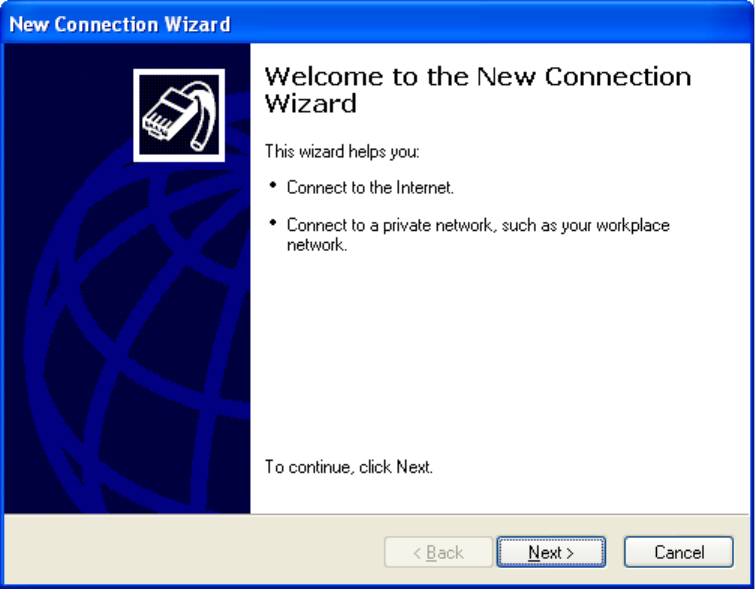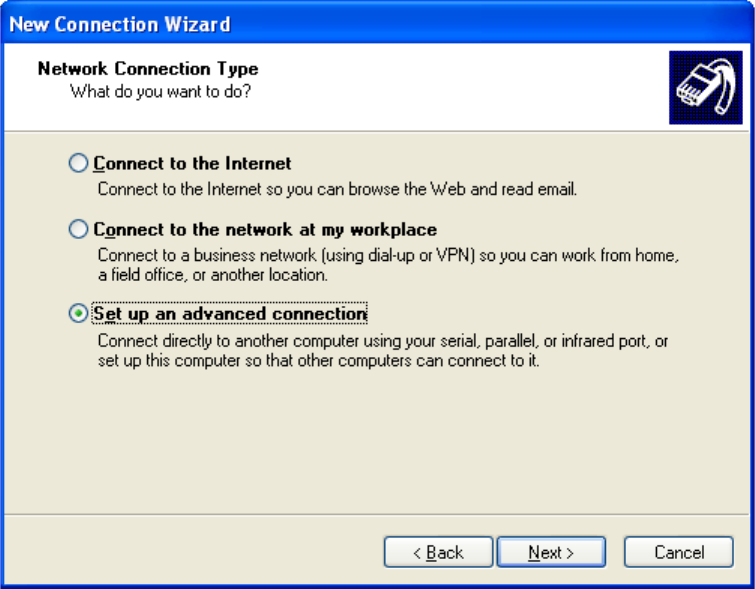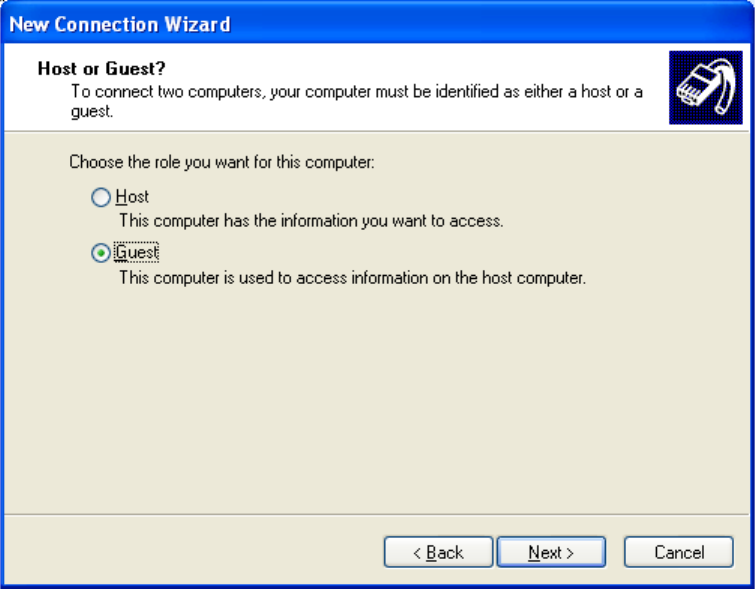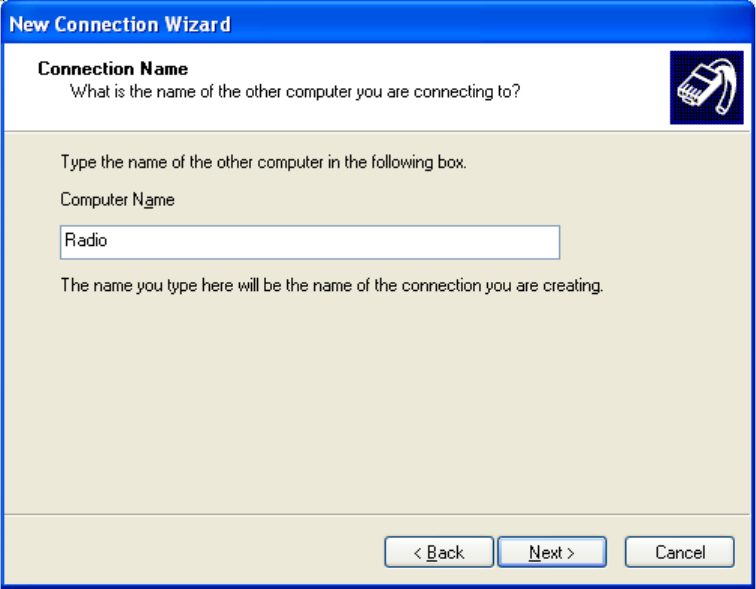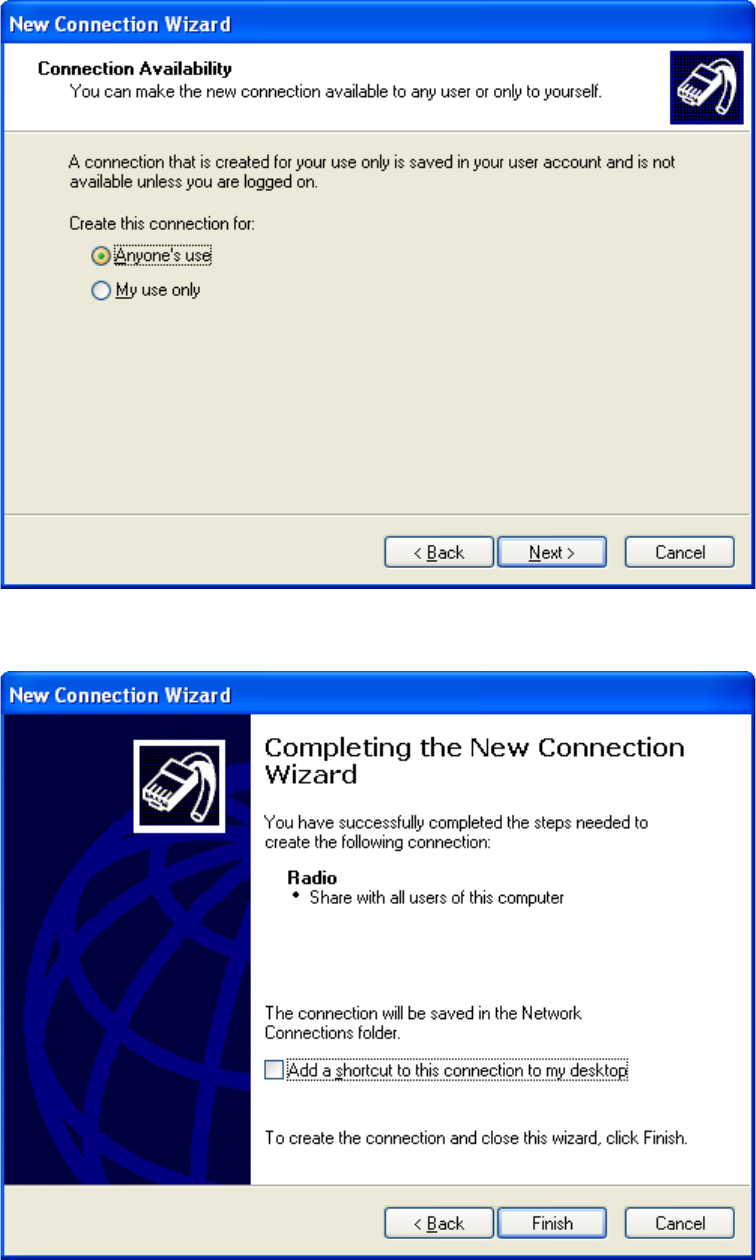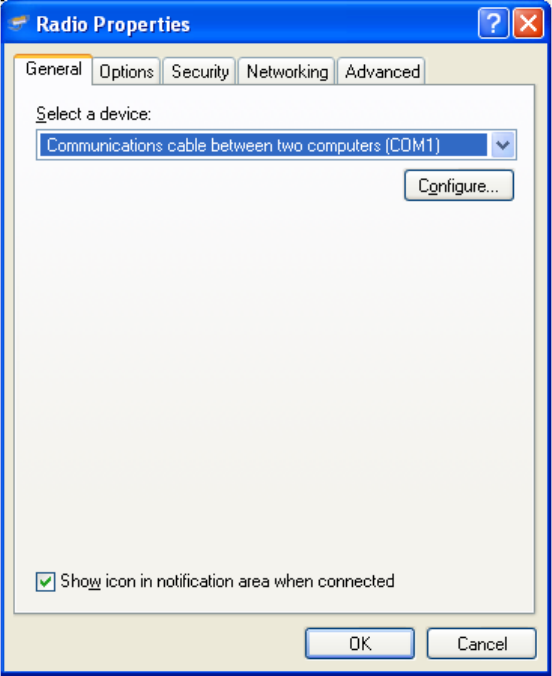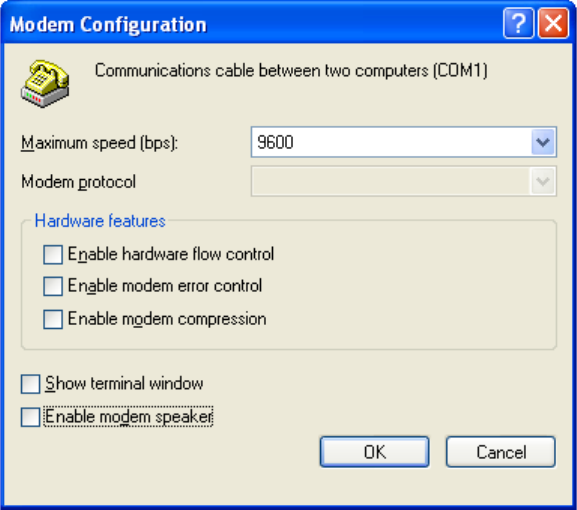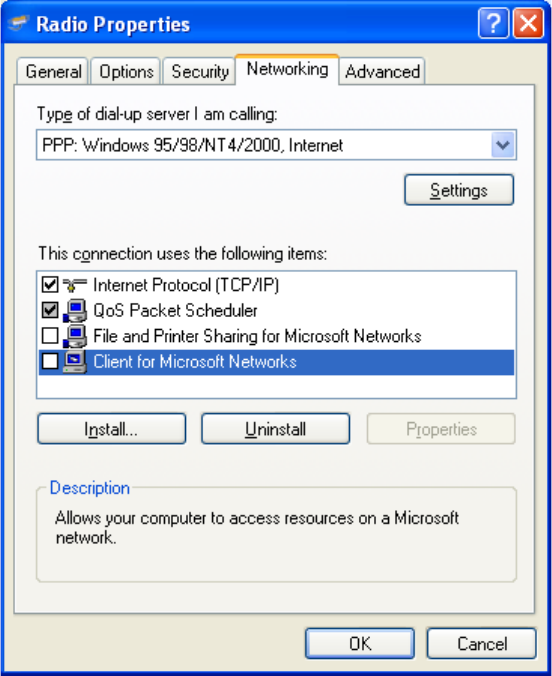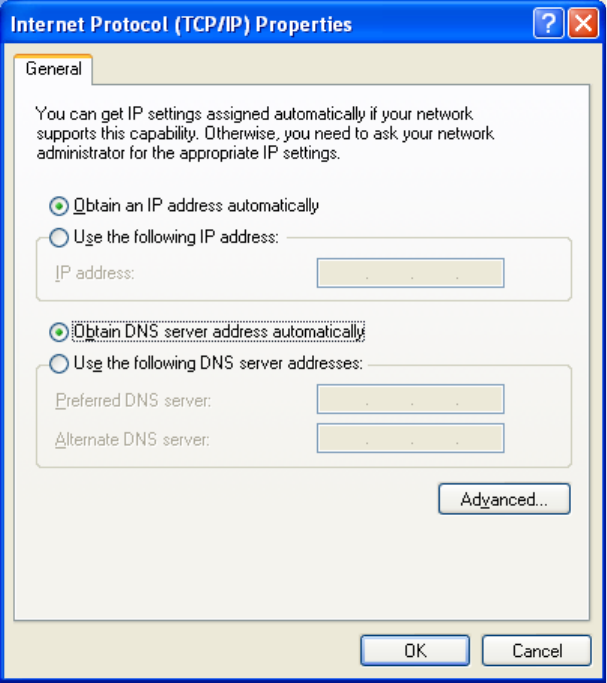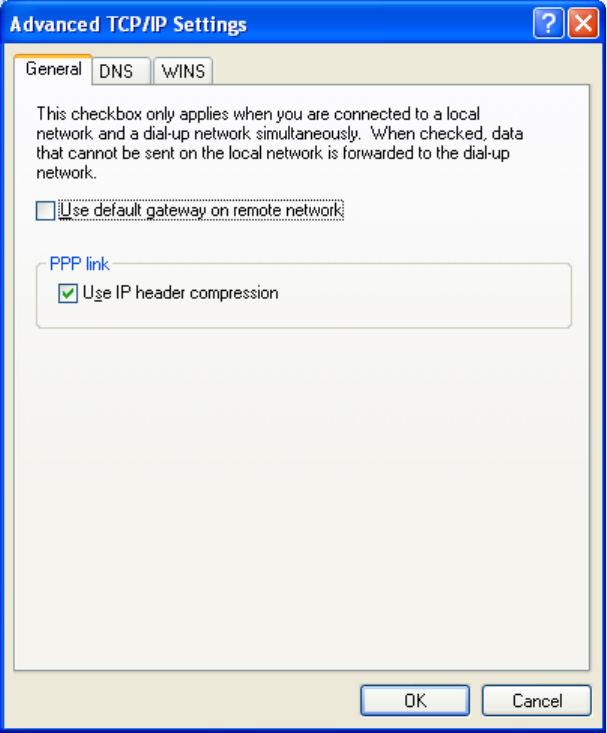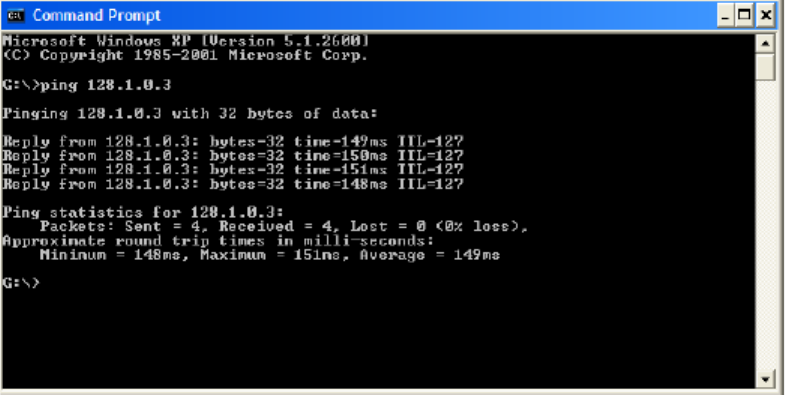E F Johnson 2425M70 VIKING MOBILE 700/800 MHz RADIO User Manual Viking VM600 Operating Manual
E. F. Johnson Company VIKING MOBILE 700/800 MHz RADIO Viking VM600 Operating Manual
User Manual

Viking® VM600 Series
Mobile Radio Operating Manual
Project 25 Conventional and Trunked
Conventional Analog and Digital
SMARTNET®/SmartZone®
Part Number 002-0600-05000
April 2014
Draft 4/29/2014
Copyright © 2014 by EF Johnson Technologies, Inc.
The EFJohnson Technologies logo, Armada™, Trunked IP25™, and Call Guard® are trademarks of
EFJohnson Technologies. All other company and/or product names used in this manual are trademarks and/
or registered trademarks of their respective manufacturers.
Information in this manual is subject to change without notice.
Viking VM600 Mobile Radio Operating Manual
April 2014
Draft 4/29/2014

Viking VM600 Mobile Radio Operating Manual i
Viking VM600 Mobile Radio Operating Manual
April 2014
Safety Information xiii
1 Radio Overview 1-1
Capabilities & Features . . . . . . . . . . . . . . . . . . . . . . . . . . . . . . . . . . . . . . . . . . . . . . . . . . . . . . . . . . 1-1
Radio Software and Configuration Programming. . . . . . . . . . . . . . . . . . . . . . . . . . . . . . . . . . . . . 1-3
Supported Software . . . . . . . . . . . . . . . . . . . . . . . . . . . . . . . . . . . . . . . . . . . . . . . . . . . . . . . . . . . . . 1-3
Available Options . . . . . . . . . . . . . . . . . . . . . . . . . . . . . . . . . . . . . . . . . . . . . . . . . . . . . . . . . . . . . . . 1-3
Licensing. . . . . . . . . . . . . . . . . . . . . . . . . . . . . . . . . . . . . . . . . . . . . . . . . . . . . . . . . . . . . . . . . . . . . . 1-4
Radio Accessories . . . . . . . . . . . . . . . . . . . . . . . . . . . . . . . . . . . . . . . . . . . . . . . . . . . . . . . . . . . . . . 1-5
Digital Keypad Microphone . . . . . . . . . . . . . . . . . . . . . . . . . . . . . . . . . . . . . . . . . . . . . . . . . . . . 1-5
Base Station Unit . . . . . . . . . . . . . . . . . . . . . . . . . . . . . . . . . . . . . . . . . . . . . . . . . . . . . . . . . . . 1-6
2 Controls & Display 2-1
Standard Control Head . . . . . . . . . . . . . . . . . . . . . . . . . . . . . . . . . . . . . . . . . . . . . . . . . . . . . . . . . . 2-1
Front Panel Controls. . . . . . . . . . . . . . . . . . . . . . . . . . . . . . . . . . . . . . . . . . . . . . . . . . . . . . . . . 2-1
Display . . . . . . . . . . . . . . . . . . . . . . . . . . . . . . . . . . . . . . . . . . . . . . . . . . . . . . . . . . . . . . . . . . . 2-3
Lightning Control Head . . . . . . . . . . . . . . . . . . . . . . . . . . . . . . . . . . . . . . . . . . . . . . . . . . . . . . . . . . 2-5
Front Panel Controls. . . . . . . . . . . . . . . . . . . . . . . . . . . . . . . . . . . . . . . . . . . . . . . . . . . . . . . . . 2-6
Display . . . . . . . . . . . . . . . . . . . . . . . . . . . . . . . . . . . . . . . . . . . . . . . . . . . . . . . . . . . . . . . . . . . 2-8
Rear Panel Connectors . . . . . . . . . . . . . . . . . . . . . . . . . . . . . . . . . . . . . . . . . . . . . . . . . . . . . . . . . 2-10
3 Dual Controls & External Speaker 3-1
Dual Control Configurations . . . . . . . . . . . . . . . . . . . . . . . . . . . . . . . . . . . . . . . . . . . . . . . . . . . . . . 3-1
Remote Conversion Kit 250-5300-002 . . . . . . . . . . . . . . . . . . . . . . . . . . . . . . . . . . . . . . . . . . . 3-2
Remote Control Head Kit 250-5300-003. . . . . . . . . . . . . . . . . . . . . . . . . . . . . . . . . . . . . . . . . . 3-2
Hardware Setup . . . . . . . . . . . . . . . . . . . . . . . . . . . . . . . . . . . . . . . . . . . . . . . . . . . . . . . . . . . . 3-3
Radio Programming using Armada. . . . . . . . . . . . . . . . . . . . . . . . . . . . . . . . . . . . . . . . . . . . . . 3-3
Programming Dual Remote Control Configurations . . . . . . . . . . . . . . . . . . . . . . . . . . . . . . . . . 3-3
Master / Slave Programming. . . . . . . . . . . . . . . . . . . . . . . . . . . . . . . . . . . . . . . . . . . . . . . . . . . 3-5
Table of Contents
Draft 4/29/2014

ii Viking VM600 Mobile Radio Operating Manual
Table of Contents (continued)
Dual Control Operation . . . . . . . . . . . . . . . . . . . . . . . . . . . . . . . . . . . . . . . . . . . . . . . . . . . . . . . 3-6
Power On/Off. . . . . . . . . . . . . . . . . . . . . . . . . . . . . . . . . . . . . . . . . . . . . . . . . . . . . . . . . . 3-6
Microphone Audio . . . . . . . . . . . . . . . . . . . . . . . . . . . . . . . . . . . . . . . . . . . . . . . . . . . . . . 3-6
External Speaker . . . . . . . . . . . . . . . . . . . . . . . . . . . . . . . . . . . . . . . . . . . . . . . . . . . . . . . . . . . . . . . 3-7
Internal / External Speaker Programming. . . . . . . . . . . . . . . . . . . . . . . . . . . . . . . . . . . . . . . . . 3-7
4 General Operation 4-1
Basic Operation . . . . . . . . . . . . . . . . . . . . . . . . . . . . . . . . . . . . . . . . . . . . . . . . . . . . . . . . . . . . . . . . 4-1
Turning Power ON and Setting Volume . . . . . . . . . . . . . . . . . . . . . . . . . . . . . . . . . . . . . . . . . . 4-1
Setting Volume Level. . . . . . . . . . . . . . . . . . . . . . . . . . . . . . . . . . . . . . . . . . . . . . . . . . . . 4-2
Standard and Soft Power Down . . . . . . . . . . . . . . . . . . . . . . . . . . . . . . . . . . . . . . . . . . . 4-2
Power-Up Password . . . . . . . . . . . . . . . . . . . . . . . . . . . . . . . . . . . . . . . . . . . . . . . . . . . . . . . . . 4-3
Programming Passwords . . . . . . . . . . . . . . . . . . . . . . . . . . . . . . . . . . . . . . . . . . . . . . . . 4-3
Lost Passwords . . . . . . . . . . . . . . . . . . . . . . . . . . . . . . . . . . . . . . . . . . . . . . . . . . . . . . . . 4-3
Changing Passwords. . . . . . . . . . . . . . . . . . . . . . . . . . . . . . . . . . . . . . . . . . . . . . . . . . . . 4-3
Password Entry Procedure . . . . . . . . . . . . . . . . . . . . . . . . . . . . . . . . . . . . . . . . . . . . . . . 4-4
User (Power-On) Passwords. . . . . . . . . . . . . . . . . . . . . . . . . . . . . . . . . . . . . . . . . . . . . . 4-4
Master Password. . . . . . . . . . . . . . . . . . . . . . . . . . . . . . . . . . . . . . . . . . . . . . . . . . . . . . . 4-4
Zone Password . . . . . . . . . . . . . . . . . . . . . . . . . . . . . . . . . . . . . . . . . . . . . . . . . . . . . . . . 4-4
Speaking into the Microphone. . . . . . . . . . . . . . . . . . . . . . . . . . . . . . . . . . . . . . . . . . . . . . . . . . 4-5
Display Backlight Control . . . . . . . . . . . . . . . . . . . . . . . . . . . . . . . . . . . . . . . . . . . . . . . . . . . . . 4-5
Display Viewing Angle and Contrast Adjust . . . . . . . . . . . . . . . . . . . . . . . . . . . . . . . . . . . . . . . 4-5
Zone / Channel Display and Select. . . . . . . . . . . . . . . . . . . . . . . . . . . . . . . . . . . . . . . . . . . . . . 4-6
Zone / Channel Display . . . . . . . . . . . . . . . . . . . . . . . . . . . . . . . . . . . . . . . . . . . . . . . . . . 4-6
Channel Lock Option. . . . . . . . . . . . . . . . . . . . . . . . . . . . . . . . . . . . . . . . . . . . . . . . . . . . 4-7
Zone / Channel Select . . . . . . . . . . . . . . . . . . . . . . . . . . . . . . . . . . . . . . . . . . . . . . . . . . 4-7
54-channel/16-zone Feature . . . . . . . . . . . . . . . . . . . . . . . . . . . . . . . . . . . . . . . . . . . . . . 4-8
Direct Channel Select . . . . . . . . . . . . . . . . . . . . . . . . . . . . . . . . . . . . . . . . . . . . . . . . . . . 4-8
Favorite Zone Selection. . . . . . . . . . . . . . . . . . . . . . . . . . . . . . . . . . . . . . . . . . . . . . . . . . 4-9
Setting Squelch Control . . . . . . . . . . . . . . . . . . . . . . . . . . . . . . . . . . . . . . . . . . . . . . . . . . . . . 4-10
Transmit Disable . . . . . . . . . . . . . . . . . . . . . . . . . . . . . . . . . . . . . . . . . . . . . . . . . . . . . . . . . . . 4-10
Operation At Extended Range . . . . . . . . . . . . . . . . . . . . . . . . . . . . . . . . . . . . . . . . . . . . . . . . 4-10
Preventing Vehicle Battery Discharge. . . . . . . . . . . . . . . . . . . . . . . . . . . . . . . . . . . . . . . . . . . 4-11
Cleaning the Control Head . . . . . . . . . . . . . . . . . . . . . . . . . . . . . . . . . . . . . . . . . . . . . . . . . . . 4-11
Radio Service . . . . . . . . . . . . . . . . . . . . . . . . . . . . . . . . . . . . . . . . . . . . . . . . . . . . . . . . . . . . . 4-12
Operating Modes . . . . . . . . . . . . . . . . . . . . . . . . . . . . . . . . . . . . . . . . . . . . . . . . . . . . . . . . . . . . . . 4-13
Conventional Mode. . . . . . . . . . . . . . . . . . . . . . . . . . . . . . . . . . . . . . . . . . . . . . . . . . . . . . . . . 4-13
SMARTNET / SmartZone Mode . . . . . . . . . . . . . . . . . . . . . . . . . . . . . . . . . . . . . . . . . . . . . . . 4-13
P25 Trunked Mode . . . . . . . . . . . . . . . . . . . . . . . . . . . . . . . . . . . . . . . . . . . . . . . . . . . . . . . . . 4-14
Systems, Channels, and Zones . . . . . . . . . . . . . . . . . . . . . . . . . . . . . . . . . . . . . . . . . . . . . . . 4-15
Systems. . . . . . . . . . . . . . . . . . . . . . . . . . . . . . . . . . . . . . . . . . . . . . . . . . . . . . . . . . . . . 4-15
Channels . . . . . . . . . . . . . . . . . . . . . . . . . . . . . . . . . . . . . . . . . . . . . . . . . . . . . . . . . . . . 4-15
Zones. . . . . . . . . . . . . . . . . . . . . . . . . . . . . . . . . . . . . . . . . . . . . . . . . . . . . . . . . . . . . . . 4-16
5 Radio Wide Features 5-1
Option Buttons . . . . . . . . . . . . . . . . . . . . . . . . . . . . . . . . . . . . . . . . . . . . . . . . . . . . . . . . . . . . . . . . . 5-1
Menu Mode . . . . . . . . . . . . . . . . . . . . . . . . . . . . . . . . . . . . . . . . . . . . . . . . . . . . . . . . . . . . . . . . . . . . 5-3
Draft 4/29/2014

Viking VM600 Mobile Radio Operating Manual iii
Table of Contents (continued)
Time-Out Timer. . . . . . . . . . . . . . . . . . . . . . . . . . . . . . . . . . . . . . . . . . . . . . . . . . . . . . . . . . . . . . . . . 5-4
Home Channel Select. . . . . . . . . . . . . . . . . . . . . . . . . . . . . . . . . . . . . . . . . . . . . . . . . . . . . . . . . . . . 5-4
Power Output Select . . . . . . . . . . . . . . . . . . . . . . . . . . . . . . . . . . . . . . . . . . . . . . . . . . . . . . . . . . . . 5-4
Alert Tone Select. . . . . . . . . . . . . . . . . . . . . . . . . . . . . . . . . . . . . . . . . . . . . . . . . . . . . . . . . . . . . . . . 5-5
Power Turn-Off Delay. . . . . . . . . . . . . . . . . . . . . . . . . . . . . . . . . . . . . . . . . . . . . . . . . . . . . . . . . . . . 5-5
Horn Alert . . . . . . . . . . . . . . . . . . . . . . . . . . . . . . . . . . . . . . . . . . . . . . . . . . . . . . . . . . . . . . . . . . . . . 5-6
Microphone Off-Hook Detect. . . . . . . . . . . . . . . . . . . . . . . . . . . . . . . . . . . . . . . . . . . . . . . . . . . . . . 5-6
Surveillance Mode . . . . . . . . . . . . . . . . . . . . . . . . . . . . . . . . . . . . . . . . . . . . . . . . . . . . . . . . . . . . . . 5-7
Public Address . . . . . . . . . . . . . . . . . . . . . . . . . . . . . . . . . . . . . . . . . . . . . . . . . . . . . . . . . . . . . . . . . 5-7
Scanning . . . . . . . . . . . . . . . . . . . . . . . . . . . . . . . . . . . . . . . . . . . . . . . . . . . . . . . . . . . . . . . . . . . . . . 5-8
Priority (Standard) Scanning. . . . . . . . . . . . . . . . . . . . . . . . . . . . . . . . . . . . . . . . . . . . . . . . . . . 5-8
Radio Wide Scanning . . . . . . . . . . . . . . . . . . . . . . . . . . . . . . . . . . . . . . . . . . . . . . . . . . . . . . . . 5-9
Scan Hold Time. . . . . . . . . . . . . . . . . . . . . . . . . . . . . . . . . . . . . . . . . . . . . . . . . . . . . . . . . . . . . 5-9
Transmitting in the Scan Mode . . . . . . . . . . . . . . . . . . . . . . . . . . . . . . . . . . . . . . . . . . . . . . . . . 5-9
Nuisance Channel Delete . . . . . . . . . . . . . . . . . . . . . . . . . . . . . . . . . . . . . . . . . . . . . . . . . . . . 5-10
Scan Lists . . . . . . . . . . . . . . . . . . . . . . . . . . . . . . . . . . . . . . . . . . . . . . . . . . . . . . . . . . . . . . . . . . . . 5-11
Priority Mode Scan Lists . . . . . . . . . . . . . . . . . . . . . . . . . . . . . . . . . . . . . . . . . . . . . . . . . . . . 5-11
Determining Channels in Priority Scan List . . . . . . . . . . . . . . . . . . . . . . . . . . . . . . . . . . 5-11
Selecting a Priority Scan List. . . . . . . . . . . . . . . . . . . . . . . . . . . . . . . . . . . . . . . . . . . . . 5-11
Editing a Priority Scan List. . . . . . . . . . . . . . . . . . . . . . . . . . . . . . . . . . . . . . . . . . . . . . . 5-12
Radio Wide Scan List . . . . . . . . . . . . . . . . . . . . . . . . . . . . . . . . . . . . . . . . . . . . . . . . . . . . . . . 5-13
Determining Channels in Radio Wide Scan List . . . . . . . . . . . . . . . . . . . . . . . . . . . . . . 5-13
Editing a Radio Wide Scan List . . . . . . . . . . . . . . . . . . . . . . . . . . . . . . . . . . . . . . . . . . . 5-13
Global Positioning System (GPS). . . . . . . . . . . . . . . . . . . . . . . . . . . . . . . . . . . . . . . . . . . . . . . . . 5-14
Viewing GPS Data . . . . . . . . . . . . . . . . . . . . . . . . . . . . . . . . . . . . . . . . . . . . . . . . . . . . . . . . . 5-14
Sending GPS Data . . . . . . . . . . . . . . . . . . . . . . . . . . . . . . . . . . . . . . . . . . . . . . . . . . . . . . . . . 5-15
Over the Air Programming. . . . . . . . . . . . . . . . . . . . . . . . . . . . . . . . . . . . . . . . . . . . . . . . . . . . . . . 5-15
Radio Set Up . . . . . . . . . . . . . . . . . . . . . . . . . . . . . . . . . . . . . . . . . . . . . . . . . . . . . . . . . . . . . 5-15
OTAP Transfer Times . . . . . . . . . . . . . . . . . . . . . . . . . . . . . . . . . . . . . . . . . . . . . . . . . . . . . . . 5-16
6 Conventional Features 6-1
Monitoring Before Transmitting . . . . . . . . . . . . . . . . . . . . . . . . . . . . . . . . . . . . . . . . . . . . . . . . . . . 6-1
Automatic Channel Monitoring . . . . . . . . . . . . . . . . . . . . . . . . . . . . . . . . . . . . . . . . . . . . . . . . . 6-1
Manual Channel Monitoring . . . . . . . . . . . . . . . . . . . . . . . . . . . . . . . . . . . . . . . . . . . . . . . . . . . 6-1
Monitor Mode . . . . . . . . . . . . . . . . . . . . . . . . . . . . . . . . . . . . . . . . . . . . . . . . . . . . . . . . . . . . . . . . . . 6-2
Busy Channel Lockout. . . . . . . . . . . . . . . . . . . . . . . . . . . . . . . . . . . . . . . . . . . . . . . . . . . . . . . . . . . 6-3
Call Guard Squelch . . . . . . . . . . . . . . . . . . . . . . . . . . . . . . . . . . . . . . . . . . . . . . . . . . . . . . . . . . . . . 6-3
Call Guard Squelch Enable / Disable . . . . . . . . . . . . . . . . . . . . . . . . . . . . . . . . . . . . . . . . . . . . 6-4
Tone Call Guard Squelch . . . . . . . . . . . . . . . . . . . . . . . . . . . . . . . . . . . . . . . . . . . . . . . . . . . . . 6-4
Digital Call Guard Squelch . . . . . . . . . . . . . . . . . . . . . . . . . . . . . . . . . . . . . . . . . . . . . . . . . . . . 6-4
Disable Call Guard . . . . . . . . . . . . . . . . . . . . . . . . . . . . . . . . . . . . . . . . . . . . . . . . . . . . . . . . . . 6-5
Selective Squelch Code Select (CTCSS / DSC / NAC) . . . . . . . . . . . . . . . . . . . . . . . . . . . . . . 6-5
Draft 4/29/2014
iv Viking VM600 Mobile Radio Operating Manual
Table of Contents (continued)
Penalty Timer . . . . . . . . . . . . . . . . . . . . . . . . . . . . . . . . . . . . . . . . . . . . . . . . . . . . . . . . . . . . . . . . . . 6-6
Conversation Timer . . . . . . . . . . . . . . . . . . . . . . . . . . . . . . . . . . . . . . . . . . . . . . . . . . . . . . . . . . . . . 6-6
Repeater Talk-Around . . . . . . . . . . . . . . . . . . . . . . . . . . . . . . . . . . . . . . . . . . . . . . . . . . . . . . . . . . . 6-7
Displaying Transmit / Receive Frequency . . . . . . . . . . . . . . . . . . . . . . . . . . . . . . . . . . . . . . . . . . . 6-7
Emergency Alarm and Call . . . . . . . . . . . . . . . . . . . . . . . . . . . . . . . . . . . . . . . . . . . . . . . . . . . . . . . 6-8
Emergency Alarms . . . . . . . . . . . . . . . . . . . . . . . . . . . . . . . . . . . . . . . . . . . . . . . . . . . . . . . . . . 6-8
Emergency Call Alert . . . . . . . . . . . . . . . . . . . . . . . . . . . . . . . . . . . . . . . . . . . . . . . . . . . . . . . . 6-9
Emergency Calls. . . . . . . . . . . . . . . . . . . . . . . . . . . . . . . . . . . . . . . . . . . . . . . . . . . . . . . . . . . . 6-9
Emergency Hot Mic . . . . . . . . . . . . . . . . . . . . . . . . . . . . . . . . . . . . . . . . . . . . . . . . . . . . . 6-9
Placing an Emergency Call . . . . . . . . . . . . . . . . . . . . . . . . . . . . . . . . . . . . . . . . . . . . . . . 6-9
Conventional Mode Channel Scanning . . . . . . . . . . . . . . . . . . . . . . . . . . . . . . . . . . . . . . . . . . . . 6-10
Selecting a Scan List. . . . . . . . . . . . . . . . . . . . . . . . . . . . . . . . . . . . . . . . . . . . . . . . . . . . . . . . 6-10
Conventional Scan List Select Procedure . . . . . . . . . . . . . . . . . . . . . . . . . . . . . . . . . . . 6-10
Transmitting in Scan Mode . . . . . . . . . . . . . . . . . . . . . . . . . . . . . . . . . . . . . . . . . . . . . . . . . . . 6-11
Priority Channel Sampling. . . . . . . . . . . . . . . . . . . . . . . . . . . . . . . . . . . . . . . . . . . . . . . . . . . . 6-11
Changing The Priority Channel . . . . . . . . . . . . . . . . . . . . . . . . . . . . . . . . . . . . . . . . . . . 6-12
Talkgroup Scanning. . . . . . . . . . . . . . . . . . . . . . . . . . . . . . . . . . . . . . . . . . . . . . . . . . . . . . . . . 6-13
Standard Conventional Calls. . . . . . . . . . . . . . . . . . . . . . . . . . . . . . . . . . . . . . . . . . . . . . . . . . . . . 6-13
Placing a Standard Conventional Call. . . . . . . . . . . . . . . . . . . . . . . . . . . . . . . . . . . . . . . . . . . 6-14
Receiving a Standard Conventional Call. . . . . . . . . . . . . . . . . . . . . . . . . . . . . . . . . . . . . . . . . 6-14
DTMF / ANI Signaling . . . . . . . . . . . . . . . . . . . . . . . . . . . . . . . . . . . . . . . . . . . . . . . . . . . . . . . . . . . 6-14
Single Tone Encoder. . . . . . . . . . . . . . . . . . . . . . . . . . . . . . . . . . . . . . . . . . . . . . . . . . . . . . . . 6-15
Five Tone Encoder . . . . . . . . . . . . . . . . . . . . . . . . . . . . . . . . . . . . . . . . . . . . . . . . . . . . . . . . . 6-15
MDC1200 Compatibility . . . . . . . . . . . . . . . . . . . . . . . . . . . . . . . . . . . . . . . . . . . . . . . . . . . . . 6-15
Project 25 Mode Features . . . . . . . . . . . . . . . . . . . . . . . . . . . . . . . . . . . . . . . . . . . . . . . . . . . . . . . 6-16
Digital Unit ID . . . . . . . . . . . . . . . . . . . . . . . . . . . . . . . . . . . . . . . . . . . . . . . . . . . . . . . . . . . . . 6-16
Talkgroup ID . . . . . . . . . . . . . . . . . . . . . . . . . . . . . . . . . . . . . . . . . . . . . . . . . . . . . . . . . . . . . . 6-16
Network Access Code (NAC) . . . . . . . . . . . . . . . . . . . . . . . . . . . . . . . . . . . . . . . . . . . . . . . . . 6-16
EFJohnson System Out of Range Indicator . . . . . . . . . . . . . . . . . . . . . . . . . . . . . . . . . . . . . . 6-16
EFJohnson System Automatic Registration . . . . . . . . . . . . . . . . . . . . . . . . . . . . . . . . . . . . . . 6-17
P25 Group Calls . . . . . . . . . . . . . . . . . . . . . . . . . . . . . . . . . . . . . . . . . . . . . . . . . . . . . . . . . . . 6-17
Changing Talkgroup Assigned To a Channel. . . . . . . . . . . . . . . . . . . . . . . . . . . . . . . . . 6-17
P25 Unit Calls . . . . . . . . . . . . . . . . . . . . . . . . . . . . . . . . . . . . . . . . . . . . . . . . . . . . . . . . . . . . . 6-18
P25 Conventional Telephone Calls . . . . . . . . . . . . . . . . . . . . . . . . . . . . . . . . . . . . . . . . . . . . . 6-18
Access / De-Access Codes . . . . . . . . . . . . . . . . . . . . . . . . . . . . . . . . . . . . . . . . . . . . . . 6-19
Placing a Telephone Call. . . . . . . . . . . . . . . . . . . . . . . . . . . . . . . . . . . . . . . . . . . . . . . . 6-19
Answering a Telephone Call . . . . . . . . . . . . . . . . . . . . . . . . . . . . . . . . . . . . . . . . . . . . . 6-20
Call Alert . . . . . . . . . . . . . . . . . . . . . . . . . . . . . . . . . . . . . . . . . . . . . . . . . . . . . . . . . . . . . . . . . 6-20
Call History . . . . . . . . . . . . . . . . . . . . . . . . . . . . . . . . . . . . . . . . . . . . . . . . . . . . . . . . . . . . . . . 6-21
Messaging. . . . . . . . . . . . . . . . . . . . . . . . . . . . . . . . . . . . . . . . . . . . . . . . . . . . . . . . . . . . . . . . 6-22
Status Messaging . . . . . . . . . . . . . . . . . . . . . . . . . . . . . . . . . . . . . . . . . . . . . . . . . . . . . . . . . . 6-22
P25 Packet Data. . . . . . . . . . . . . . . . . . . . . . . . . . . . . . . . . . . . . . . . . . . . . . . . . . . . . . . . . . . 6-23
Keypad Programming . . . . . . . . . . . . . . . . . . . . . . . . . . . . . . . . . . . . . . . . . . . . . . . . . . . . . . . . . . 6-23
Menu Structure . . . . . . . . . . . . . . . . . . . . . . . . . . . . . . . . . . . . . . . . . . . . . . . . . . . . . . . . . . . . 6-23
Zone Password. . . . . . . . . . . . . . . . . . . . . . . . . . . . . . . . . . . . . . . . . . . . . . . . . . . . . . . . . . . . 6-24
Zone Change Parameter. . . . . . . . . . . . . . . . . . . . . . . . . . . . . . . . . . . . . . . . . . . . . . . . . . . . . 6-25
Channel Change Parameter . . . . . . . . . . . . . . . . . . . . . . . . . . . . . . . . . . . . . . . . . . . . . . . . . . 6-25
System Parameters. . . . . . . . . . . . . . . . . . . . . . . . . . . . . . . . . . . . . . . . . . . . . . . . . . . . . . . . . 6-25
Channel Parameters . . . . . . . . . . . . . . . . . . . . . . . . . . . . . . . . . . . . . . . . . . . . . . . . . . . . . . . . 6-26
Draft 4/29/2014

Viking VM600 Mobile Radio Operating Manual v
Table of Contents (continued)
Text Messaging. . . . . . . . . . . . . . . . . . . . . . . . . . . . . . . . . . . . . . . . . . . . . . . . . . . . . . . . . . . . . . . . 6-28
Data Setup for Text Messaging. . . . . . . . . . . . . . . . . . . . . . . . . . . . . . . . . . . . . . . . . . . . . . . . 6-28
Receiving a Text Message . . . . . . . . . . . . . . . . . . . . . . . . . . . . . . . . . . . . . . . . . . . . . . . . . . . 6-29
Viewing Previously Received Messages. . . . . . . . . . . . . . . . . . . . . . . . . . . . . . . . . . . . . . . . . 6-29
Sending Global Positioning System (GPS) Data. . . . . . . . . . . . . . . . . . . . . . . . . . . . . . . . . . . . . 6-30
Manually Sending GPS Data . . . . . . . . . . . . . . . . . . . . . . . . . . . . . . . . . . . . . . . . . . . . . . . . . 6-30
Automatically Sending GPS Data . . . . . . . . . . . . . . . . . . . . . . . . . . . . . . . . . . . . . . . . . . . . . . 6-30
Sending GPS Data in Response to System Request . . . . . . . . . . . . . . . . . . . . . . . . . . . . . . . 6-31
7 SMARTNET / SmartZone / P25 Trunked Features 7-1
Analog and Digital Operation . . . . . . . . . . . . . . . . . . . . . . . . . . . . . . . . . . . . . . . . . . . . . . . . . . . . . 7-1
Viewing Unit ID . . . . . . . . . . . . . . . . . . . . . . . . . . . . . . . . . . . . . . . . . . . . . . . . . . . . . . . . . . . . . . . . . 7-1
Radio Info Button . . . . . . . . . . . . . . . . . . . . . . . . . . . . . . . . . . . . . . . . . . . . . . . . . . . . . . . . . . . 7-2
Standard Group Calls. . . . . . . . . . . . . . . . . . . . . . . . . . . . . . . . . . . . . . . . . . . . . . . . . . . . . . . . . . . . 7-2
Placing a Standard Group Call . . . . . . . . . . . . . . . . . . . . . . . . . . . . . . . . . . . . . . . . . . . . . . . . . 7-2
Receiving a Standard Group Call . . . . . . . . . . . . . . . . . . . . . . . . . . . . . . . . . . . . . . . . . . . . . . . 7-4
Private (Unit-To-Unit) Calls . . . . . . . . . . . . . . . . . . . . . . . . . . . . . . . . . . . . . . . . . . . . . . . . . . . . . . . 7-4
Placing an Enhanced Private Conversation Call. . . . . . . . . . . . . . . . . . . . . . . . . . . . . . . . . . . . 7-5
Placing a Standard Private Conversation Call . . . . . . . . . . . . . . . . . . . . . . . . . . . . . . . . . . . . . 7-6
Receiving a Private Call (All Types) . . . . . . . . . . . . . . . . . . . . . . . . . . . . . . . . . . . . . . . . . . . . . 7-7
Telephone Calls . . . . . . . . . . . . . . . . . . . . . . . . . . . . . . . . . . . . . . . . . . . . . . . . . . . . . . . . . . . . . . . . 7-7
Placing a Telephone Call. . . . . . . . . . . . . . . . . . . . . . . . . . . . . . . . . . . . . . . . . . . . . . . . . . . . . . 7-8
Receiving A Telephone Call . . . . . . . . . . . . . . . . . . . . . . . . . . . . . . . . . . . . . . . . . . . . . . . . . . . 7-9
Call Alert . . . . . . . . . . . . . . . . . . . . . . . . . . . . . . . . . . . . . . . . . . . . . . . . . . . . . . . . . . . . . . . . . . . . . . 7-9
Answering a Page. . . . . . . . . . . . . . . . . . . . . . . . . . . . . . . . . . . . . . . . . . . . . . . . . . . . . . . . . . 7-10
Initiating a Page . . . . . . . . . . . . . . . . . . . . . . . . . . . . . . . . . . . . . . . . . . . . . . . . . . . . . . . . . . . 7-10
Messaging. . . . . . . . . . . . . . . . . . . . . . . . . . . . . . . . . . . . . . . . . . . . . . . . . . . . . . . . . . . . . . . . . . . . 7-11
Sending Status Conditions . . . . . . . . . . . . . . . . . . . . . . . . . . . . . . . . . . . . . . . . . . . . . . . . . . . . . . 7-11
Emergency Alarm and Call . . . . . . . . . . . . . . . . . . . . . . . . . . . . . . . . . . . . . . . . . . . . . . . . . . . . . . 7-12
Emergency Alarms . . . . . . . . . . . . . . . . . . . . . . . . . . . . . . . . . . . . . . . . . . . . . . . . . . . . . . . . . 7-12
Emergency Call Alert . . . . . . . . . . . . . . . . . . . . . . . . . . . . . . . . . . . . . . . . . . . . . . . . . . . . . . . 7-13
Emergency Calls. . . . . . . . . . . . . . . . . . . . . . . . . . . . . . . . . . . . . . . . . . . . . . . . . . . . . . . . . . . 7-13
Emergency Hot Mic . . . . . . . . . . . . . . . . . . . . . . . . . . . . . . . . . . . . . . . . . . . . . . . . . . . . 7-14
Placing an Emergency Call . . . . . . . . . . . . . . . . . . . . . . . . . . . . . . . . . . . . . . . . . . . . . . 7-14
Failsoft Operation. . . . . . . . . . . . . . . . . . . . . . . . . . . . . . . . . . . . . . . . . . . . . . . . . . . . . . . . . . . . . . 7-15
Programmable Failsoft Connect Tone. . . . . . . . . . . . . . . . . . . . . . . . . . . . . . . . . . . . . . . . . . . 7-15
SMARTNET / SmartZone / P25 Trunked Scanning Features . . . . . . . . . . . . . . . . . . . . . . . . . . . 7-15
Priority Talkgroup Sampling . . . . . . . . . . . . . . . . . . . . . . . . . . . . . . . . . . . . . . . . . . . . . . . . . . 7-17
Scan List Editing and Selection. . . . . . . . . . . . . . . . . . . . . . . . . . . . . . . . . . . . . . . . . . . . . . . . 7-17
Dynamic Regrouping . . . . . . . . . . . . . . . . . . . . . . . . . . . . . . . . . . . . . . . . . . . . . . . . . . . . . . . . . . . 7-18
SmartZone and P25 Trunking Unique Features. . . . . . . . . . . . . . . . . . . . . . . . . . . . . . . . . . . . . . 7-19
Busy Override . . . . . . . . . . . . . . . . . . . . . . . . . . . . . . . . . . . . . . . . . . . . . . . . . . . . . . . . . . . . . 7-19
Site Trunking. . . . . . . . . . . . . . . . . . . . . . . . . . . . . . . . . . . . . . . . . . . . . . . . . . . . . . . . . . . . . . 7-19
Determining Current Site and Searching for a New Site. . . . . . . . . . . . . . . . . . . . . . . . . . . . . 7-20
Draft 4/29/2014

vi Viking VM600 Mobile Radio Operating Manual
Table of Contents (continued)
Locking / Unlocking a Site. . . . . . . . . . . . . . . . . . . . . . . . . . . . . . . . . . . . . . . . . . . . . . . . . . . . 7-20
Auto Site Search. . . . . . . . . . . . . . . . . . . . . . . . . . . . . . . . . . . . . . . . . . . . . . . . . . . . . . . . . . . 7-20
ZoneFail Site Lock . . . . . . . . . . . . . . . . . . . . . . . . . . . . . . . . . . . . . . . . . . . . . . . . . . . . . . . . . 7-20
P25 Wide Area Scan. . . . . . . . . . . . . . . . . . . . . . . . . . . . . . . . . . . . . . . . . . . . . . . . . . . . . . . . 7-21
Normal P25 and SmartZone Control Channel Hunt . . . . . . . . . . . . . . . . . . . . . . . . . . . . . . . . 7-21
Talkgroup Steering through System Access Permissions. . . . . . . . . . . . . . . . . . . . . . . . . . . . 7-21
P25 Wide Area Scan. . . . . . . . . . . . . . . . . . . . . . . . . . . . . . . . . . . . . . . . . . . . . . . . . . . . . . . . 7-22
Radio Information . . . . . . . . . . . . . . . . . . . . . . . . . . . . . . . . . . . . . . . . . . . . . . . . . . . . . . . . . . 7-23
8 Secure Communication (Encryption) 8-1
Encryption Algorithms. . . . . . . . . . . . . . . . . . . . . . . . . . . . . . . . . . . . . . . . . . . . . . . . . . . . . . . . . . . 8-1
SecureNet™ . . . . . . . . . . . . . . . . . . . . . . . . . . . . . . . . . . . . . . . . . . . . . . . . . . . . . . . . . . . . . . . 8-1
AES (Advanced Encryption Standard) . . . . . . . . . . . . . . . . . . . . . . . . . . . . . . . . . . . . . . . . . . . 8-2
Encryption Available With Various Channel Types . . . . . . . . . . . . . . . . . . . . . . . . . . . . . . . . . . 8-2
FIPS and Non-FIPS Modes. . . . . . . . . . . . . . . . . . . . . . . . . . . . . . . . . . . . . . . . . . . . . . . . . . . . 8-2
Encryption Keys . . . . . . . . . . . . . . . . . . . . . . . . . . . . . . . . . . . . . . . . . . . . . . . . . . . . . . . . . . . . . . . . 8-2
Key and Algorithm IDs . . . . . . . . . . . . . . . . . . . . . . . . . . . . . . . . . . . . . . . . . . . . . . . . . . . . . . . 8-3
PID / SLN Key Management Modes. . . . . . . . . . . . . . . . . . . . . . . . . . . . . . . . . . . . . . . . . . . . . 8-3
Maintaining Keys in Memory. . . . . . . . . . . . . . . . . . . . . . . . . . . . . . . . . . . . . . . . . . . . . . . . . . . 8-4
Encryption Key Select. . . . . . . . . . . . . . . . . . . . . . . . . . . . . . . . . . . . . . . . . . . . . . . . . . . . . . . . 8-4
Encryption Key Erase . . . . . . . . . . . . . . . . . . . . . . . . . . . . . . . . . . . . . . . . . . . . . . . . . . . . . . . . 8-5
Encryption Icon Operation. . . . . . . . . . . . . . . . . . . . . . . . . . . . . . . . . . . . . . . . . . . . . . . . . . . . . 8-5
Clear / Secure Strapping . . . . . . . . . . . . . . . . . . . . . . . . . . . . . . . . . . . . . . . . . . . . . . . . . . . . . . . . . 8-5
Transmit Mode Options. . . . . . . . . . . . . . . . . . . . . . . . . . . . . . . . . . . . . . . . . . . . . . . . . . . . . . . 8-5
Analog Receive Mode Options . . . . . . . . . . . . . . . . . . . . . . . . . . . . . . . . . . . . . . . . . . . . . . . . . 8-6
Security Settings Override . . . . . . . . . . . . . . . . . . . . . . . . . . . . . . . . . . . . . . . . . . . . . . . . . . . . . . . 8-7
Conventional (P25) Talkgroup Security Override . . . . . . . . . . . . . . . . . . . . . . . . . . . . . . . . . . . 8-7
Secure Call Behavior . . . . . . . . . . . . . . . . . . . . . . . . . . . . . . . . . . . . . . . . . . . . . . . . . . . . . . . . 8-7
Failsoft, Group Regroup or Dynamic Regroup Call. . . . . . . . . . . . . . . . . . . . . . . . . . . . . 8-7
Channel with only a Talkgroup Specified. . . . . . . . . . . . . . . . . . . . . . . . . . . . . . . . . . . . . 8-7
Channel with both a Talkgroup and Announcement Group Specified . . . . . . . . . . . . . . . 8-8
Channel with only an Announcement Group Specified . . . . . . . . . . . . . . . . . . . . . . . . . . 8-8
Announcement Group Call . . . . . . . . . . . . . . . . . . . . . . . . . . . . . . . . . . . . . . . . . . . . . . . 8-8
Emergency Calls on Emergency Groups. . . . . . . . . . . . . . . . . . . . . . . . . . . . . . . . . . . . . 8-8
Scan Mode Behavior. . . . . . . . . . . . . . . . . . . . . . . . . . . . . . . . . . . . . . . . . . . . . . . . . . . . . . . . . 8-8
Over-The-Air Rekeying (OTAR) . . . . . . . . . . . . . . . . . . . . . . . . . . . . . . . . . . . . . . . . . . . . . . . . . . . 8-10
Encryption Key Types . . . . . . . . . . . . . . . . . . . . . . . . . . . . . . . . . . . . . . . . . . . . . . . . . . . . . . . 8-10
Keysets . . . . . . . . . . . . . . . . . . . . . . . . . . . . . . . . . . . . . . . . . . . . . . . . . . . . . . . . . . . . . . . . . . 8-10
Key Management Facility . . . . . . . . . . . . . . . . . . . . . . . . . . . . . . . . . . . . . . . . . . . . . . . . . . . . 8-11
Message Number Period (MNP). . . . . . . . . . . . . . . . . . . . . . . . . . . . . . . . . . . . . . . . . . . . . . . 8-12
Definitions . . . . . . . . . . . . . . . . . . . . . . . . . . . . . . . . . . . . . . . . . . . . . . . . . . . . . . . . . . . . . . . . 8-12
Radio Setup For Encryption . . . . . . . . . . . . . . . . . . . . . . . . . . . . . . . . . . . . . . . . . . . . . . . . . . . . . 8-15
Motorola Third Party RNC Registration. . . . . . . . . . . . . . . . . . . . . . . . . . . . . . . . . . . . . 8-15
Programming By Keyloader. . . . . . . . . . . . . . . . . . . . . . . . . . . . . . . . . . . . . . . . . . . . . . 8-16
Radio OTAR Capabilities . . . . . . . . . . . . . . . . . . . . . . . . . . . . . . . . . . . . . . . . . . . . . . . . . . . . . . . . 8-16
OTAR Option Switches . . . . . . . . . . . . . . . . . . . . . . . . . . . . . . . . . . . . . . . . . . . . . . . . . . . . . . 8-17
P25 Trunking Icons . . . . . . . . . . . . . . . . . . . . . . . . . . . . . . . . . . . . . . . . . . . . . . . . . . . . . . . . . 8-18
Draft 4/29/2014

Viking VM600 Mobile Radio Operating Manual vii
Table of Contents (continued)
9 Data Features 9-1
P25 Packet Data . . . . . . . . . . . . . . . . . . . . . . . . . . . . . . . . . . . . . . . . . . . . . . . . . . . . . . . . . . . . . . . . 9-1
P25 Trunking Data Services . . . . . . . . . . . . . . . . . . . . . . . . . . . . . . . . . . . . . . . . . . . . . . . . . . . . . . 9-2
Radio Configuration . . . . . . . . . . . . . . . . . . . . . . . . . . . . . . . . . . . . . . . . . . . . . . . . . . . . . . . . . 9-2
Interface Connection. . . . . . . . . . . . . . . . . . . . . . . . . . . . . . . . . . . . . . . . . . . . . . . . . . . . . . . . . 9-3
Context Activation. . . . . . . . . . . . . . . . . . . . . . . . . . . . . . . . . . . . . . . . . . . . . . . . . . . . . . . . . . . 9-3
PPP Link Establishment . . . . . . . . . . . . . . . . . . . . . . . . . . . . . . . . . . . . . . . . . . . . . . . . . . . . . . 9-4
Connection and Testing. . . . . . . . . . . . . . . . . . . . . . . . . . . . . . . . . . . . . . . . . . . . . . . . . 9-20
10 Tones & Error Messages 10-1
Supervisory Tones . . . . . . . . . . . . . . . . . . . . . . . . . . . . . . . . . . . . . . . . . . . . . . . . . . . . . . . . . . . . . 10-1
Error Messages. . . . . . . . . . . . . . . . . . . . . . . . . . . . . . . . . . . . . . . . . . . . . . . . . . . . . . . . . . . . . . . . 10-3
11 Service Information 11-1
Product Warranty . . . . . . . . . . . . . . . . . . . . . . . . . . . . . . . . . . . . . . . . . . . . . . . . . . . . . . . . . . . . . . 11-1
Online Registration . . . . . . . . . . . . . . . . . . . . . . . . . . . . . . . . . . . . . . . . . . . . . . . . . . . . . . . . . 11-1
Telephone Technical Support . . . . . . . . . . . . . . . . . . . . . . . . . . . . . . . . . . . . . . . . . . . . . . . . . . . . 11-2
BEFORE Contacting Technical Support . . . . . . . . . . . . . . . . . . . . . . . . . . . . . . . . . . . . . . . . . 11-2
Factory Customer Service. . . . . . . . . . . . . . . . . . . . . . . . . . . . . . . . . . . . . . . . . . . . . . . . . . . . . . . 11-2
Returns for Repairs . . . . . . . . . . . . . . . . . . . . . . . . . . . . . . . . . . . . . . . . . . . . . . . . . . . . . . . . . . . . 11-3
Replacement Parts . . . . . . . . . . . . . . . . . . . . . . . . . . . . . . . . . . . . . . . . . . . . . . . . . . . . . . . . . . . . . 11-4
Internet Home Page . . . . . . . . . . . . . . . . . . . . . . . . . . . . . . . . . . . . . . . . . . . . . . . . . . . . . . . . . . . . 11-4
Draft 4/29/2014

Viking VM600 Mobile Radio Operating Manual ix
List of Figures
Figure Page
1.1 Viking VM600 Mobile Radio . . . . . . . . . . . . . . . . . . . . . . . . . . . . . . . . . . . . . . . . . . . . . . 1-1
1.2 Digital Keypad Microphone . . . . . . . . . . . . . . . . . . . . . . . . . . . . . . . . . . . . . . . . . . . . . . . 1-5
1.3 Viking VM600 Mobile Radio Mounted in Base Station . . . . . . . . . . . . . . . . . . . . . . . . . . 1-6
2.1 Front Panel Controls . . . . . . . . . . . . . . . . . . . . . . . . . . . . . . . . . . . . . . . . . . . . . . . . . . . . 2-1
2.2 Option Buttons . . . . . . . . . . . . . . . . . . . . . . . . . . . . . . . . . . . . . . . . . . . . . . . . . . . . . . . . 2-2
2.3 Front Panel Display . . . . . . . . . . . . . . . . . . . . . . . . . . . . . . . . . . . . . . . . . . . . . . . . . . . . . 2-3
2.4 Radio with Lightning Control Head . . . . . . . . . . . . . . . . . . . . . . . . . . . . . . . . . . . . . . . . . 2-5
2.5 Light Control Head Controls . . . . . . . . . . . . . . . . . . . . . . . . . . . . . . . . . . . . . . . . . . . . . . 2-6
2.6 Lightning Option Buttons . . . . . . . . . . . . . . . . . . . . . . . . . . . . . . . . . . . . . . . . . . . . . . . . . 2-7
2.7 Lightning Control Head Display . . . . . . . . . . . . . . . . . . . . . . . . . . . . . . . . . . . . . . . . . . . 2-8
2.8 Rear Panel Connectors . . . . . . . . . . . . . . . . . . . . . . . . . . . . . . . . . . . . . . . . . . . . . . . . . 2-10
3.1 Dash-Mount Radio with Remote Control Head . . . . . . . . . . . . . . . . . . . . . . . . . . . . . . . . 3-1
3.2 Remote-Mount Radio with Two Remote Control Heads . . . . . . . . . . . . . . . . . . . . . . . . . 3-1
3.3 Programming Microphone Gain Settings . . . . . . . . . . . . . . . . . . . . . . . . . . . . . . . . . . . . 3-4
3.4 Control Head Option Buttons . . . . . . . . . . . . . . . . . . . . . . . . . . . . . . . . . . . . . . . . . . . . . 3-5
3.5 EFJohnson External Speaker . . . . . . . . . . . . . . . . . . . . . . . . . . . . . . . . . . . . . . . . . . . . . 3-7
4.1 Zone Display . . . . . . . . . . . . . . . . . . . . . . . . . . . . . . . . . . . . . . . . . . . . . . . . . . . . . . . . . . 4-6
4.2 Channel Display . . . . . . . . . . . . . . . . . . . . . . . . . . . . . . . . . . . . . . . . . . . . . . . . . . . . . . . 4-7
4.3 54 Channel/16 Zone Display . . . . . . . . . . . . . . . . . . . . . . . . . . . . . . . . . . . . . . . . . . . . . . 4-8
5.1 Option Buttons . . . . . . . . . . . . . . . . . . . . . . . . . . . . . . . . . . . . . . . . . . . . . . . . . . . . . . . . 5-1
6.1 Viking VM600 Keypad Programming Menu Flowchart . . . . . . . . . . . . . . . . . . . . . . . . . 6-24
8.1 Key Selection Example . . . . . . . . . . . . . . . . . . . . . . . . . . . . . . . . . . . . . . . . . . . . . . . . . . 8-3
8.2 Scan Mode . . . . . . . . . . . . . . . . . . . . . . . . . . . . . . . . . . . . . . . . . . . . . . . . . . . . . . . . . . . 8-9
9.1 Network Connection Screen . . . . . . . . . . . . . . . . . . . . . . . . . . . . . . . . . . . . . . . . . . . . . . 9-4
9.2 New Connection Wizard Screen . . . . . . . . . . . . . . . . . . . . . . . . . . . . . . . . . . . . . . . . . . . 9-5
9.3 Network Connection Type Screen . . . . . . . . . . . . . . . . . . . . . . . . . . . . . . . . . . . . . . . . . 9-6
9.4 Advanced Connection Options Screen . . . . . . . . . . . . . . . . . . . . . . . . . . . . . . . . . . . . . . 9-7
9.5 Host or Guest Screen . . . . . . . . . . . . . . . . . . . . . . . . . . . . . . . . . . . . . . . . . . . . . . . . . . . 9-8
9.6 Connection Name Screen . . . . . . . . . . . . . . . . . . . . . . . . . . . . . . . . . . . . . . . . . . . . . . . . 9-9
9.7 Select a Device Screen . . . . . . . . . . . . . . . . . . . . . . . . . . . . . . . . . . . . . . . . . . . . . . . . . 9-10
9.8 Connection Availability . . . . . . . . . . . . . . . . . . . . . . . . . . . . . . . . . . . . . . . . . . . . . . . . . 9-11
9.9 Completing New Connection Wizard Screen . . . . . . . . . . . . . . . . . . . . . . . . . . . . . . . . 9-11
9.10 Connect Radio Screen . . . . . . . . . . . . . . . . . . . . . . . . . . . . . . . . . . . . . . . . . . . . . . . . . 9-12
9.11 Radio Properties Screen: General Tab . . . . . . . . . . . . . . . . . . . . . . . . . . . . . . . . . . . . . 9-13
9.12 Modem Configuration Screen . . . . . . . . . . . . . . . . . . . . . . . . . . . . . . . . . . . . . . . . . . . . 9-14
9.13 Radio Properties Screen: Options Tab . . . . . . . . . . . . . . . . . . . . . . . . . . . . . . . . . . . . . 9-15
9.14 Radio Properties Screen: Networking Tab . . . . . . . . . . . . . . . . . . . . . . . . . . . . . . . . . . 9-16
9.15 Internet Protocol (TCP/IP) Properties Screen . . . . . . . . . . . . . . . . . . . . . . . . . . . . . . . . 9-17
9.16 Advanced TCP/IP Settings Screen . . . . . . . . . . . . . . . . . . . . . . . . . . . . . . . . . . . . . . . . 9-18
9.17 Internet Protocol (TCP/IP) Properties Screen . . . . . . . . . . . . . . . . . . . . . . . . . . . . . . . . 9-19
9.18 Radio Properties Screen: Networking Tab . . . . . . . . . . . . . . . . . . . . . . . . . . . . . . . . . . 9-20
Draft 4/29/2014

x Viking VM600 Mobile Radio Operating Manual
List of Figures (continued)
Figure Page
9.19 Radio Connection Window . . . . . . . . . . . . . . . . . . . . . . . . . . . . . . . . . . . . . . . . . . . . . .9-21
9.20 Command Prompt Screen: Sending “Ping” . . . . . . . . . . . . . . . . . . . . . . . . . . . . . . . . . . 9-21
9.21 Command Prompt Screen: Replies to Successful “Ping” . . . . . . . . . . . . . . . . . . . . . . .9-22
Draft 4/29/2014

Viking VM600 Mobile Radio Operating Manual xi
List of Tables
Table Page
2.1 Standard Control Head Display Symbols. . . . . . . . . . . . . . . . . . . . . . . . . . . . . . . . . . . . . 2-4
2.2 Lightning Display Operating/Status Mode Symbols. . . . . . . . . . . . . . . . . . . . . . . . . . . . . 2-8
5.1 Programmable Option Button and Menu Mode Functions. . . . . . . . . . . . . . . . . . . . . . . . 5-2
Draft 4/29/2014

Viking VM600 Mobile Radio Operating Manual xiii
Section0Safety Information
RF Energy Exposure Awareness and Control Information, and
Operational Instructions for FCC Occupational Use Requirements
Before using your mobile two-way radio, read this important RF energy awareness and
control information and operational instructions to ensure compliance with the FCC’s RF
exposure guidelines.
Note This radio is intended for use in occupational/controlled conditions, where users have full
knowledge of their exposure and can exercise control over their exposure to meet FCC
limits. This radio device is NOT authorized for general population, consumer, or any
other use.
This two-way radio uses electromagnetic energy in the radio frequency (RF) spectrum to
provide communications between two or more users over a distance. It uses radio
frequency (RF) energy or radio waves to send and receive calls. RF energy is one form of
electromagnetic energy. Other forms include, but are not limited to, electric power,
sunlight and x-rays. RF energy, however, should not be confused with these other forms of
electromagnetic energy, which when used improperly can cause biological damage. Very
high levels of x-rays, for example, can damage tissues and genetic material.
Experts in science, engineering, medicine, health and industry work with organizations to
develop standards for exposure to RF energy. These standards provide recommended
levels of RF exposure for both workers and the general public. These recommended RF
exposure levels include substantial margins of protection. All two-way radios marketed in
North America are designed, manufactured and tested to ensure they meet government
established RF exposure levels. In addition, manufacturers also recommend specific
operating instructions to users of two-way radios. These instructions are important
because they inform users about RF energy exposure and provide simple procedures on
how to control it. Please refer to the following web sites for more information on what RF
energy exposure is and how to control your exposure to assure compliance with
established RF exposure limits.
http://www.fcc.gov/oet/rfsafety/rf-faqs.html
http://www.osha.gov/SLTC/radiofrequencyradiation/index.html
Draft 4/29/2014
xiv Viking VM600 Mobile Radio Operating Manual
Safety Information
Federal Communications Commission Regulations
The FCC rules require manufacturers to comply with the FCC RF energy exposure limits
for mobile two-way radios before they can be marketed in the U.S. When two-way radios
are used as a consequence of employment, the FCC requires users to be fully aware of and
able to control their exposure to meet occupational requirements. Exposure awareness can
be facilitated by the use of a label directing users to specific user awareness information.
Your EFJohnson Technologies two-way radio has a RF exposure product label. Also, your
EFJohnson Technologies user manual, or product manual, or separate safety booklet
includes information and operating instructions required to control your RF exposure and
to satisfy compliance requirements.
Compliance with RF Exposure Standards
Your EFJohnson Technologies two-way radio is designed and tested to comply with a
number of national and international standards and guidelines (listed below) regarding
human exposure to radio frequency electromagnetic energy. This radio complies with the
IEEE and ICNIRP exposure limits for occupational/controlled RF exposure environment
at duty factors of up to 50% talk and 100% listen and is authorized by the FCC for
occupational use. In terms of measuring RF energy for compliance with the FCC exposure
guidelines, your radio antenna radiates measurable RF energy only while it is transmitting
(during talking), not when it is receiving (listening) or in standby mode.
Your EFJohnson Technologies two-way radio complies with the following RF energy
exposure standards and guidelines:
• United States Federal Communications Commission, Code of Federal Regulations; 47
CFR §§ 2 sub-part J.
• American National Standards Institute (ANSI) / Institute of Electrical and Electronic
Engineers (IEEE) C95. 1-1992.
• Institute of Electrical and Electronic Engineers (IEEE) C95.1-1999 Edition.
RF Exposure Compliance and Control Guidelines and Operating
Instructions
To control exposure to yourself and others and ensure compliance with the occupational/
controlled environment exposure limits always adhere to the following procedures.
Draft 4/29/2014

Viking VM600 Mobile Radio Operating Manual xv
Safety Information
Guidelines
• User awareness instructions should accompany device when transferred to other users.
• Do not use this device if the operational requirements described herein are not met.
Instructions
Transmit no more than the rated duty factor of 50% of the time. To transmit (talk), push
the Push-To-Talk (PTT) button. To receive calls, release the PTT button. Transmitting
50% of the time, or less, is important because this radio generates measurable RF energy
exposure only when transmitting (in terms of measuring for standards compliance).
Transmit only when people outside the vehicle are at least the recommended minimum
lateral distance away, as shown in Table 1, from a properly installed according to
installation instructions, externally-mounted antenna.
Note The following table lists the recommended minimum lateral distance for bystanders in an
uncontrolled environment from transmitting types of antennas (i.e., monopoles over a
ground plane, or dipoles) at several different ranges of rated radio power for mobile
radios installed in a vehicle.
Mobile Antennas
• Install antennas at the center of the roof or the center of the trunk deck taking into
account the bystander exposure conditions of backseat passengers and the
recommended minimum lateral distances in Table 1. These mobile antenna installation
guidelines are limited to metal body motor vehicles or vehicles with appropriate ground
planes. The antenna installation should additionally be in accordance with:
- The requirements of the antenna manufacturer/supplier.
- Instructions in the Radio Installation Manual, including minimum antenna cable
lengths.
- The installation manual should provide specific information of how to install the
antennas to facilitate recommended operating distances to all potentially exposed
persons.
Rated Power of Vehicle-Installed
Two-Way Radio Recommended Minimum Lateral Distance
From Transmitting Antenna
Up to 50 watts 1.0 meter
50-110 watts 1.5 meter
Draft 4/29/2014

xvi Viking VM600 Mobile Radio Operating Manual
Safety Information
• Use only EFJohnson Technologies-approved supplied antenna or EFJohnson
Technologies-approved replacement antenna. Unauthorized antennas, modifications, or
attachments could damage the radio and may violate FCC regulations.
Approved Accessories
This radio has been tested and meets the FCC RF exposure guidelines when used with the
EFJohnson Technologies accessories supplied or designated for this product. Use of other
accessories may not ensure compliance with the FCC’s RF exposure guidelines, and may
violate FCC regulations.
For a list of EFJohnson Technologies approved accessories, refer to the radio service
manual or contact EFJohnson Technologies as follows.
Contact Information
For additional information on exposure requirements or other information, contact
EFJohnson Technologies at the following address or telephone number:
Customer Service Department
EFJohnson Technologies
8050 Jetstar # 175
Irving, TX 75063
Telephone Toll Free: (800) 328-3911
Electromagnetic Interference
This device complies with Part 15 of the FCC rules. Operation is subject to the following
two conditions: (1) This device may not cause harmful interference, and (2) this device
must accept any interference received, including interference that may cause undesired
operation.
Note The grantee is not responsible for any changes or modifications not expressly approved by
the party responsible for compliance. Such modifications could void the user's authority to
operate the equipment.
Note Under Industry Canada regulations, this radio transmitter may only operate using an
antenna of a type and maximum (or lesser) gain approved for the transmitter by Industry
Frequency Manufacturer Base Model No.
762-869 MHz PCTEL Z2165S
762-869 MHz MAXRAD MAX7603S
Draft 4/29/2014
Viking VM600 Mobile Radio Operating Manual xvii
Safety Information
Canada. To reduce potential radio interference to other users, ate antenna type and its
gain should be chosen that the equivalent isotropically radiated power (e.i.r.p.) is not
more than necessary for successful communication.
Conformement a Ia reglementation d’Industrie Canada, le present emetteur radio peut
fonctionner avec une antenne d'un type et d’un gain maximal (ou inferieur) approuve pour
l’emetteur par Industrie Canada. Dans le but de reduire les risques de brouillage
radim:ilectrique a l’intention des autres utilisateurs, il faut choisir le type d’antenne et son
gain de sorte que Ia puissance isotrope rayonnee quivalente (p.i.r.e.) ne depassepas
l’intensite mScessaire a retablissement d’une communication satisfaisante.
Draft 4/29/2014
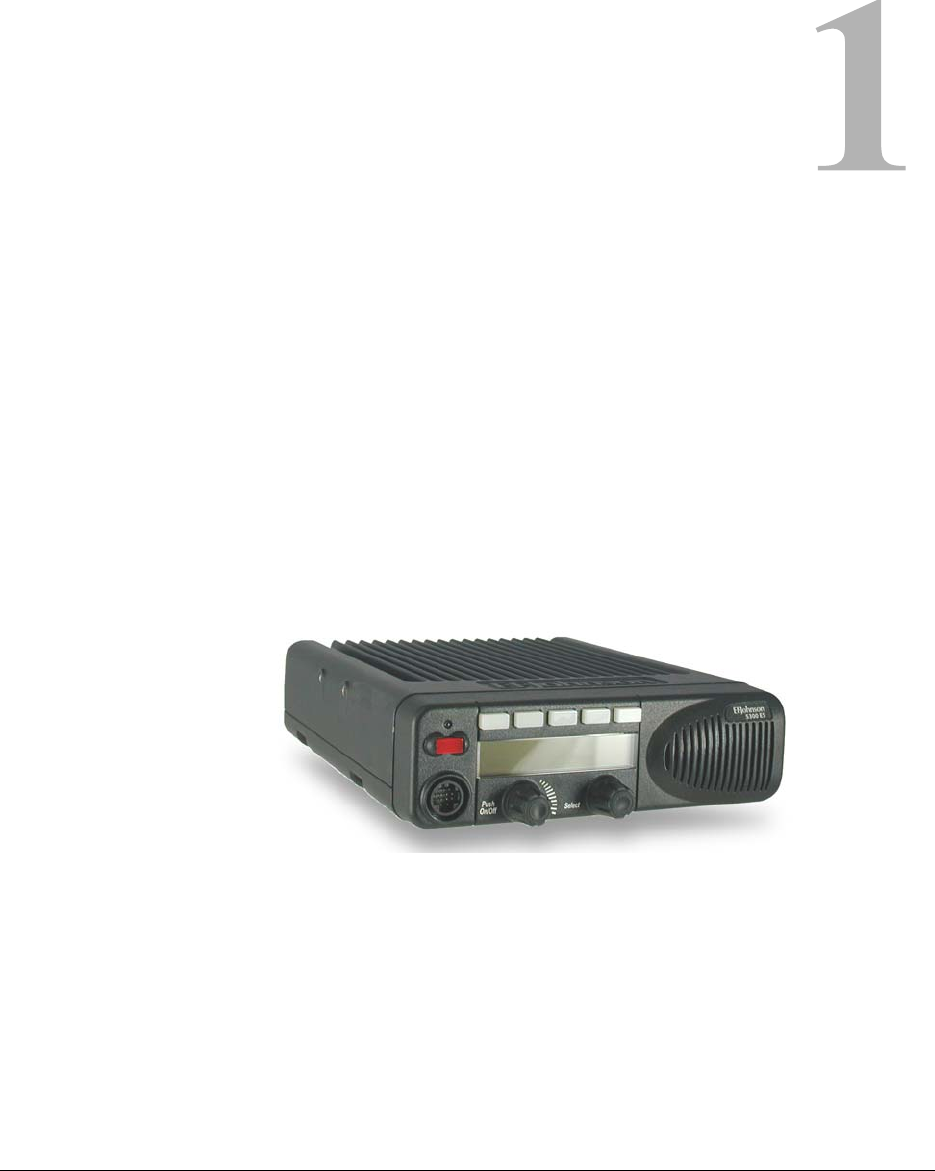
Viking VM600 Mobile Radio Operating Manual 1-1
SECTION
Section1Radio Overview
The Viking® VM600 Mobile radio is designed specifically for critical land mobile radio
applications. Whether for police and fire first responders or public service and government
communications, the Viking® VM600 provides the features and capabilities for all
operating modes. Seamless interoperability with analog and digital, wideband and
narrowband, and a wide variety of trunking protocols – all available simultaneously in the
same radio.
Figure 1.1 Viking VM600 Mobile Radio
Depending on the specific model (and options), the Viking VM600 mobile radio operates
in the VHF (136-174 MHz), UHF 380 (380-470 MHZ), UHF Low (403-470 MHz), UHF
High (450-512 MHz), and 700/800 (762-870 MHz) frequency bands at 15-35 output watts
transmitter power. The Viking VM600 uses the Enhanced (AMBE+2) P25 Vocoder for
outstanding voice quality and noise reduction.
1.1 Capabilities & Features
The Viking VM600 mobile radio is designed to provide an extensive list of features and
capabilities for most any communications application.
Draft 4/29/2014
1-2 Viking VM600 Mobile Radio Operating Manual
Radio Overview
- Up to 1024 Channels / Talkgroups
- SMARTNET II®, SmartZone® P25 Digital and Analog, P25 Digital and Analog
- All Supported Protocols Available Simultaneously
- DES, DES-OFB, & AES Encryption with 64 keys
- 54-channel/16-zone Feature
- P25 Conventional & Trunked OTAR
- Conventional Vote Scan is Standard
- Supports Key Elements of MDC1200
- Compatible with Motorola Astro®
- Simplified cabling with a single multi-function accessory connection in the rear
• Operating Modes
- Conventional Analog and Project 25 Digital
- Trunking Mode Project 25 (P25) Digital
- SMARTNET II / SmartZone
• Data and Control Interfaces
- Supports P25 Conventional IP Packet Data
- P25 (Astro) IV & D
- Supports GPS AVL Data
• Simplified Feature Updates and Option Selection
- Over the Air Programming (OTAP) option enables you to program radios without
connecting them to a computer
- Easy radio programming and feature updating for portable and mobile radios
• Multiple Configuration Options
- Dash Mount, Remote Mount, and Motorcycle Configurations
- Two Control Heads
- Internal or External Speaker
- Fixed Control Stations
- Siren Option
Draft 4/29/2014

Viking VM600 Mobile Radio Operating Manual 1-3
Radio Overview
Note The availability of many features is controlled by field programming and by the options
ordered. See the EFJohnson Technologies product description and the following sections
in this manual for additional information.
1.2 Radio Software and Configuration Programming
The radio operating software can be easily updated to accommodate new releases and
updates issued from EFJohnson technical support.
1.3 Supported Software
This manual was prepared to support subscriber radio software release 9.1 used on this
radio. Some information in this manual may not be compatible with earlier subscriber
radio software releases.
1.4 Available Options
Availability of optional features is controlled by factory programming of the control logic.
Only those features that are specifically ordered and enabled in a particular radio are
available for use and can be programmed. The optional features controlled by factory
programming are as follows.
P25 Options
• P25 conventional mobile data
• P25 trunked mobile data
• P25 conventional operation
• P25 trunked operation
Encryption Options
•DES
• DES OFB
Draft 4/29/2014

1-4 Viking VM600 Mobile Radio Operating Manual
Radio Overview
OTAR Options
• OTAR P25 conventional
• OTAR P25 trunked
Trunking Options
• SMARTNET analog operation
• SmartZone analog operation
• Digital SMARTNET/SmartZone
• EFJohnson MultiNet
Feature Options
• Keypad programming (Federal Government users only)
• Full Keypad support
• 512 or 864 talkgroups, depending on the option enabled
• 54-Channel/16-Zone mode
• Custom icons
• Zonefail site lock
• MDC1200
•700 MHz Band
• Conventional Vote Scan
Currently, the only operating mode that is standard with all models is the conventional
analog mode. Other variables such as frequency range are hardware dependent instead of
software dependent.
Radios in the field may be upgraded with new features. A new feature can be purchased
and a special encrypted code string keyed to the Electronic Serial Number (ESN) of the
radio is then provided by EFJohnson Technologies. This string is in the form of a
computer file which enables the feature, and is downloaded to the radio using Armada.
1.5 Licensing
This radio operates on radio spectrum frequencies assigned and licensed by the Federal
Communications Commission (FCC). The FCC can penalize anyone operating an
unlicensed radio. It is the radio operator’s responsibility to obtain the necessary license for
this radio equipment.
Draft 4/29/2014
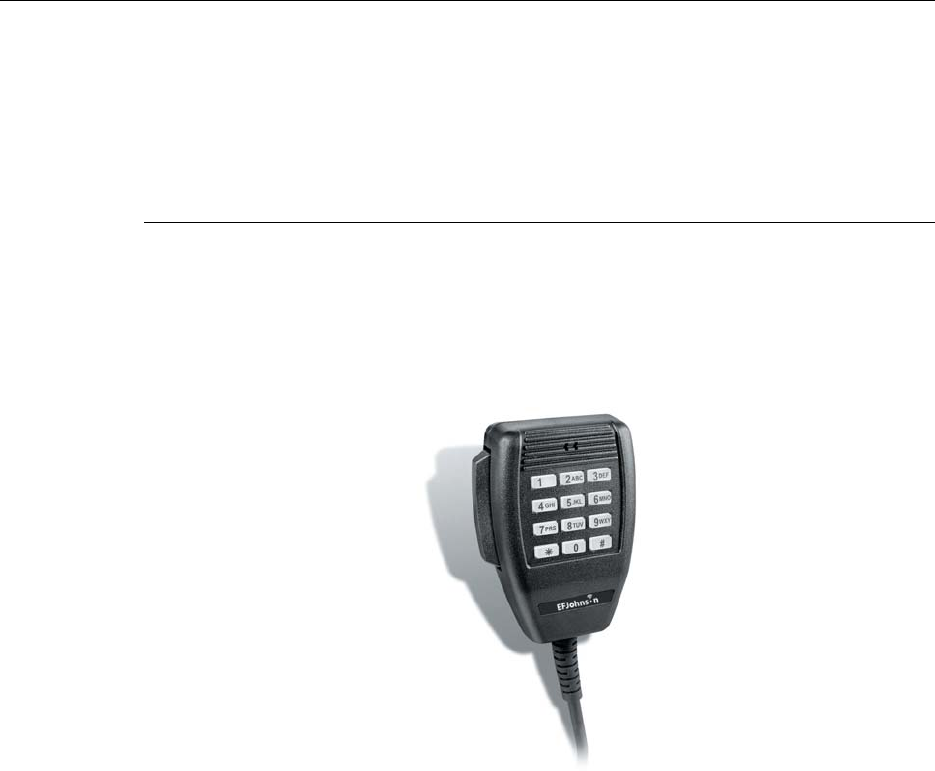
Viking VM600 Mobile Radio Operating Manual 1-5
Radio Overview
1.6 Radio Accessories
Various accessories are available from EFJohnson that will provide added capability and
enhanced operation for this radio. The following describes some of the accessories
available.
1.6.1 Digital Keypad Microphone
An optional accessory microphone is available with an integral Digital Keypad. You can
program various radio features to the keys. This can place often used functions
conveniently on the microphone.
Figure 1.2 Digital Keypad Microphone
Draft 4/29/2014
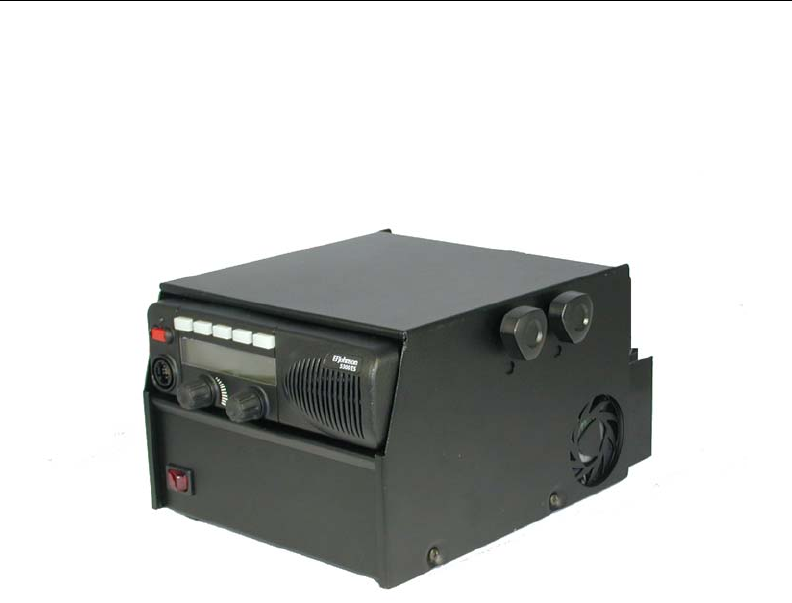
1-6 Viking VM600 Mobile Radio Operating Manual
Radio Overview
1.6.2 Base Station Unit
A Base Unit power supply is available that can be used to power the Viking VM600 radio
from 110 volt AC line voltage. This lets the Viking VM600 be used in a field office, base
station, or headquarters building.
Figure 1.3 Viking VM600 Mobile Radio Mounted in Base Station
Consult with your EFJohnson representative for additional accessories that can be used
with your EFJohnson mobile radio.
Draft 4/29/2014
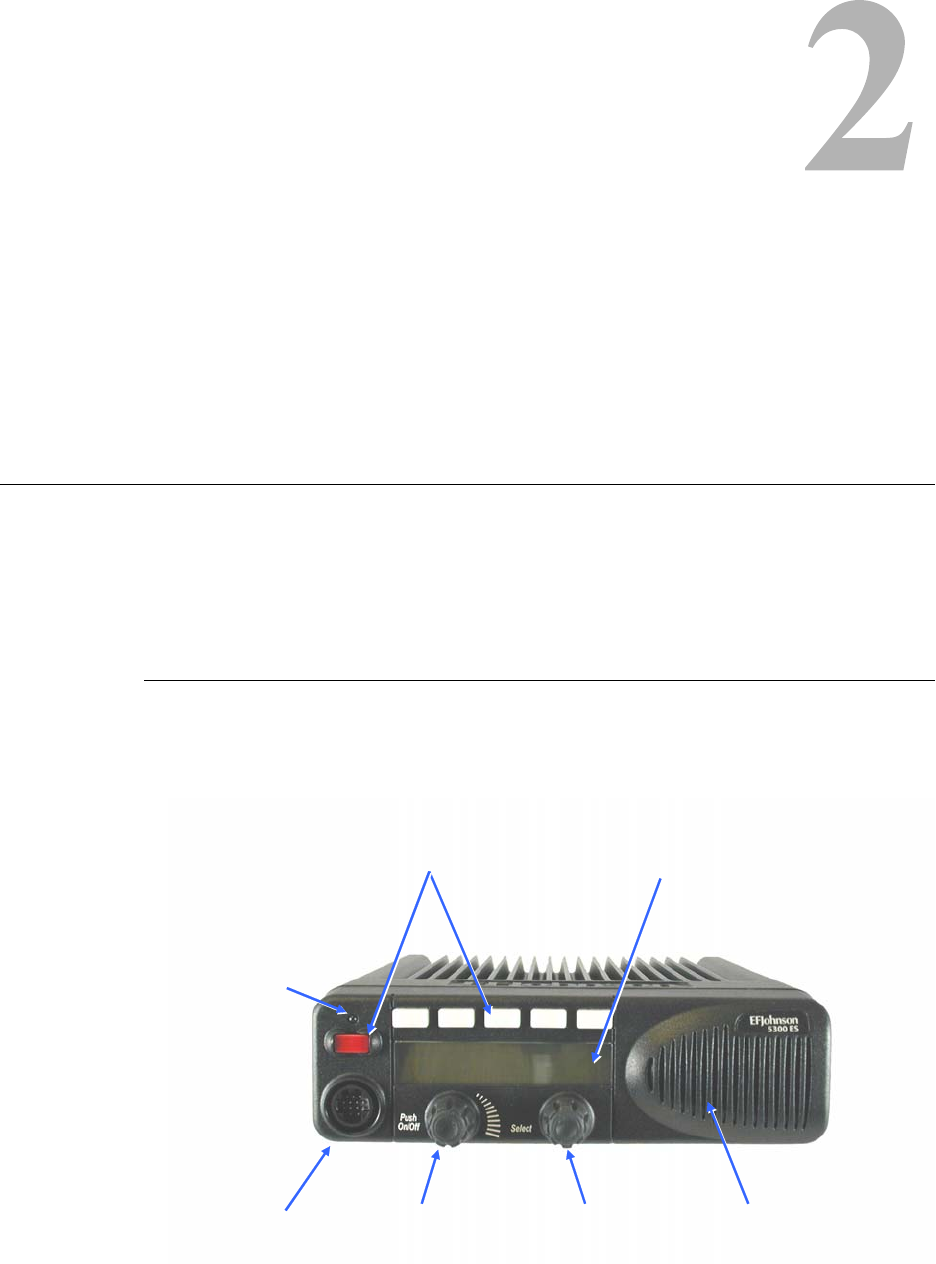
Viking VM600 Mobile Radio Operating Manual 2-1
SECTION
Section2Controls & Display
2.1 Standard Control Head
The standard control head provides the primary controls, display, and speaker for the
mobile radio.
2.1.1 Front Panel Controls
Figure 2.1 shows the controls for the Viking VM600 Mobile radio.
Figure 2.1 Front Panel Controls
Programmable Buttons
Speaker
Display
Multi-function
Indicator
On-Off / Volume Select / ZoneMicrophone
Connection
Draft 4/29/2014
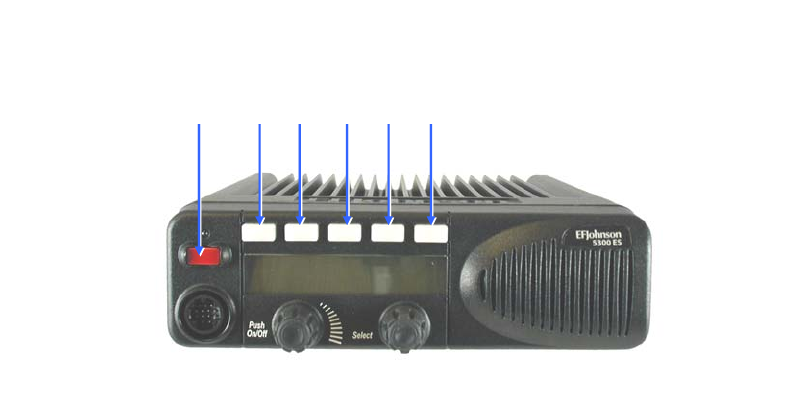
2-2 Viking VM600 Mobile Radio Operating Manual
Controls & Display
ON-OFF /Volume - Pressing this control turns power ON and OFF (soft power down can
be programmed as in Section 3.1.1.3), and rotating it sets the volume level.
Select Switch - This switch can be pressed or rotated. An optional beep can be
programmed to sound when it is pressed. Selects zones/channels and is also used for other
functions such as selecting names from a call list. When selecting zones/channels, a bar
above the zone or channel display (see Figure 2.3) indicates which is being changed. This
bar is switched between displays by pressing this switch, and zone and channels are
selected by rotating it (see Section 4.1.6.3). If this switch is pressed and held, the radio
enters Menu Mode.
Multi-function Indicator - This is a two-color LED that indicates the following:
Red (constant) - Transmitter keyed (PTT switch pressed).
Green (constant) - Busy condition (carrier detected in receive mode).
Note This indicator is disabled when the Surveillance mode is programmed (see Section 5.10).
Option Buttons - Each of the six options buttons on the front panel (including the one
located to the left of the display) can be programmed by your system operator to control
some function. The button functions can be different for each operating mode
(conventional, SMARTNET/SmartZone, and Project 25 Trunked). Therefore, up to 18
functions can be controlled by these buttons. Refer to Section 5.1 for more information on
option button functions.
Figure 2.2 Option Buttons
Speaker - An internal 16-ohm, 5-watt speaker is located behind the grille. An optional 4-
ohm, 12-watt external speaker may be used if desired. The internal speaker should be
disabled when an external speaker is used.
Programmable Option Buttons
F1 F2 F3 F4 F5 F6
Draft 4/29/2014
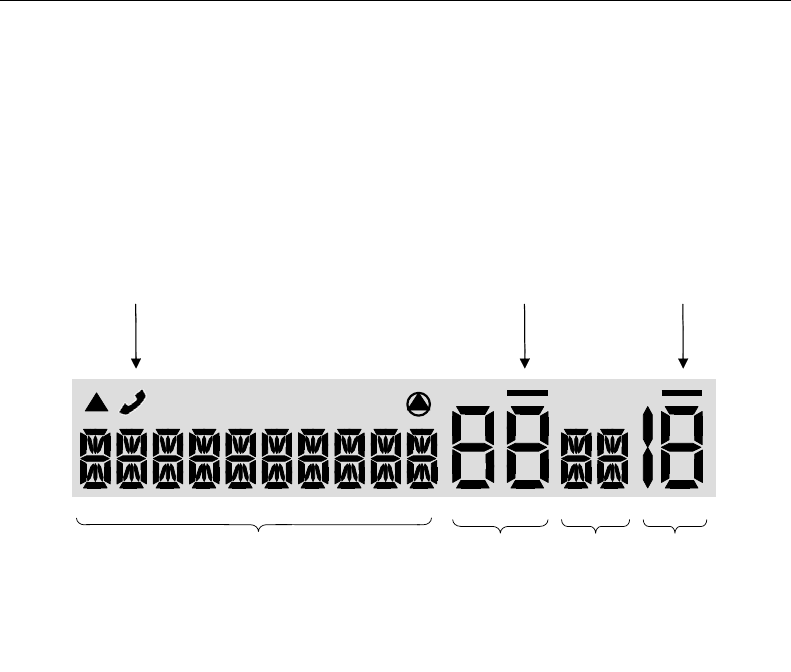
Viking VM600 Mobile Radio Operating Manual 2-3
Controls & Display
2.1.2 Display
Figure 2.3 shows the front panel display.
Note Radios are capable of displaying messages in English, French or Spanish.
Figure 2.3 Front Panel Display
Alphanumeric Display - This ten-character area of the display indicates the alias (unique
identification) for the selected zone, channel or combined aliases, depending on which
select mode is active. It may also indicate such things as the channel frequency, ID
numbers, and status and error messages.
Zone Number - Indicates the currently selected zone from 1 up to 255, depending on the
options installed. A zone is a collection of channels that can be any combination of the
conventional, P25 Trunked, and SMARTNET/SmartZone types.
Note The zone/channel numeric display and the zone/channel select bars in all supported
protocols and display operating modes can be inhibited by programming.
Status Display - Two characters indicate various status information. See Table 2.1.
Channel Number - Indicates the currently selected channel (conventional) or talkgroup
(other modes). The lines above the zone and channel displays indicate which display is
changed if the Select switch is turned. To switch between displays, press the Select switch.
10 - Character Alphanumeric Display Zone
Number Status
Display Channel
Number
MON
Operating Mode
Symbols Zone/Channel Select Indicators
Draft 4/29/2014
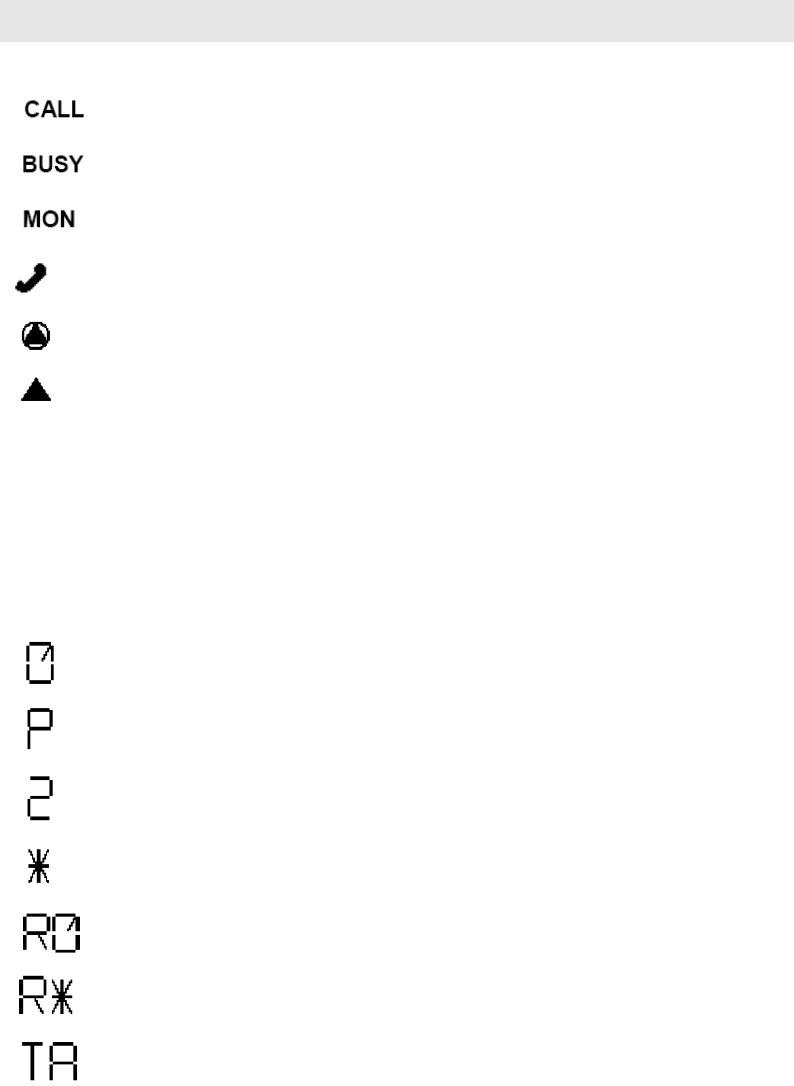
2-4 Viking VM600 Mobile Radio Operating Manual
Controls & Display
Table 2.2 lists the symbols used on the display to indicate various operating modes and
status.
Table 2.1 Standard Control Head Display Symbols
Standard Control Head Display Symbols
Operating Mode Symbols
Unit (or Private) call mode active
Busy (displayed when radio enters a busy transmit state)
Monitor mode enabled
Interconnect mode enabled
Security enabled
• Keypad programming/edit mode - displayed when the radio is in a mode where
the user can edit radio parameters.
• P25 data context enabled - radio is ready for data operations or call history
(only when radio is in conventional unit call, call alert or text messaging and an
applicable unit ID is selected.)
• P25 data channel grant (radio is operating on a data channel) or text message
mode active.
Status Display Symbols
Scan enabled
The current channel is the priority channel in the enabled scan list (only when scan is on or
when in scan edit mode; located in left position)
The current channel is the priority 2 channel in the enabled scan list (only when scan is on
or when in scan edit mode; located in left position)
The current channel is in the enabled scan list (only when scan is on or when in scan edit
mode; located in left position)
Radio wide scan mode enabled
Selected channel is in radio wide scan list (only when radio wide scan is on or when in radio
wide scan edit mode)
Repeater talk-around enabled
Draft 4/29/2014
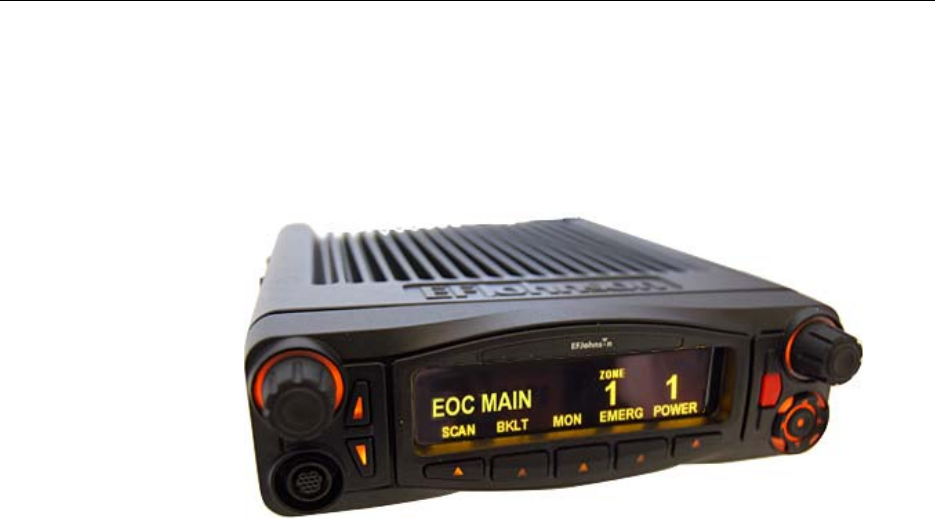
Viking VM600 Mobile Radio Operating Manual 2-5
Controls & Display
2.2 Lightning Control Head
An optional component for the Viking VM600 mobile radios is the Lightning Control
Head illustrated in Figure 2.4. The Lightning Control Head offers superior readability and
display options for the radio user. The control head can be fitted to both dash and remote
mount mobile radio installations.
Figure 2.4 Radio with Lightning Control Head
Draft 4/29/2014
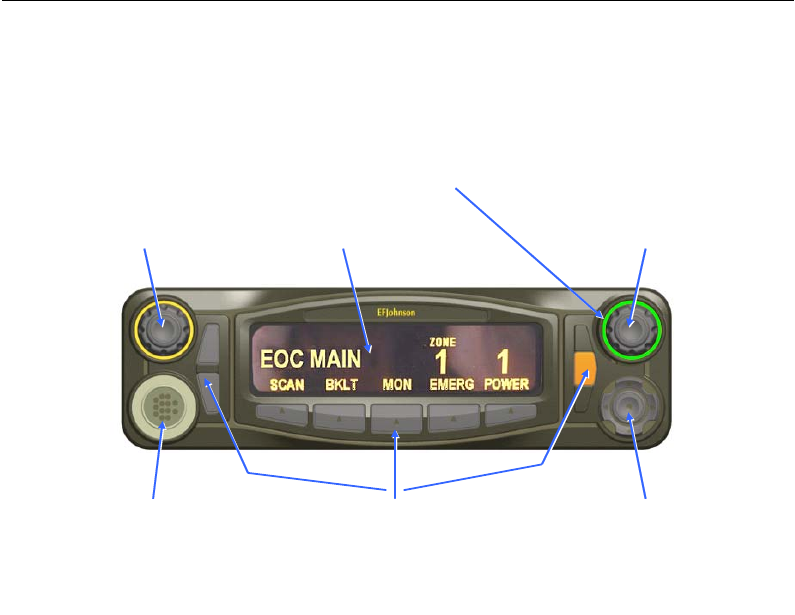
2-6 Viking VM600 Mobile Radio Operating Manual
Controls & Display
2.2.1 Front Panel Controls
The Lightning Control Head front panel controls are illustrated in Figure 2.5.
Figure 2.5 Light Control Head Controls
On-Off Volume - This control has two actions: rotation and press. Press the control to
turn power on/off function to the radio. Rotate the control (when power is on) to adjust the
radio speaker volume.
Display - The display shows all primary operating information such as active channel,
zone, along with channel/zone alias, status symbols, and labels for the five function
buttons under the display.
Multi-function Indicator - The halo light surrounding the Select Control is used to
indicate radio transmit and receive status.
-Steady Red - Radio transmitting
-Steady Green - Radio receiving
-Steady Orange - Radio idle
Select Zone / Channel - This control has two actions: rotation and press. In normal non-
menu mode, press the control to select either the zone or the channel. Then rotate the
control to change either the zone or channel depending on the selection. (It is indicated on
the display whether zone or channel is selected.)
Microphone Connection - A compatible microphone plugs into this jack connector.
One-Touch
Programmable Buttons
(8)
4-Way
Navigation Pad
Display
On-Off / Volume
Switch Select Zone/Channel
Switch
Microphone
Connection
Multi-function
Indicator
Draft 4/29/2014
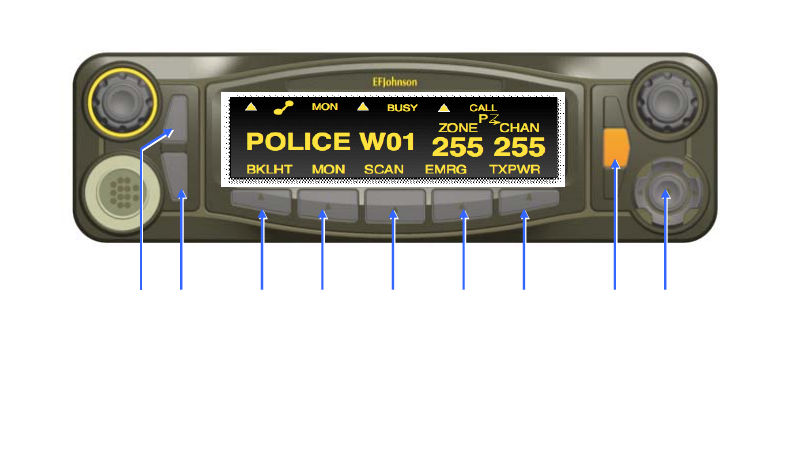
Viking VM600 Mobile Radio Operating Manual 2-7
Controls & Display
One-Touch Buttons - The control head has 8 one-touch buttons: two on the left of the
display, five under the display, and an orange button on the right of the display. These
buttons can be programmed with different radio functions. (See the Armada Programming
manual for information on programming these button functions.)
Figure 2.6 Lightning Option Buttons
4-Way Navigation Pad - This button pad is used to navigate through various radio
functions and menus. The pad can be programmed with different radio functions.
One-Touch Programmable Buttons
*4-Way Navigation Pad
F7 F8 F2 F3 F4 F5 F6 F1 F9*
Draft 4/29/2014
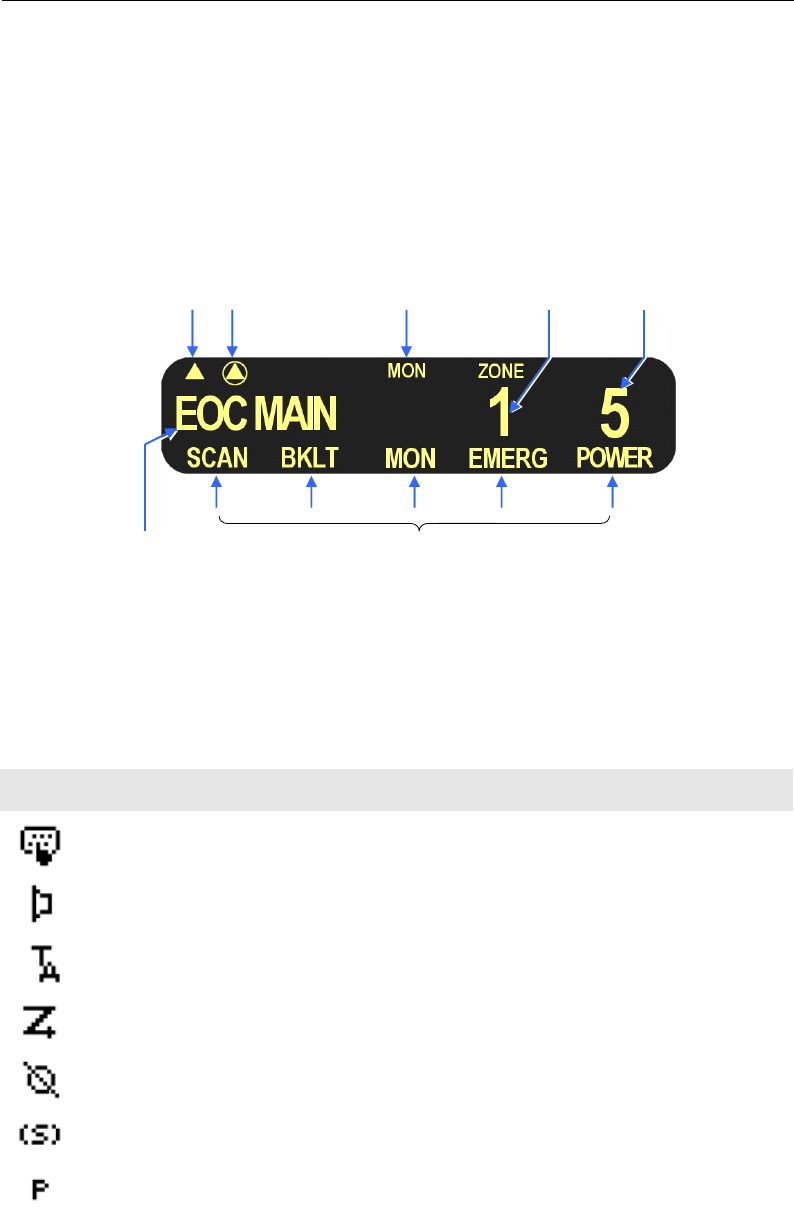
2-8 Viking VM600 Mobile Radio Operating Manual
Controls & Display
2.2.2 Display
The Lightning Control Head includes a highly readable display. The display is a mono-
chrome display with 320 x 80 pixels. The display supports both the Classic Single Line
display mode or enhanced Dual Line functionality. In Classic Single Line mode, display
will have primary fields corresponding to the fields available on the mobile Viking control
head, with the addition of the soft menu keys. Figure 2.7 shows the front panel display.
Figure 2.7 Lightning Control Head Display
Table 2.2 lists the symbols used on the display to indicate various operating modes and
status.
Table 2.2 Lightning Display Operating/Status Mode Symbols
Lightning Control Head Symbols
Keypad programming/edit mode. Displayed when the radio is in a mode where you can edit
radio settings.
Monitor mode enabled
Repeater Talk-Around mode enabled
Scan Enabled
Security Enabled
The current channel is in the enabled scan list (only when scan is on or when in scan edit
mode)
The current channel is the priority channel in the enabled scan list (only when scan is on or
when in scan edit mode)
Zone
Number Channel
NumberOperating Mode Symbols / Status
One-Touch Button LabelsChannel
Name
Draft 4/29/2014
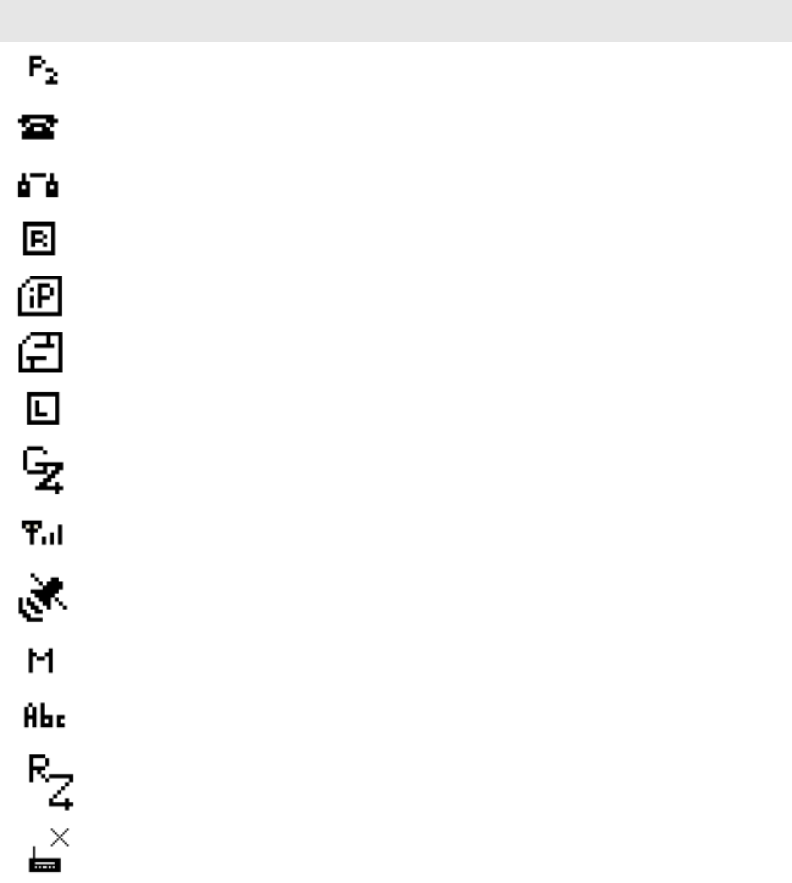
Viking VM600 Mobile Radio Operating Manual 2-9
Controls & Display
The current channel is the priority 2 channel in the enabled scan list (only when scan is on or
when in scan edit mode)
Interconnect mode enabled
Private call mode enabled
Radio is in Roaming mode
P25 data context enabled (radio is ready for data operations)
P25 data channel grant (radio is operating on a data channel)
Site lock mode
Multi-Net trunking group scan enabled
Signal strength (indicates an acceptable site, and may range from 4 bars to no bars)
GPS link active
Call history (only when radio is in conventional unit call, call alert or text messaging and an
applicable unit ID is selected.
Text message mode active
Radio wide scan mode enabled
Busy (displayed when radio enters a busy transmit state)
Lightning Control Head Symbols (Continued)
Draft 4/29/2014
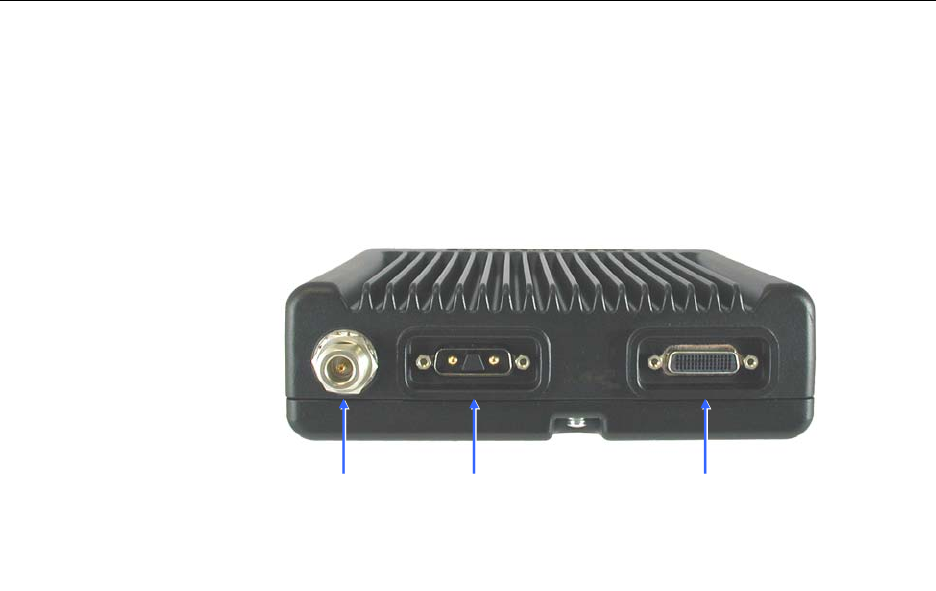
2-10 Viking VM600 Mobile Radio Operating Manual
Controls & Display
2.3 Rear Panel Connectors
The mobile rear panel connectors are shown in Figure 2.8. These are applicable to both the
Standard and Lightning control heads.
Figure 2.8 Rear Panel Connectors
DC Power - Connection point for the nominal 12-volt, negative ground power source (see
Figure 2.8).
Antenna - Type N for connecting the antenna.
Accessory - Black connector for connecting optional accessories such as an external
speaker (4-ohm, 12-watt), horn alert, siren control, and ignition sense line.
AccessoryAntenna DC Power
Draft 4/29/2014
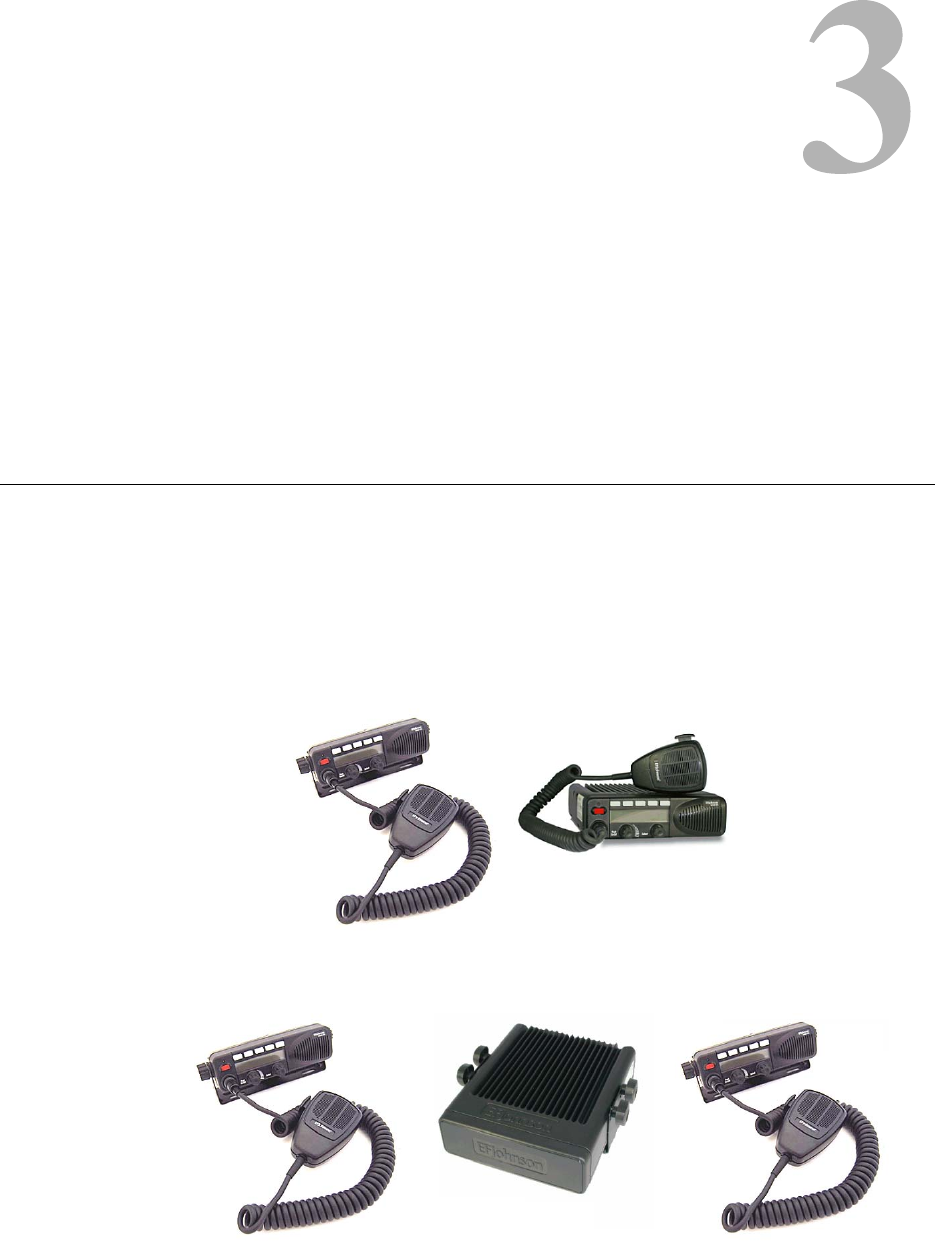
Viking VM600 Mobile Radio Operating Manual 3-1
SECTION
Section3Dual Controls & External Speaker
3.1 Dual Control Configurations
The Viking VM600 series mobile radio is available in two dual-control configurations,
each with different programming and setup requirements:
- Dash-mount radio with a remote mount control head
- Remote-mount radio with two remote control heads
Figure 3.1 Dash-Mount Radio with Remote Control Head
Figure 3.2 Remote-Mount Radio with Two Remote Control Heads
Draft 4/29/2014

3-2 Viking VM600 Mobile Radio Operating Manual
Dual Control Configurations Section 3 - Dual Controls & External Speaker
Both dual control configurations can be configured and ordered as a complete kit. Existing
Viking mobiles can also be converted to dual control configurations by the purchase of
accessory kits, as described in the EFJohnson Subscriber Radio Accessories Catalog.
Contact your EFJohnson Sales Representative for additional information.
3.1.1 Remote Conversion Kit 250-5300-002
This kit provides the material required to convert an existing dash-mount mobile to a
remote-mount configuration. The kit includes:
- Blank faceplate for mobile unit
- Rear shroud for remote control head
- Remote control head mounting bracket
- Single remote accessory cable (part number 597-5357-706)
- 17 ft. remote control cable (part number 597-5357-775-02)
The kit does not include the control head removal tool (part number 721-5100-010) which
must be ordered separately if required.
The remote control cable is also available in 6 ft. (part number 597-5357-775-01) and 50
ft. (part number 597-5357-775-03) lengths, but these must be ordered separately.
3.1.2 Remote Control Head Kit 250-5300-003
This kit includes the material required to add a remote control head to an existing dash-
mount or remote-mount configuration. The kit includes:
- ES Remote control head with mounting bracket.
Due to differing operational requirements, the following items are not included in the kit
and must be ordered separately:
- Microphone - see section 3 for further details
- Remote control cable - order 6 ft., 17 ft. or 50 ft. cable as required
- Remote accessory cable - see section 2.3 for further details
Configurations using two remote control heads require the Dual Remote / Accessory /
Data / Siren cable (part number 597-5357-741).
Configurations using a dash-mount mobile with one remote control head can use the
following remote accessory cables, depending on the application:
- Single Remote / Accessory cable (part number 597-5357-706)
- Single Remote / Accessory / UDDI cable (part number 597-5357-736)
- Single Remote / Accessory / Data / Siren cable (part number 597-5357-716)
Draft 4/29/2014

Viking VM600 Mobile Radio Operating Manual 3-3
Dual Control Configurations Section 3 - Dual Controls & External Speaker
3.1.3 Hardware Setup
When shipped, the dual remote-mount configuration consists of a dash-mount radio, a
remote control head, a conversion kit for the second control head, and required cabling.
Upon receipt, the installer must convert the dash-mount mobile radio into a remote-mount
configuration using instructions contained in the installation manual (part number 004-
5300-73001) which is supplied with the unit.
In the dual remote control configuration, the EFJohnson noise-cancelling microphone
(part number 589-0016-592) or compatible should be used on both control heads. This
microphone can be identified by the small circular metal grill above the hang-up button on
the rear of the microphone. Use of other microphones in this configuration will result in
degraded operational performance.
3.1.4 Radio Programming using Armada
No special programming is required for dash-mount mobiles with a single remote control
head.
3.1.5 Programming Dual Remote Control Configurations
The Dual Remote configuration requires special programming to accommodate both
remote control heads in the mobile radio system. Radios used in the dual remote control
configuration must have application software of 6.8.6 or later, and must be programmed
using Armada.
To program, follow the steps:
1Start PCConfigure 2.10.2 or later
2Open the programming file (codeplug) to be used with the radio
3Select the Global page
4Click on the Mic. Levels button near the center bottom of the screen (see Figure 3.3)
5Check the "Dual Remote Control Head" gain box
6Click OK
7Write the programming file to the radio
Draft 4/29/2014
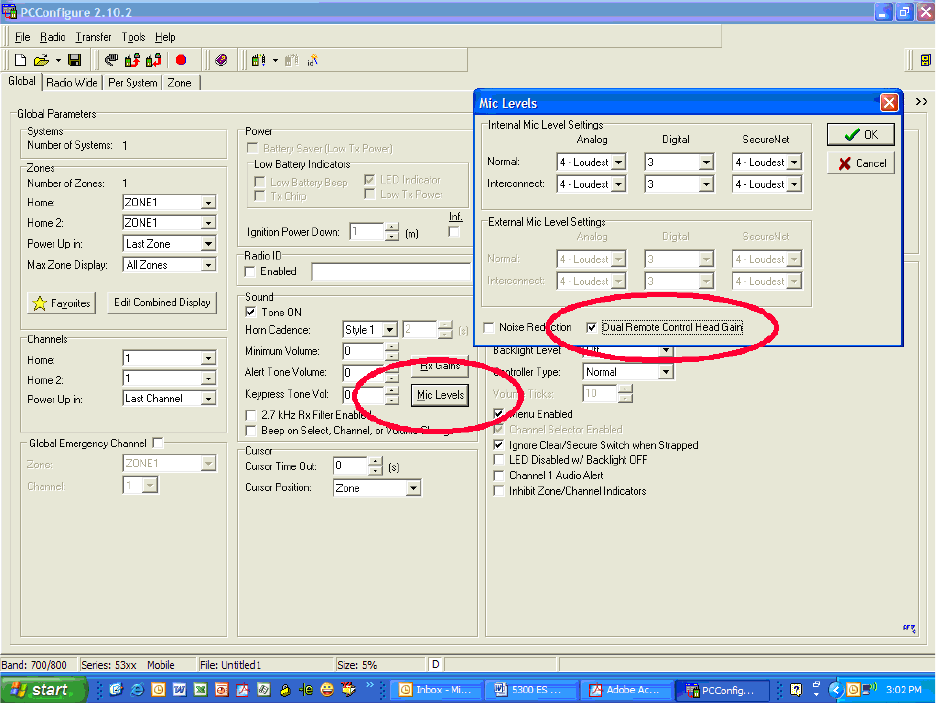
3-4 Viking VM600 Mobile Radio Operating Manual
Dual Control Configurations Section 3 - Dual Controls & External Speaker
Figure 3.3 Programming Microphone Gain Settings
Removal of either control head will affect system performance. If there is a need to later
convert the system to a single control head application, Armada must be used to un-check
the "Dual Remote Control Head Gain" on the Mic Levels screen.
Draft 4/29/2014
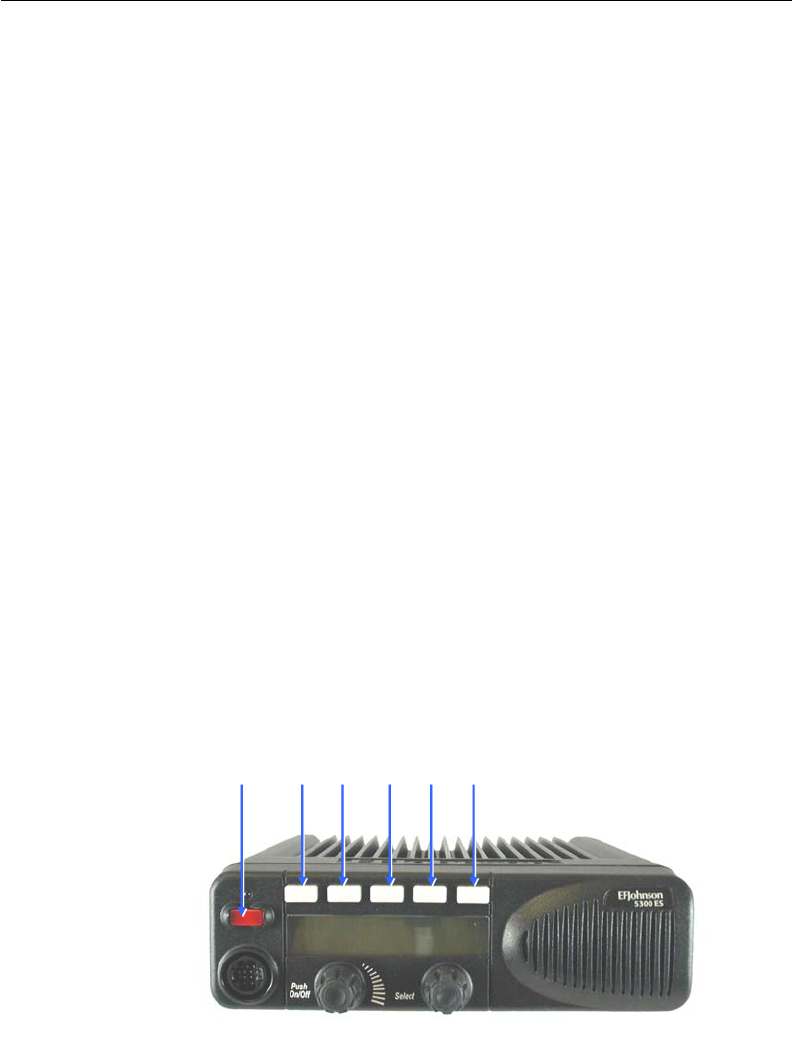
Viking VM600 Mobile Radio Operating Manual 3-5
Dual Control Configurations Section 3 - Dual Controls & External Speaker
3.1.6 Master / Slave Programming
In both dual control configurations, either control head can be designated as the Master
and the other as the Slave. The Master control head controls the volume of its internal
speaker and any external speakers that are connected to the radio's 8-pin accessory
connector (see installation manual for connection details).
All Viking VM600 mobile radios ship from the factory with the dash-mount control head
and any remote control heads set as Master, so in all dual-control configurations, one
control head must be set as the Slave to ensure correct operation.
Control head addressing is set as follows:
1Power up the mobile radio
2Press buttons F3, F4 and F5 at the same time, and release (see Figure 3.4).
3The display will read "ADDRESS 21" if the control head is configured as the Master,
or "ADDRESS 22" thru "ADDRESS 27" if the control head is configured as the Slave.
4Rotate the Select knob to select the appropriate address.
5After a short time-out period, display will read "CYCLE PWR"
6Power the radio off and back on, and the configuration will be updated.
Figure 3.4 Control Head Option Buttons
Programmable Option Buttons
F1 F2 F3 F4 F5 F6
Draft 4/29/2014

3-6 Viking VM600 Mobile Radio Operating Manual
Dual Control Configurations Section 3 - Dual Controls & External Speaker
3.1.7 Dual Control Operation
3.1.7.1 Power On/Off
The power switching in dual configurations is such that either control head can switch the
radio on, but both control heads must be off to turn the radio off.
If the power button on both control heads is pressed, then the power button on both control
heads must be pressed again to turn the radio off.
It is therefore recommended to always turn the radio on and off using one control head, to
simplify operation and avoid confusion.
3.1.7.2 Microphone Audio
In the dual remote control configuration, when transmitting from one of the control heads,
it is possible for the push-to-talk (PTT) on the microphone of the second remote head to
also be active. In this case, the voice transmissions of both users will be transmitted,
resulting in a "party line" operation. This is done to allow either control unit access to the
voice channel, and to eliminate the circumstance where one operator may be prevented
from having their transmission heard because the other control head is already
transmitting.
To prevent a second operator from interrupting a transmission already in progress, the user
should look at the transmit indicator on the control head prior to pushing PTT to verify that
the mobile radio is not already transmitting from the other control head.
Draft 4/29/2014
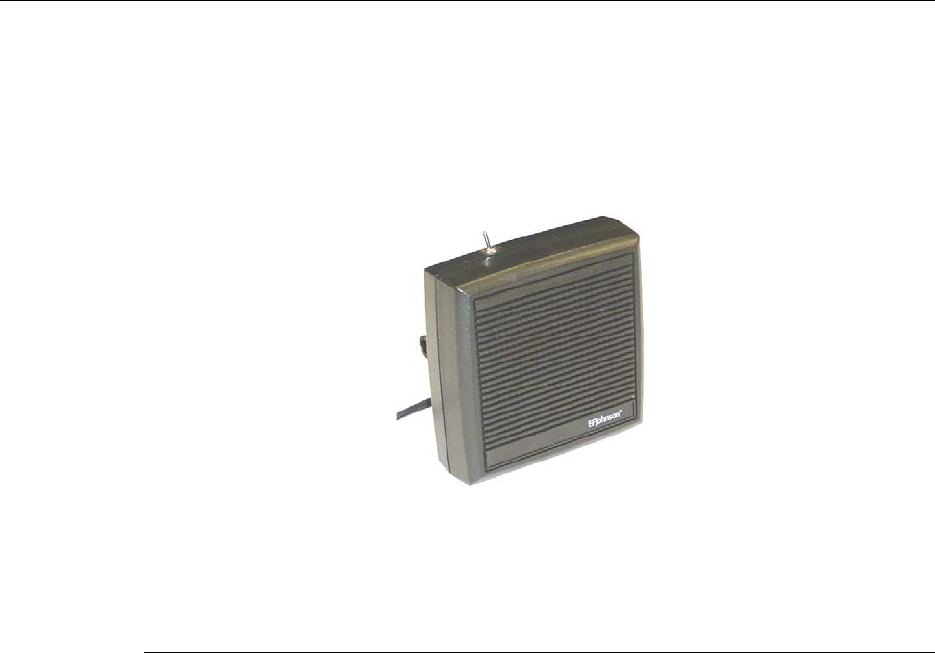
Viking VM600 Mobile Radio Operating Manual 3-7
External Speaker Section 3 - Dual Controls & External Speaker
3.2 External Speaker
An optional 4 ohm, 15 watt external speaker is available from EFJohnson (Part No. 250-
0151-006). This can be used to enhance radio audio or to provide primary audio for a
remote-mount radio. Refer to the Viking VM600 Series Mobile Radio Installation guides
for additional installation information.
Figure 3.5 EFJohnson External Speaker
3.2.1 Internal / External Speaker Programming
All Viking VM600 mobile radios ship from the factory with the internal speaker in the
control head enabled, and audio is also routed to the 8-pin accessory connector at the rear
of the radio.
If you connect an external speaker to the 8-pin accessory connector (as described in the
installation manual), the internal speaker will not be automatically disabled, and both
speakers will be active.
To disable the internal speaker, proceed as follows:
1Power up the mobile radio
2Press buttons F2 and F5 at the same time, and release (see Figure 3.4).
3Rotate the Select knob, until display reads "SPKR DSABL"
4After a short time-out period, display will read "CYCLE PWR"
5Power the radio off and back on, and the internal speaker will be disabled.
Draft 4/29/2014
3-8 Viking VM600 Mobile Radio Operating Manual
External Speaker Section 3 - Dual Controls & External Speaker
To re-enable the internal speaker, proceed as follows:
1Power up the mobile radio
2Press buttons F2 and F5 at the same time, and release (see Figure 3.4).
3Rotate the Select knob, until display reads "SPKR ENABL"
4After a short time-out period, display will read "CYCLE PWR"
5Power the radio off and back on, and the internal speaker will be enabled
Draft 4/29/2014

Viking VM600 Mobile Radio Operating Manual 4-1
SECTION
Section4General Operation
4.1 Basic Operation
4.1.1 Turning Power ON and Setting Volume
Power is turned ON and OFF by pressing the ON-OFF /Volume knob. When power is
turned ON, the radio goes through a self test. When that is successfully completed,
software version, unit ID, zone, then channel are briefly displayed (except when a
conventional analog channel is selected), a tone sounds (if tones are enabled), and the
radio is ready for normal operation. If “ENTER PSWD” is briefly displayed, refer to the
next section.
The radio can be programmed so that one of the following combinations are selected at
power up:
• Last Zone/Last Channel
• Last Zone/Home Channel
• Home Zone/Last Channel
• Home Zone/Home Channel
The Home Zone and Channel are pre programmed. With the “Last Zone”/“Home
Channel” configuration, the programmed home channel number of the last active zone is
selected. If this channel number is not programmed in the active zone, “UNPROGRAMD”
is displayed.
Draft 4/29/2014
4-2 Viking VM600 Mobile Radio Operating Manual
General Operation
If the Radio ID feature is enabled, the radio will display the Radio ID alias in place of the
Self Test message during startup. Radio ID identifies the personality file used to program
the radio, the service area for which the radio is programmed, or functional grouping for
which the radio is programmed. The Radio ID alias display will be included with the
Radio Info display items in both button/scroll and menu modes. If disabled, the Radio ID
menu mode will display a blank line.
Note In dual control configurations (front mount radio with remote control unit), the power
switch at either control point can be OFF for power to turn OFF.
4.1.1.1 Setting Volume Level
The relative volume setting can be determined using a reference tone as follows:
• If the key press tones are enabled (see Section 5.6), a short tone sounds when an option
switch is pressed or the Select switch is pressed or rotated.
• If a conventional channel is selected, take the microphone off-hook and if someone is
talking, voice may be heard. If the MON (Monitor) option switch is programmed (see
Section 5.3 on page 25), pressing it unsquelches the radio and either voice or
background noise is heard. If a SMARTNET/SmartZone or P25 trunked channel is
selected, the radio cannot be manually unsquelched.
The minimum volume level that the volume control can select can be programmed. This
can be used to prevent missed messages caused by unintentionally turning the volume
down too far. Relative levels of 0-255 can be set in steps of 1 (“0” sets the lowest
minimum volume).
Note This setting is applicable to Viking mobiles with Viking Series Remote Control Heads. The
minimum volume setting has no effect on the volume of a pre-ES Series model remote
control head using an internal speaker whether it is attached to a pre-ES Series or an
Viking Series mobile radio.
4.1.1.2 Standard and Soft Power Down
To turn power off, press the ON-OFF/Volume knob.
A soft feature can be programmed to prevent radio power from being turned off by
accidentally pressing the on-off/volume knob. If the user presses the ON-OFF/Volume
knob, “POWERDOWN” will be displayed. The display message portion of the display
stops updating. The user is able to receive, transmit, and use function buttons, but the
display message will not change. If the channel is changed the Zone/Channel indication
will update.
Draft 4/29/2014

Viking VM600 Mobile Radio Operating Manual 4-3
General Operation
The user can power the radio completely down by pressing the option button programmed
for this purpose (F2 or F6).
If the user presses the ON/OFF/Volume knob while soft is in effect, the radio returns to
full power up operation.
4.1.2 Power-Up Password
The power-up password feature prevents unauthorized use of the radio by requiring that an
eight-digit password be entered to make it operational. This feature is enabled or disabled
by programming.
When it is enabled, “ENTER PSWD” is briefly displayed when power is turned on, the
eight-digit numeric password must be entered by pressing and rotating the Select switch.
A single beep sounds when the switch is pressed (if that option is enabled). If an incorrect
password is entered, “INCORRECT” is displayed and it must be re-entered.
An enhanced password scheme allows up to four power-on (user) passwords, download
and upload passwords, and a master password to be programmed.
The current User password can be changed if the “PW CHG” option switch is
programmed. Selecting this function displays prompts for entering and confirming a new
password.
4.1.2.1 Programming Passwords
Passwords are programmed using Armada. The applicable radio must be connected to the
computer and powered up to display this screen.
Note Any password changes made to the radio will be immediately applicable when Password
Management is exited.
4.1.2.2 Lost Passwords
If a password is lost, contact customer service.
4.1.2.3 Changing Passwords
An assigned password can be changed by the user if the PW CHG option switch is
programmed. Selecting this function displays prompts for entering and confirming a new
password.
Draft 4/29/2014
4-4 Viking VM600 Mobile Radio Operating Manual
General Operation
4.1.2.4 Password Entry Procedure
When a password is requested, it is entered as follows:
• Rotate and press the Select switch. A single beep sounds when the switch is pressed (if
that option is selected)
4.1.2.5 User (Power-On) Passwords
Separate Download (write) and Upload (read) passwords can be programmed to prevent
unauthorized downloading or uploading of radio programming parameters. When one or
both of these passwords are used, the proper password must be entered to perform the
operation. A “User” password is not required to upload or download parameters.
4.1.2.6 Master Password
The Master Password overrides all the preceding passwords. It can be used by a system
administrator as a “pass key” to a password controlled function or to change a lost or
inadvertently changed password. Master passwords are set up and changed the same as the
other passwords. It does not override the following Zone Password.
4.1.2.7 Zone Password
A zone password can be programmed with the Viking VM600 mobile. It prevents
unauthorized reprogramming of zones by keypad programming.
Note The programming and usage of this password has not changed. It is independent from the
preceding passwords, and programmed using Armada.
Draft 4/29/2014

Viking VM600 Mobile Radio Operating Manual 4-5
General Operation
4.1.3 Speaking into the Microphone
For best results, hold the microphone about 1-2 inches from your mouth and speak at a
normal conversational level. Do not shout since it distorts your voice and does not
increase range.
Note If excessive background noise consistently interferes with communications, Microphone
Sensitivity should be adjusted (using Armada).
Make sure that the PTT (push-to-talk) switch is pressed before you begin to speak and
released as soon as the message is complete.
4.1.4 Display Backlight Control
If the BKLHT option button is programmed, it can be used to select high, medium, or OFF
backlight modes. Otherwise, the keypad and display backlight is fixed in one of these
modes by programming. The backlight is totally disabled when the Surveillance mode is
programmed (see Section 5.10).
4.1.5 Display Viewing Angle and Contrast Adjust
If the display is difficult to read from the angle you normally view it, the viewing angle
can be adjusted as follows: Press and hold F2 and F6 to enter angle change mode. If you
do not rotate the select switch for three seconds, it times out and goes back to zone or
channel change.
Note If the display appears blank or all icons are continuously displayed, the viewing angle is
probably improperly adjusted.
Draft 4/29/2014
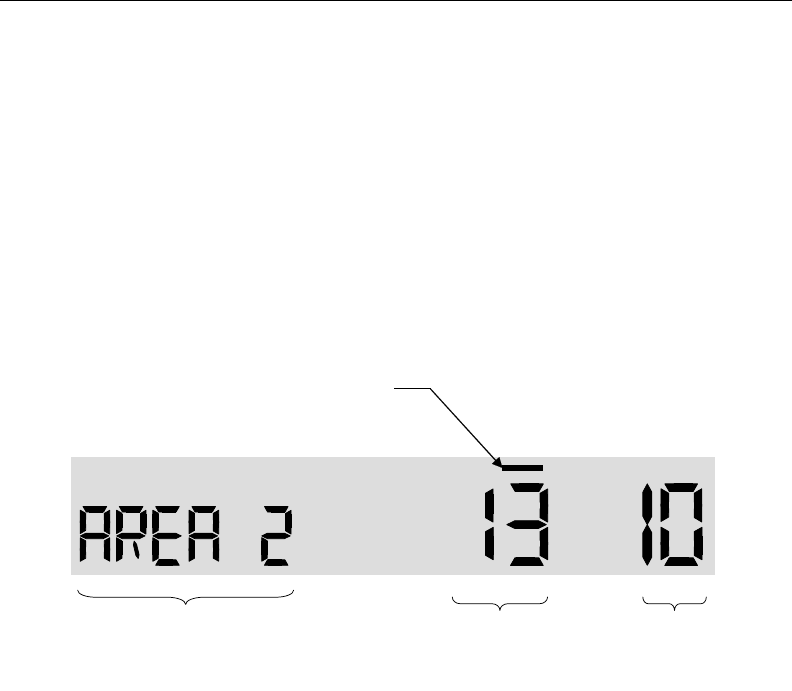
4-6 Viking VM600 Mobile Radio Operating Manual
General Operation
4.1.6 Zone / Channel Display and Select
Zone / Channel Display and Select operate as follows:
4.1.6.1 Zone / Channel Display
The selected zone is shown on the radio display (Figure 4.1). When selected by the Zone/
Channel switch (see Section 4.1.6.3), the select bar will display above the Zone Number.
In addition, the alias text identifier for the selected zone will be shown on the display
screen.
Figure 4.1 Zone Display
Similar to the selected zone, the selected channel is shown on the radio display (Figure
4.2). When selected by the Zone/Channel switch (see Section 4.1.6.3), the select bar will
display above the Channel Number. In addition, the alias text identifier for the selected
channel will be shown on the display screen.
Zone
Number Channel
Number
Zone Select Indicator
Zone Identifier Alias
Draft 4/29/2014
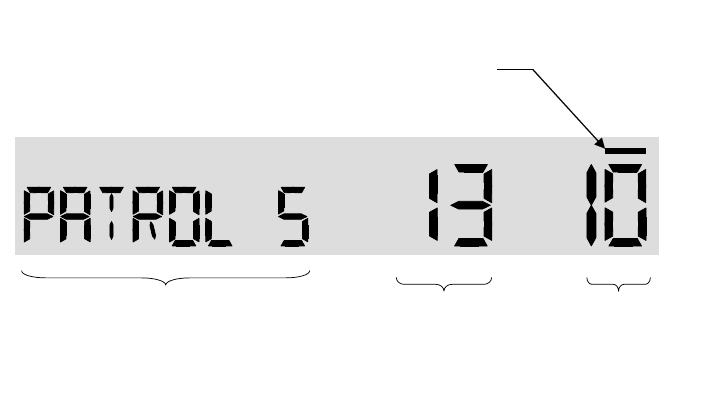
Viking VM600 Mobile Radio Operating Manual 4-7
General Operation
Channel alias can be a combination of zone and channel aliases. With conventional
channels, the channel frequency may be displayed instead of the alias if the Display
Information option switch is programmed (see Section 6.8).
Figure 4.2 Channel Display
If channel scanning is enabled, the channel number will change to show the current active
channel being scanned. The Channel Identifier Alias will also change to identify the
current active scanned channel.
4.1.6.2 Channel Lock Option
A programming option will lock the channel display during scanning. This feature lets the
radio user always see and confirm the selected operating channel for the radio. (The
default is disabled.)
When the option is programmed, the channel number will continue to show the selected
channel only. The Channel Identifier Alias will change to show the current scanned active
channel. If the option is not enabled, then the channel number and alias will both change to
indicate the current scanned active channel as described.
4.1.6.3 Zone / Channel Select
The front panel Select switch is used to change the zone and channel. Pressing this switch
toggles between the zone and channel select modes, and rotating it changes the zone or
channel. An optional beep can be programmed to sound when the switch is pressed or the
channel is changed.
The current mode is indicated by the bar over the zone or channel display. For example,
when the bar is over the zone display (see following illustration), the zone select mode is
enabled.
Zone
Number Channel
Number
Channel Select Indicator
Channel Identifier Alias
Draft 4/29/2014
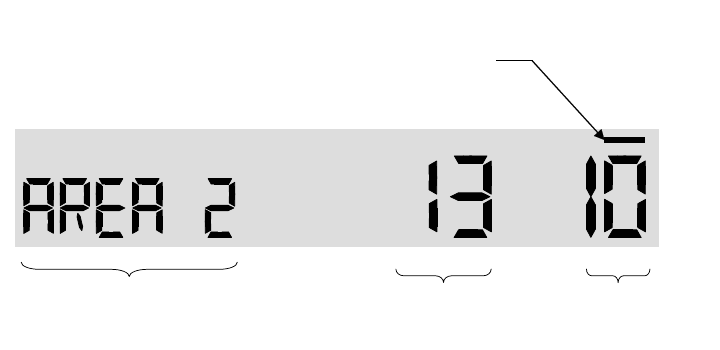
4-8 Viking VM600 Mobile Radio Operating Manual
General Operation
Rotating the Select switch clockwise increases the zone or channel and rotating it
counterclockwise decreases the zone or channel number. A single beep sounds when the
channel is changed (if that option is enabled). After the highest zone or channel is
displayed, wrap-around to the lowest zone or channel occurs and vice versa. If an
unprogrammed channel is selected, “UNPROGRAMD” is displayed and a tone sounds.
The radio may also be programmed so that only programmed channels are selected.
The radio can be programmed so that the bar defaults to either the zone or channel display
when power is turned ON and after a change is made. The delay that occurs before it
returns is programmed for 1-255 seconds. It can also be programmed to remain in the last
selected mode.
4.1.6.4 54-channel/16-zone Feature
This programmable feature allows for more than 16 channels in a zone. When enabled
(using the PCConfigure software), the radio can be configured with up to 16 zones and 54
channels per zone. This feature forces the radio display to switch the zone and channel
number indicators. The zone number will be shown on the far right on the display and
channel number now to the left of the zone number as illustrated in Figure 4.3. The Zone/
Channel Select switch continues to select these functions.
Figure 4.3 54 Channel/16 Zone Display
4.1.6.5 Direct Channel Select
The direct Channel Select feature is available if the Channel Select option switch
parameter is programmed. This feature allows channels to be directly selected using the
HHC numeric keys or Digital Keypad Microphone.
For direct selection purposes, channels are numbered sequentially starting with the lowest
zone. Each zone can be programmed with up to 16 channels, so Zone 1 channels are
numbered 1-16, Zone 2 channels 17-32, and so on as shown below.
Zone
Number
Channel
Number
Zone Select Indicator
Zone Identifier Alias
Draft 4/29/2014

Viking VM600 Mobile Radio Operating Manual 4-9
General Operation
For example, Zone 1/Channel 16 is selected by Channel 16, and Zone 2/Channel 16 is
selected by Channel 32.
Proceed as follows to select channels using this mode:
1Enable the direct Channel Select mode selecting it via the menu or by pressing the
Channel Select option switch. A single beep sounds when the switch is pressed (if that
option is enabled). The alias and sequential number of the current channel are
alternately displayed.
2Select the desired channel using the Up/Down keys or directly enter it using the 0-9
keys. A single beep sounds when the channel is changed (if that option is enabled). If
using the 0-9 keys, the radio attempts to display the entered number after the third digit
is entered or approximately two seconds after the last key is pressed.
3To exit this mode and select the entered channel, press the Channel Select switch again.
This mode is also exited automatically without changing the channel after
approximately one minute of no activity.
Note The Channel Select function should probably not be assigned to a number key because
pressing that key to select a channel then exits the select mode.
Other features of this mode are as follows:
• When using the Up/Down keys, wrap-around to the lowest zone/channel occurs after
the last channel in the highest programmed zone is displayed and vice versa. For
example, if Zone 1/Channel 5 is the highest programmed channel, wrap-around occurs
after Zone 1/Channel 16 is displayed if the “Programmed Channels Only On Display” is
not selected. If “Programmed Channels Only on Display” is selected, the wrap around
occurs at Channel 5.
• When an unprogrammed channel is displayed, the sequential channel number and
“UNPROGRAMD” are alternately displayed.
• If an invalid channel number is entered using the 0-9 keys, or the Channel Select option
switch is pressed with “UNPROGRAMD” displayed, an error tones sounds,
“INVALID” is briefly displayed, and the displayed channel does not change.
4.1.6.6 Favorite Zone Selection
The Favorite Zone feature allows the radio to be programmed to provide users the ability
to setup “Favorite Channels” in one Favorite Zone, and lets the user to edit the channels
without impacting any of the channels already programmed to the zone.
Seq. Ch. No. Zone Channel
1 - 16 1 1 - 16
17 - 32 2 1 - 16
33 - 48 3 1 - 16
Draft 4/29/2014

4-10 Viking VM600 Mobile Radio Operating Manual
General Operation
A “Favorites” button in the Viking VM600 allows the user to add channels to the Favorite
Zone. If The Favorite Zone is enabled, the user has the ability to change the channels that
are in his favorites list, as follows:
1Select the zone / channel to be placed into Favorites, using the zone/channel selectors.
2Press the “Favorites” button (the radio remembers the current zone/channel).
3Turn the Selector knob to the location (1-16) where you want to store this favorite. The
radio will automatically start at the first unprogrammed channel and if all channels are
programmed, the radio will start at Channel 1.
4To store the new channel to the favorites list, press the Select button. The radio will
remain on the channel that was just added to the Favorites list.
5To exit without saving, press the programmed Favorite button (the button you pressed
to enter this mode).
6Upon exit, the radio will remain on the channel that was just added to the Favorites list.
4.1.7 Setting Squelch Control
This radio does not have a squelch control. The squelch level is preset and usually does not
require readjustment. However, if the squelch threshold needs to be changed on a
conventional analog channel, it can be changed using keypad programming if available
(see Section 5.17 on page 36).
Note The Keypad programming feature is available to Federal Government users only.
4.1.8 Transmit Disable
Transmitting can be disabled on each conventional, SMARTNET, SmartZone, and P25
Trunked channel so that the channel is monitor-only. When transmitting is attempted on a
receive-only channel, “RX ONLY” is displayed and an error tone sounds.
4.1.9 Operation At Extended Range
When approaching the limits of radio range, the other party may not be able to hear your
transmissions and there may be an increase in background noise when messages are
received. You may still be out of range even though you can hear a message. The reason
for this is that the signal you are receiving is usually transmitted at a higher power level
than the one transmitted by your radio. Communication may be improved by moving to
higher ground or away from shielding objects such as tall buildings or hills.
Draft 4/29/2014

Viking VM600 Mobile Radio Operating Manual 4-11
General Operation
4.1.10 Preventing Vehicle Battery Discharge
In the standby mode (power on, not transmitting), radio power consumption is relatively
low. Therefore, you can probably leave the radio ON for one or two days without
operating the vehicle and the battery should not become seriously discharged. However, if
the outdoor temperature is low enough to significantly decrease battery capacity, the radio
should be turned OFF when not in use.
Since power consumption is significantly higher when transmitting, it is good practice to
have the vehicle running while transmitting. This ensures that optimum power is being
delivered to the radio and that the battery does not become discharged.
4.1.11 Cleaning the Control Head
The radio Control Head requires periodic cleaning, depending upon the operating
environment.
You will need a soft brush of a size that can access all exposed areas of the Control Head.
You will also need a vacuum cleaner that is portable enough to easily access the Control
Head.
To clean the Control Head:
1Use the brush to remove the bulk of sand and dust from the Control Head.
Ensure that this is done in an environment that does not allow other equipment to be
affected by the removed sand and dust. If necessary, use the vacuum to collect material as
it is removed.
2When the bulk of sand and dust is removed, use the brush to clean the interface joint
between the buttons and Control Head plastic.
3Position the vacuum nozzle two inches (or more, as required) from the face of the
Control Head. Use the brush to remove any remaining sand and dust.
4Repeat this procedure until the Control Head is completely clean.
CAUTION
!
Draft 4/29/2014

4-12 Viking VM600 Mobile Radio Operating Manual
General Operation
4.1.12 Radio Service
If “UNPROGRAMD” is displayed, the cause can be any of the following:
• An unprogrammed channel is selected. Select a programmed channel.
• The selected channel is programmed for an option that is not installed or an error in
programming was detected. Contact your system operator for service.
If no characters or all characters appear in the display, the viewing angle may be
improperly adjusted. Refer to Section 4.1.4 for more information. If some other problem is
occurring, turn power OFF and then ON again to reset the control logic. Also make sure
that the controls are properly set and that the power, external speaker, and accessory cables
(if used) are securely plugged into the back of the radio.
If the radio is completely inoperative, check the power cable fuse that is usually located
near the vehicle battery. If it is blown, remedy the cause if possible and replace it with the
same type (15A). If the radio still does not operate properly, return it to your system
operator for service.
Note There are no user-serviceable components in the radio. Altering internal adjustments can
cause illegal emissions, void the warranty, and result in improper operation that can
seriously damage the radio.
Draft 4/29/2014

Viking VM600 Mobile Radio Operating Manual 4-13
General Operation
4.2 Operating Modes
Each selectable channel can be programmed for the conventional (analog or Project 25
digital), SMARTNET/SmartZone, or Project 25 digital trunked operating mode. For
example, Zone 1/Channel 1 could be a conventional channel, Zone 1/Channel 2 a
SMARTNET channel, and so on. More information on these modes follows.
Note All operating modes utilize certain functions that are activated/deactivated by pressing
and holding a particular button or switch. The “hold” interval is preset. When instructed
to “press and hold”, do so until the desired action occurs. For other operations (not
specified “press and hold”) only momentary pressing is required.
4.2.1 Conventional Mode
This is a non-trunked operating mode which accesses independent radio channels. There is
no automatic access to several channels. Selecting a conventional channel selects a
transmit and receive frequency and other channel parameters such as squelch control
coding.
Conventional channels can be either standard (analog) or Project 25 (digital). With digital
operation, the DSP (Digital Signal Processor) converts the audio signal to digital data
packets. Another difference is that analog channels use Call Guard (CTCSS/DCS) squelch
control and Project 25 channels use a NAC (Network Access Code) and talkgroup ID
codes.
With Project 25 operation, a NAC is transmitted which must match the NAC programmed
in the Repeater or Base Station equipment and the radio(s) being called for
communication to occur. In addition, to receive standard group calls, the receiving radio
must be programmed to detect the transmitted talkgroup ID code.
With conventional operation, a busy channel condition is detected automatically if the
busy channel lockout (transmit disable on busy) feature is programmed. Otherwise, it must
be detected manually. An out-of-range condition is not indicated by special tones or
messages as with SMARTNET operation because there is no initial data exchange with
the repeater that allows this condition to be detected. Operating features unique to
conventional channels are described in Section 6.
4.2.2 SMARTNET / SmartZone Mode
This is a trunked operating mode in which automatic access is provided to several RF
channels. ID codes are used to select what radios are being called and what calls are
received. Monitoring is performed automatically and special messages and tones indicate
busy and out-of-range conditions.
Draft 4/29/2014

4-14 Viking VM600 Mobile Radio Operating Manual
General Operation
SMARTNET and SmartZone operation and programming is very similar. Basically,
SMARTNET operation is limited to a single repeater site and SmartZone operation allows
automatic roaming between sites. SMARTNET/SmartZone features include roaming
(SmartZone only), telephone, private, and emergency calls, Call Alert™, and messaging.
Either analog or digital signaling may be used. Enhanced SMARTNET/SmartZone
features provide the same, plus gives you responses from the system. For example, if the
ID you are calling is turned OFF, the system will display “NOT AVAILABLE”.
When a SMARTNET or SmartZone channel is selected or the radio is powered up on one
of those channels, it searches for a control channel. While searching, the alias (name) of
the selected channel is displayed and the radio attempts to register on the trunked system.
If a control channel could not be found (because of an out of range condition or the system
ID is not correct, for example), “NO SYS” (early units) or “OUT OF RNG” (later units) is
displayed and the radio continues to search for a control channel.
The control channel transmits and receives system information to and from all radios
registered on the system. Therefore, once a control channel is found, it is continuously
monitored for incoming call information and is used to make call requests. When the radio
is keyed, a channel grant request is sent through the control channel. The system then
informs the requesting radio what traffic channel to use, through the control channel. Once
the request is granted by the system, the radio moves to the designated traffic channel for
the actual talkgroup call. Once the transmission has ended, the radio returns to the control
channel.
Operating features unique to SMARTNET/SmartZone channels are described in
Section 7.
4.2.3 P25 Trunked Mode
The P25 Trunked operating features are very similar to the SmartZone type just described.
Since SmartZone features are also similar to SMARTNET features, all three modes are
described in Section 7. Some differences between the P25 Trunking and SmartZone
modes are as follows:
• Digital signaling is always used with P25 calls. Either analog or digital signaling may be
used for SmartZone calls.
• Calls made to a specific radio in the P25 mode are called Unit Calls. In the
SMARTNET/SmartZone mode they are called Private Calls.
• Messaging is not available with P25 calls.
• Telephone calls are available in this mode.
• The P25 control channel data rate is 9600 baud and the digital voice data rate is also
9600 baud. With SmartZone operation, the control channel data rate is 3600 baud (both
digital and analog calls) and the narrowband digital voice data rate is 9600 baud.
Draft 4/29/2014

Viking VM600 Mobile Radio Operating Manual 4-15
General Operation
• The P25 mode uses a system ID, Wide Area Communications Network (WACN) ID,
and RF Subsystem ID (RFSS). The SmartZone mode does not use the WACN and
RFSS IDs.
• P25 Unit IDs can be 1-16,777,215 (000001-FFFFFF hex) and SmartZone Unit IDs can
be 1-65,535 (0001-FFFF hex).
4.2.4 Systems, Channels, and Zones
A zone and channel are selected to place and receive calls. The following describes the
relationship between systems, channels, and zones.
4.2.4.1 Systems
A system is a collection of channels or talkgroups belonging to the same repeater site. It
defines all the parameters and protocol (system) information required to access a site.
When a system is added, you specify the type belonging to the same repeater site or
“multi-site” network - i.e., Conventional, SmartNet, SmartZone or P25 Trunking. Up to 16
systems of any type can be programmed.
The maximum number of channels assignable to a system is limited to 864, depending on
the option enabled. Channels may also be limited by available memory space as described
in the following information.
4.2.4.2 Channels
A channel selects a radio (RF) channel or talkgroup as follows:
Conventional Analog Mode - A channel selects a specific radio channel, Call Guard
(CTCSS/DCS) squelch coding, and other parameters unique to that channel.
Conventional Project 25 Mode - A channel selects a specific radio channel, NAC
squelch coding, talkgroup ID, and other parameters unique to that channel.
SMARTNET/SmartZone and Trunked Project 25 Modes - A channel selects a
specific talkgroup, announcement group, emergency group, and other parameters
unique to that talkgroup.
A maximum of up to approximately 864 channels (depending on the option enabled) can
be programmed with the preceding modes. These channels can belong to a single system
or multiple systems. The maximum number is also limited by the available memory. For
example, since more memory is required to program a SMARTNET system than a
conventional system, the total number of channels decreases as the number of
SMARTNET channels increases.
Draft 4/29/2014
4-16 Viking VM600 Mobile Radio Operating Manual
General Operation
4.2.4.3 Zones
A zone is a collection of up to 16 channels of any type. For example, a zone could include
12 conventional channels and four SMARTNET channels. One use of zones may be to
program the channels used for operation in a different geographical areas. The maximum
number of zones is 32 or 54 depending on the option enabled.
Draft 4/29/2014
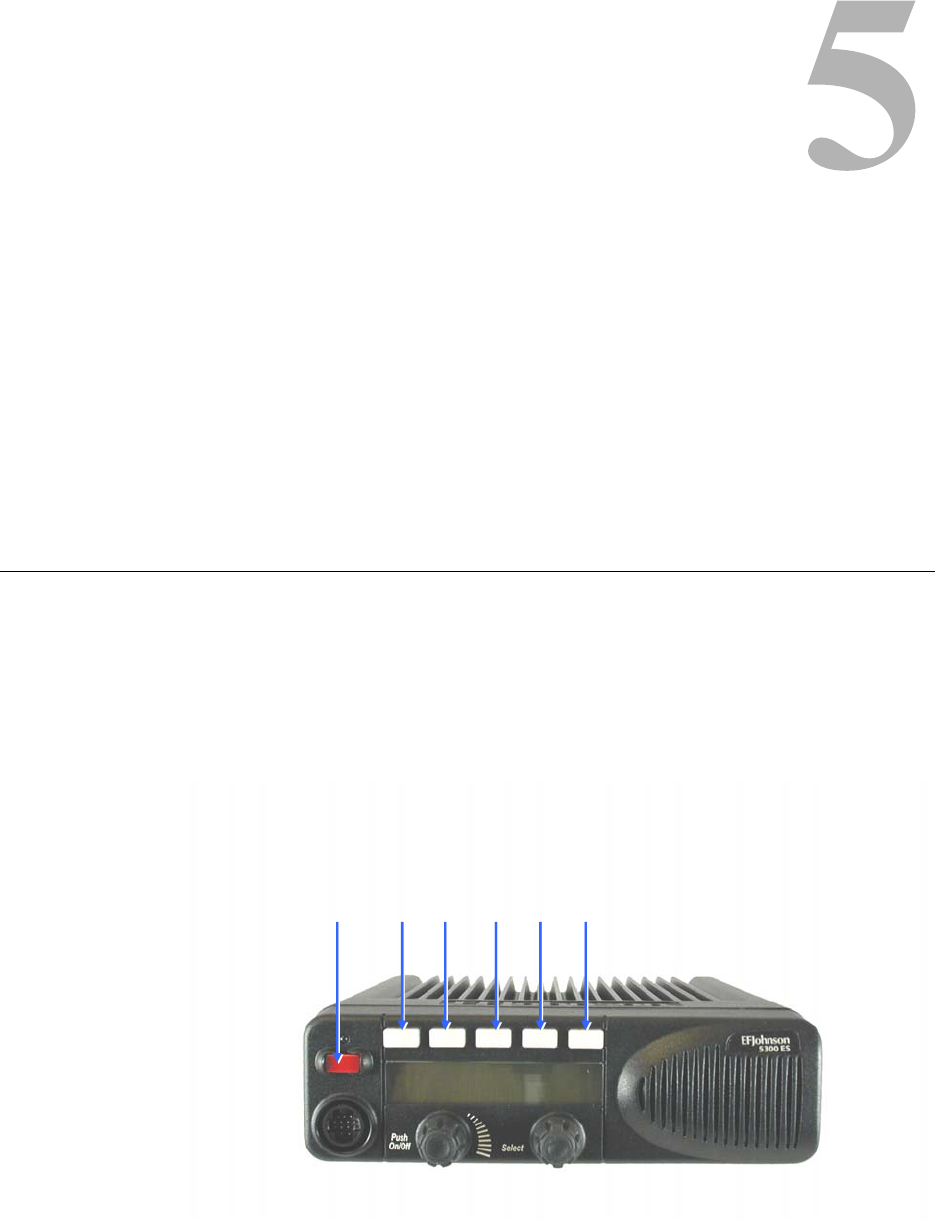
Viking VM600 Mobile Radio Operating Manual 5-1
SECTION
Section5Radio Wide Features
Radio wide features are features common to all operating modes.
5.1 Option Buttons
Six option buttons on the front panel (one is located to the left of the display) can be
programmed to control a different set of functions for each of the three operating modes.
Therefore, up to 18 different functions can be controlled by these buttons (six each for
conventional, SMARTNET/SmartZone, and P25 Trunking).
Figure 5.1 Option Buttons
Programmable Option Buttons
F1 F2 F3 F4 F5 F6
Draft 4/29/2014

5-2 Viking VM600 Mobile Radio Operating Manual
Radio Wide Features
The available functions in each mode are shown in Table 5.1.
Table 5.1 Programmable Option Button and Menu Mode Functions
Function
X = Available in Mode:
Menu DisplayConventional Project 25
Trunking SMARTNET SmartZone
Activate OTAP X ACTV OTAP
Alert tones On-Off X X X X TONES
Auto Site Search X X X AUTO SITE
Backlight Hi/Med/Off X X X X BACKLIGHT
Call Alert Select (Paging) X X X X CALL ALERT
Call Response Select X XX CALL RSP
Cancel Dynamic Regroup X X X CANCEL DR
Change Keyset (OTAR) X X X X CHG KEYSET
Channel Select X X X X CHAN SELCT
Clear/Secure Encryption Select X X X X SECURITY
Data Modes X DATA MODES
Digital (Project 25) Talkgroup
Select XSELECT TG
Disable Call Guard X
Display GPS XX X XGPS
Display Information Select
(frequency or channel display) X DISPLAY
Emergency Mode Select X X X XEMERGENCY
Emergency Clear X EMERG CLR
Erase Keys, OTAR X X X X ERASE KEYS
External Public Address X X X X EXTERNAL PA
Favorite Channels X X X X FAVORITES
Group Scan GRP SCAN
High/Low Power Select X X X X TX POWER
Home X X X XHOME
Home 2 X X X XHOME 2
Horn Honk Select X X X X
Key Select, OTAR X X KEY SELECT
Keypad Programming Select X KEYPAD PRG
Messaging Select X X X MESSAGE
Monitor Mode Select XMONITOR
Mute/Unmute X X X X AUDIO MUTE
Normal/Selective Squelch Select X SQUELCH
P25 Packet Data XX DATA MODES
Phone Call Select X X X X PHONE
Priority Channel Select X PRIORITY
Private Call Select X X PRIV CALL
Radio Information X X X X RADIO INFO
Shaded features support the secondary press and hold function.
Draft 4/29/2014
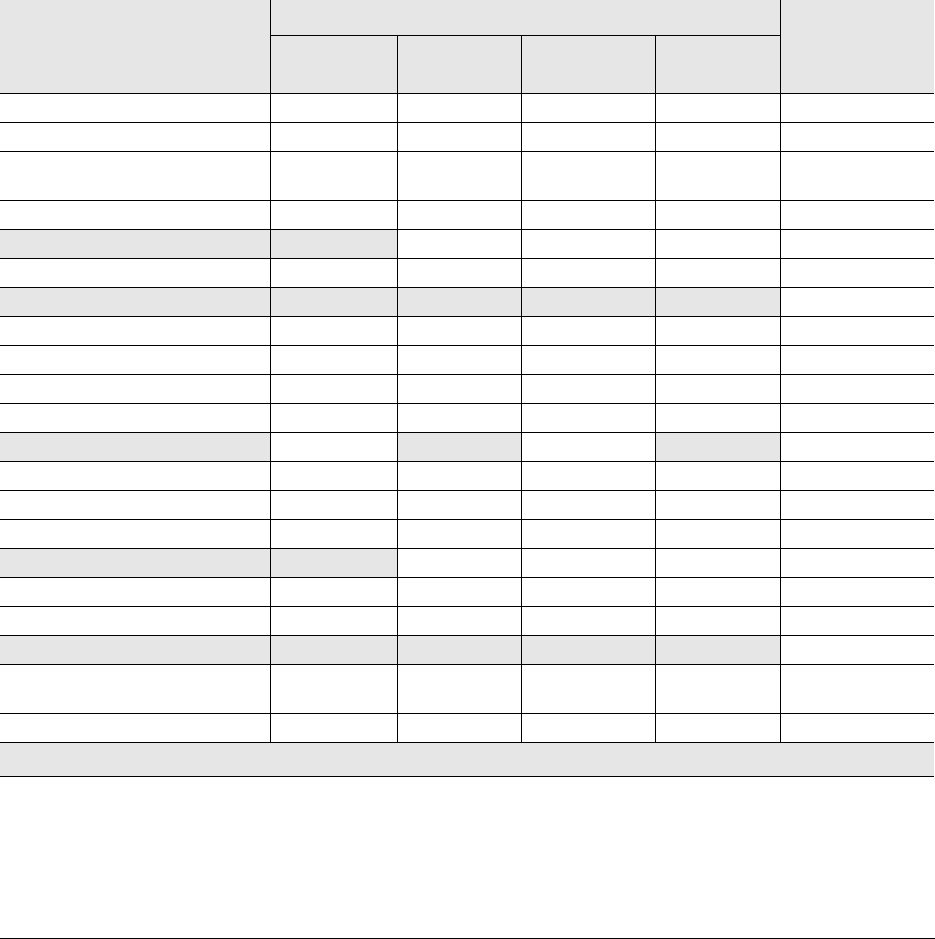
Viking VM600 Mobile Radio Operating Manual 5-3
Radio Wide Features
5.2 Menu Mode
To enter menu mode on the Viking VM600, press and hold the “Select” button.
To scroll through the items on the menu list, turn the select switch to the desired item.
To select the desired item, once again press the “Select” button. A single beep sounds
when the switch is pressed (if that option is enabled).
To exit menu mode on the standard control head, press <F6> (<F5> for Lightning head).
To exit menu mode on the HHC, press <F5>.
Radio Wide Scan Select X X X X RW SCAN
Rekey Request X OTAR REKEY
Remote Access (Pyramid
Repeater) X X X X RMT ACCESS
Repeater Talk-Around Select X TALK ARND
Request to Talk XRTT
RWS List Edit X X X X RWS EDIT
Scan Mode Select X X X XSCAN
Scan List Edit Select X X X X SCAN EDIT
Scan List Select X X X SCAN SELCT
Set User Password X X X X SET PASWD
Site Lock Select X X SITE LOCK
Site Search Select XXSITE SRCH
Squelch (Code) Select List X SQLCH CODE
Status Select X X X X STATUS
Surveillance Mode Select X X X X SURV MODE
Text Messaging XTEXT MSG
Tone Volume Edit - Alert X X X X ALERT VOL
Tone Volume Edit - Keypad X X X X KEYPRS VOL
Unit Call Select X X UNIT CALL
Unprogrammed
(Note The button is not used.)XX X X
Zone Select X X X X ZONE SELCT
Table 5.1 Programmable Option Button and Menu Mode Functions (Continued)
Function
X = Available in Mode:
Menu DisplayConventional Project 25
Trunking SMARTNET SmartZone
Shaded features support the secondary press and hold function.
Draft 4/29/2014

5-4 Viking VM600 Mobile Radio Operating Manual
Radio Wide Features
5.3 Time-Out Timer
The time-out timer disables the transmitter if it is keyed for longer than the programmed
time. It can be programmed on each channel for times of 15 seconds to 3 minutes, 45
seconds or it can be disabled.
If the transmitter is keyed continuously for longer than the programmed time, the
transmitter is disabled, a continuous tone sounds, and “TX TIMEOUT” is displayed. Five
seconds before time-out occurs, a warning beep sounds to indicate that time-out is
approaching. The timer and tone are reset by releasing the PTT switch.
A different time can be programmed for each system, and the timer can be enabled or
disabled on each conventional channel. With conventional channels, a penalty time can
also be programmed that prevents further transmissions for a certain time after the
transmitter is disabled (see Section 6.5).
One use of this feature is to prevent a channel from being kept busy for an extended period
by an accidentally keyed transmitter. It can also prevent possible transmitter damage
caused by transmitting for an excessively long period.
5.4 Home Channel Select
If the HOME option switch is programmed, pressing it selects the preprogrammed home
channel. This provides a quick way of returning to a frequently used channel. Pressing and
holding this switch until a tone sounds makes the currently selected channel the new
Home. (The radio can be programmed to ignore this press-and-hold function). The radio is
also programmed so that either the home or last selected channel is automatically selected
when power is turned on (see Section 4.1.1). A secondary Home, Home2, may also be
programmed.
Note The radio can be optionally programmed so that Pressing and holding the Home option
switch causes the radio to switch to the existing Home or Home 2 instead of making the
current selection the new Home.
5.5 Power Output Select
Each conventional channel and SMARTNET/SmartZone and P25 Trunked system can be
programmed for High, Low, or Switchable transmit power. If Switchable power is
programmed on the channel or system, the Tx PWR option switch can then be used to
select high or low transmitter power. All models support switchable power.
Draft 4/29/2014

Viking VM600 Mobile Radio Operating Manual 5-5
Radio Wide Features
Pressing the TX PWR switch toggles the power setting. The new level is flashed in the
display when this switch is pressed as “HI POWER” or “LOW POWER”. If selectable
power is not permitted on the current channel or system, the fixed power level is flashed
and no power change occurs. The selected power level is permanent until it is manually
changed again. The power levels are set at the factory or when the radio is tuned using the
PCTune™ software.
5.6 Alert Tone Select
The various alert tones that sound are described in Section 10.1. These tones can be
enabled and disabled if the TONE option switch is programmed. To turn all tones OFF,
press this switch and “TONE OFF” is displayed. Then to turn all tones on again, press it
and “TONE ON” is displayed. If this switch is not programmed, tones are fixed in the ON
or OFF condition by programming. Alert tones can be disabled depending on
programming.
The Alert Tone volume can be adjusted relative to the volume control setting. This is done
by programming and also by the user if the TN VOL option switch is programmed.
Relative levels of –170 to +170 can be set with “0” the default setting. A minus value
decreases the tone volume and a plus value increases it. The user adjusted level
permanently overrides the programmed level if applicable.
5.7 Power Turn-Off Delay
The radio can be installed so that the vehicle ignition switch as well as the front panel
power switch of the radio control power. This is done by connecting the accessory cable
ignition switch input to the vehicle ignition switch. Refer to the Viking VM600
Installation Manual for more information. A power-off delay of up to 510 minutes can
then be programmed, or this feature can be disabled by programming “Infinite” delay so
that there is no automatic power-off.
Both the ignition switch and the power switch must then be on for radio power to turn on.
The delay can be overridden at any time by turning power OFF using the front panel
power switch or turning the ignition switch back ON.
This turn-off delay can allow calls to be received or the horn alert to be active for a time
after the ignition switch is turned OFF. At the same time, advantages of ignition switch
control are used such as preventing the battery discharge that may occur if the radio is left
ON for an extended period.
Draft 4/29/2014

5-6 Viking VM600 Mobile Radio Operating Manual
Radio Wide Features
5.8 Horn Alert
The horn alert feature sounds an external alert such as the vehicle horn when certain calls
are received. It is available if a Horn option switch is programmed and the proper
connection has been made to the external alert. The horn alert output is pin 4 of the
accessory cable, and an external driver circuit of some type is usually required. Refer to
the Viking VM600 Installation Manual for more information on how to install this feature.
Additional information on the horn alert feature follows:
• It activates when receiving any Unit call in the P25 conventional mode and any Private/
Unit and Call Alert (paging) call in the SMARTNET/SmartZone and P25 Trunked
modes. It does not sound when receiving standard Group or telephone calls, and is not
programmable on a per call basis.
• It must be manually enabled and disabled by the Horn option switch. It is not controlled
by the vehicle ignition switch. When it is enabled, “HORN ON” is briefly displayed,
and when it is disabled, “HORN OFF” is briefly displayed. It defaults to the OFF mode
whenever power is turned on.
• If a power turn-off delay is programmed as just described, it is functional during that
delay.
• When activated, it can be programmed to sound for three 1-second beeps or
continuously for 2-90 seconds. It then turns OFF until another Unit call is received.
5.9 Microphone Off-Hook Detect
The microphone hanger can be connected to chassis ground and the radio programmed to
detect an off-hook condition (Hangup Box Monitor selected). The following operation
then occurs when the microphone is taken off-hook:
Conventional Channel Selected - Scanning temporarily halts (if applicable) and the
Monitor Mode described in Section 6.2 is enabled. However, the receiver unsquelches
only if a carrier is detected.
SMARTNET/SmartZone/P25 Trunked Channel Selected - Scanning temporarily
halts if applicable.
If the off-hook condition is not detected (Hangup Box Monitor not selected), the
microphone hook state has no affect on radio operation.
Draft 4/29/2014

Viking VM600 Mobile Radio Operating Manual 5-7
Radio Wide Features
5.10 Surveillance Mode
If the Surveillance mode is programmed, the backlight, all alert tones, and front panel
LED indicator can be disabled individually or totally, based on programming.
The transmit/receive LED indicator, display and keypad backlight, and all alert tones can
be disabled. When setting is enabled, the radio will power up in Surveillance mode with
the selected options active. A function button can also be assigned which will activate and
deactivate surveillance mode at the user’s discretion. It overrides any other programming
of these functions such as a Tone or Backlight option switch.
This feature can be turned ON and OFF by the user via menu selection or by the SURVLC
option button (if programmed). The user selected mode permanently overrides the
programmed mode if applicable.
5.11 Public Address
This feature allows a single microphone to be used for either radio or public address. An
external public address system can be connected to pin 7 of the radio accessory pigtail
cable. This is a low level output, so some sort of PA amplifier is required. The External PA
option button (or menu selection) control this feature.
In the public address mode, microphone audio is always routed to the PA system, and the
radio can be programmed so that receive audio is also routed. When the PA is enabled/
disabled, “EXT PA ON/OFF” is displayed momentarily. The radio can also be
programmed to display “EXT PA ON” continuously.
If “Ext PA Mute” is enabled by Armada, when the radio code toggles the external PA mute
line, the auxiliary B output line will also be toggled. This allows users to mute their own
PA at the same time that the radio throws the eternal PA switch.
Draft 4/29/2014
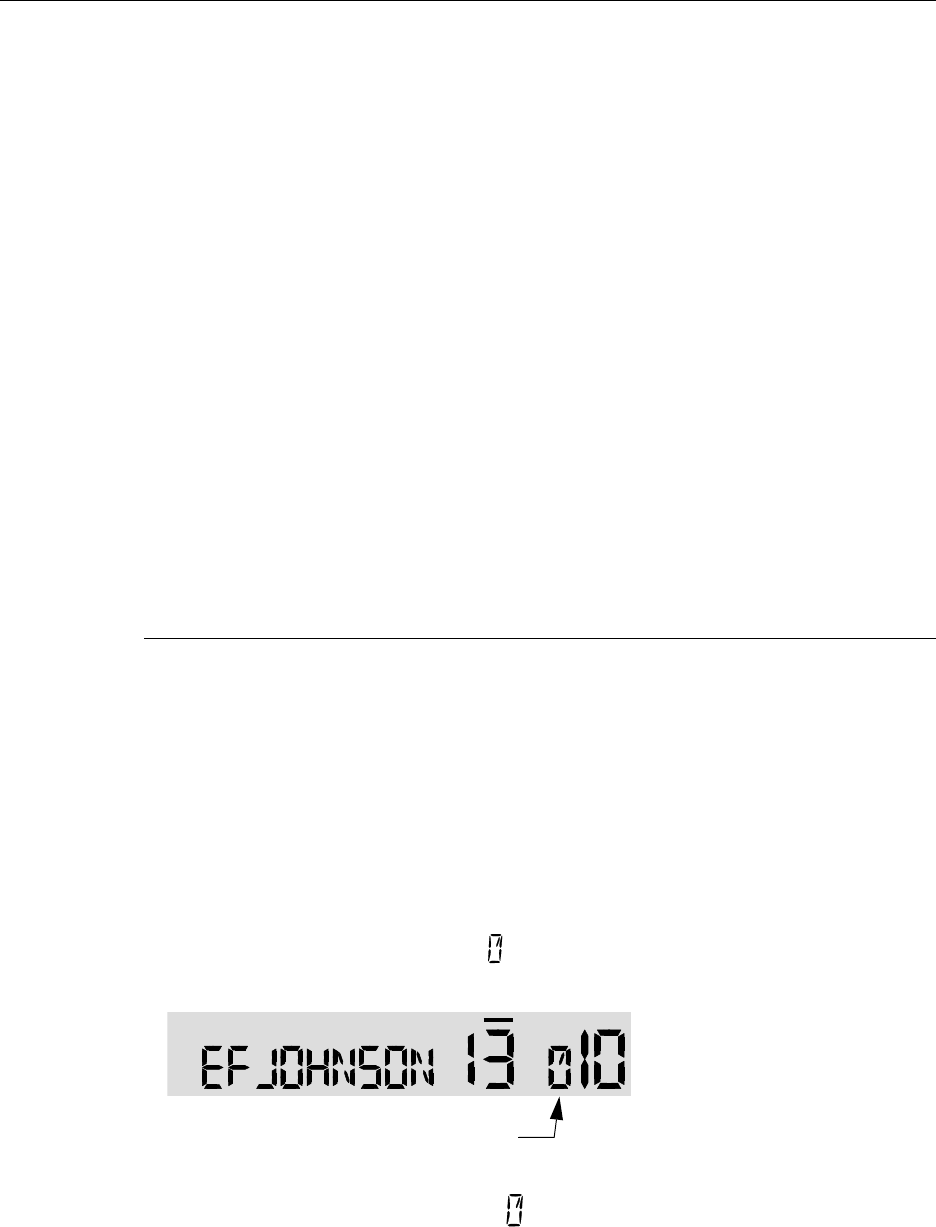
5-8 Viking VM600 Mobile Radio Operating Manual
Radio Wide Features
5.12 Scanning
Scanning monitors the channels in the scan list for messages the radio is programmed to
receive. When a message is detected, scanning stops and the message is received. Shortly
after the message is complete, scanning resumes.
If the microphone off-hook condition is detected (Hangup Box Monitor selected by
programming), scanning stops and selective squelch (such as Call Guard CTCSS or NAC/
group ID detect) is disabled on conventional channels. If the microphone off-hook
condition is not detected (Hangup Box Monitor is not programmed), taking the
microphone off-hook has no affect on radio operation. When a call is received in the scan
mode, the alias of the channel on which a call is received (and any other display
parameters that may be programmed) are displayed until scanning resumes. The selected
channel alias is then displayed if applicable.
There are two scan modes available: Priority (standard) and Radio Wide. The operation of
the priority type is unique to the system type programmed on the selected channel, and the
operation of the Radio Wide type is the same regardless of the system type programmed
on the selected channel. Only one type of scanning can be enabled at a time. For example,
if priority scanning is enabled and Radio Wide Scan is enabled, priority scanning is
automatically disabled and vice versa. Refer to the following for more information.
5.12.1 Priority (Standard) Scanning
Priority scanning (also referred to as standard scanning) monitors only channels that are
the same type as that currently selected. For example, if a conventional channel is selected,
only conventional channels are scanned and likewise for SMARTNET/SmartZone and
Project 25 trunked channels.
For more information on scanning functions in the Conventional mode, refer to Section
6.10, and for more information on how it functions in the other modes, refer to Section
7.11. Scanning is turned ON and OFF by menu selection or (if programmed) by the Scan
option switch as follows.
• To turn priority scanning on, press the SCAN option switch (or select via menu).
Scanning is enabled when a rotating is indicated in the right status display as follows
and “SCAN ON” is briefly displayed.
• To turn scanning OFF, press the SCAN option switch again. Scanning is disabled when
“SCAN OFF” is briefly displayed and is no longer indicated in the status display.
Scan Enable Indicator
Draft 4/29/2014

Viking VM600 Mobile Radio Operating Manual 5-9
Radio Wide Features
• If the zone or channel is changed while scanning is selected, scanning continues on the
same or a different scan list (see Section 5.13.1).
Note Each SMARTNET/SmartZone and P25 trunked channel can be programmed so that
scanning is automatically enabled when the channel is selected.
5.12.2 Radio Wide Scanning
Radio wide scanning monitors the channels in the preprogrammed radio wide scan list.
This scan list may contain up to 16 channels of any type assigned to any zone (see Section
5.13.2). Radio wide scanning is turned ON and OFF by menu selection or by the RWS
option switch (if programmed) as follows:
Note Use radio wide scanning only if two different types of channels need to be scanned at the
same time such as conventional and SMARTNET/SmartZone. Otherwise, use the more
efficient priority scanning because there is less chance of missed calls.
• To turn radio wide scanning on, press the RWS option switch and “RW SCN ON” is
briefly displayed. In addition, is displayed along with an R in the left Status position.
• To turn radio wide scanning OFF, press the RWS option switch again and “RW SCN
OFF” is briefly displayed and with R is no longer displayed.
• If the zone or channel is changed while radio wide scanning, scanning continues
normally.
5.12.3 Scan Hold Time
When a message is received or transmitted while scanning, there is a delay before
scanning resumes. The delay after receiving a call prevents another message from being
received before a response can be made. The delay after transmitting a call ensures that a
response is heard instead of another message occurring on some other channel.
Separate delay times are programmable for radio wide and priority scanning. With radio
wide scanning, delays of 2-7.5 seconds can be programmed. With priority scanning,
delays of 0-7.5 seconds can be programmed. With SMARTNET/SmartZone and P25
Trunked scanning, scan delays of 0-8 seconds can be programmed.
5.12.4 Transmitting in the Scan Mode
Priority Scan Mode - When the transmitter is keyed while scanning is enabled, the
transmission may occur on various channels as follows.
Draft 4/29/2014

5-10 Viking VM600 Mobile Radio Operating Manual
Radio Wide Features
Conventional Operation - Transmissions can be programmed to always occur on
the priority, selected, or receive channel (if applicable). Refer to Section 6.10 for
more information.
SMARTNET/SmartZone/P25 Trunked Operation - If scanning is halted to
receive a message, programming determines if transmissions occur on the selected or
active channel. Transmissions at other times occur on the selected channel.
Radio Wide Scan Mode - The radio can be programmed to transmit on the selected or
active channel similar to SMARTNET/SmartZone and P25 trunked operation just
described.
5.12.5 Nuisance Channel Delete
With priority scanning, channels can be temporarily deleted from the scan list, for
example, if messages become annoying. This feature is not available with radio wide
scanning. Channels can also be permanently added or deleted from a scan list as described
in the next sections. Proceed as follows to temporarily delete a channel:
Note The selected channel and also conventional priority channels cannot be deleted from the
scan list.
1While receiving a message on the channel to be deleted, press and hold the SCAN
option switch until a tone sounds (approximately 0.5 second). The channel is then
deleted and scanning of the remaining channels in the scan list resumes.
Note Pressing and holding this switch with scanning OFF may select the scan list. Refer to
Section 6.10.1 for more information.
2Deleted channels are added back into the scan list if any of the following events occur:
- Scanning is turned OFF and then ON again using the SCAN option switch.
- Radio power is turned OFF and then ON again.
- The scan list is reselected by changing channels (SMARTNET/SmartZone) or using
the SCAN option switch (conventional).
Draft 4/29/2014
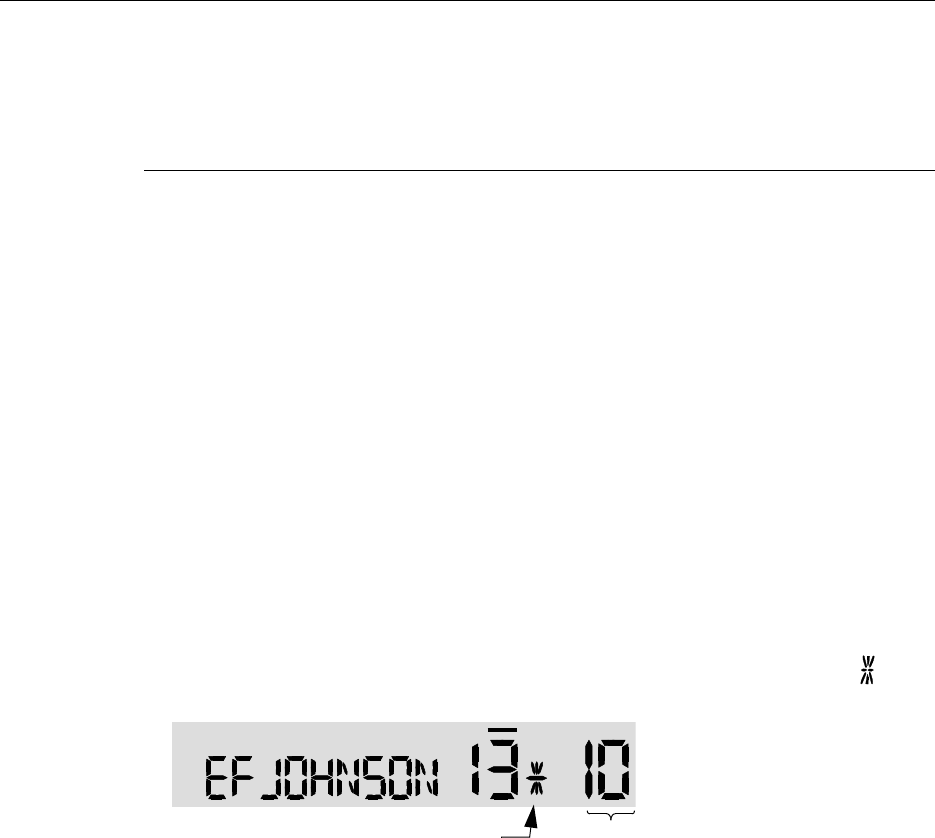
Viking VM600 Mobile Radio Operating Manual 5-11
Radio Wide Features
5.13 Scan Lists
Priority and Radio Wide Scan lists can be programmed.
5.13.1 Priority Mode Scan Lists
A scan list is simply the channels that are scanned when scanning is enabled. With all
operating modes, as many priority scan lists as are required can usually be programmed
(up to 255). The only limitation is the available memory. Each list can include up to 256
channels/talkgroups. More information follows on selecting and editing priority scan lists.
Note The selected channel is always scanned.
5.13.1.1 Determining Channels in Priority Scan List
Channels in the conventional priority scan lists are determined as follows. Channels in the
SMARTNET/SmartZone/P25 Trunked priority scan lists are indicated only when editing a
list (see “Editing a Priority Scan List”).
1Enable Priority scanning as described in Section 5.12.1. Also select the scan list if
applicable as described in the following “Selecting a Priority Scan List” description.
2Select the desired zone and then scroll through the channels by rotating the Select
switch. When the displayed channel is in the scan list (scanned normally), the
symbol is displayed next to the zone number as shown in the following illustration.
5.13.1.2 Selecting a Priority Scan List
Conventional Operation - The scan list is user selectable by the SCAN option switch.
Refer to Section 6.10.1 for more information.
SMARTNET/SmartZone/P25 Trunked Operation - The scan list can be temporarily
changed if the Scan (List) Select option switch is programmed or by pressing/holding the
scan button. Refer to Section 7.11.2 for more information.
Both of the above operations are also menu selectable.
Note Only Priority scan lists are selectable.
Scan List Indicator Channe
Number
Draft 4/29/2014

5-12 Viking VM600 Mobile Radio Operating Manual
Radio Wide Features
5.13.1.3 Editing a Priority Scan List
If the SCN ED (Scan Edit) option switch is programmed, priority scan lists can be user
edited as follows (all operating modes). This option is also selectable via the menu.
Changes are permanent (cycling power does not reselect a default condition). Proceed as
follows:
1Make sure that both priority and radio wide scanning are OFF (the rotating icon is
not indicated in the right status display). Select a conventional, SMARTNET/
SmartZone/P25 Trunked channel corresponding to the scan list being edited.
2Select the scan list edit mode by pressing the SCN ED option switch. This mode is
indicated by a triangle in the upper left corner of the display (see Figure 2.3).
3If applicable, select the list to be edited by rotating and then pressing the Select switch.
A single beep sounds when the switch is pressed (if that option is enabled). The
selected scan list is indicated as “LIST x” as described in the preceding section. If user
programming is disabled on a list (conventional channels only), “NO EDIT” is
momentarily displayed and it cannot be edited.
4Select the channel you want to add or delete by rotating the Select switch. After the last
channel in the current zone is displayed, the first valid channel in the next zone is
displayed and vice versa. Lists are limited to 256 channels. If an attempt is made to add
more than 256, “LIST FULL” is displayed and a channel must be deleted before
another can be added.
Note Priority channels can be deleted.
5If the selected channel is in the scan list (scanned), the symbol is displayed next to
the zone number as just described. To change the scan list status of the displayed
channel, press the Select switch. A single beep sounds when the switch is pressed (if
that option is enabled).
With conventional channels only, if the selected scan list is programmed with fixed
priority channel(s), the next press of the Select switch makes the current channel the
priority channel indicated by “P” in the left status display next to the zone number. If
dual priority channels are used, pressing the Select switch again makes it the second
priority channel indicated by “2” in the left status display. Then pressing the Select
switch again takes the channel out of the scan list. Refer to Sections 6.10.2 and 6.10.3
for more information on priority channel sampling.
6To exit this mode and save the changes, press the SCN ED option switch again.
Draft 4/29/2014
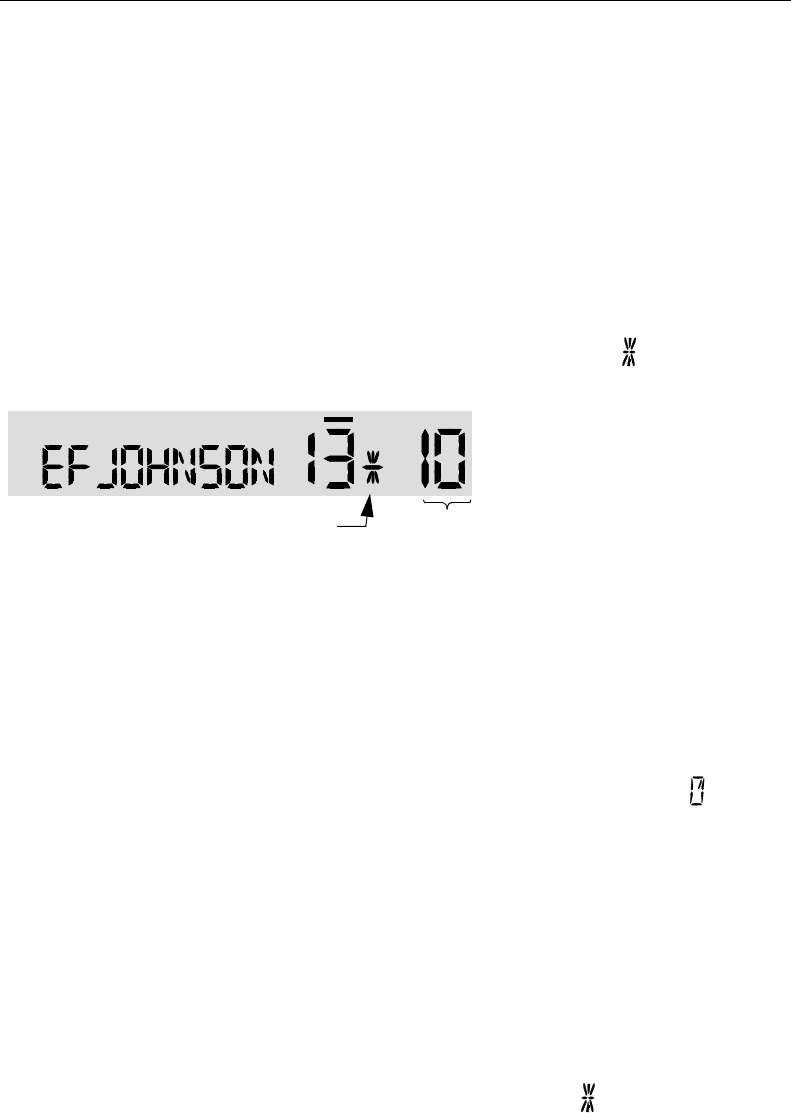
Viking VM600 Mobile Radio Operating Manual 5-13
Radio Wide Features
5.13.2 Radio Wide Scan List
With radio wide scanning, there is only one scan list available regardless of the type of
channel selected. This list is user programmable and can include up to 16 channels of any
type. For example, it could include six conventional channels and ten SMARTNET/
SmartZone channels. More information on selecting and editing radio wide scan lists
follows.
5.13.2.1 Determining Channels in Radio Wide Scan List
The channels can be determined only by selecting the scan list edit mode (see “Editing
Radio Wide Scan List” which follows).
When the displayed channel is in the scan list (scanned normally), the symbol is
displayed next to the zone number as shown in the following illustration.
5.13.2.2 Editing a Radio Wide Scan List
If the RWS ED option switch is programmed, the radio wide scan list can be edited.
Changes are permanent (cycling power does not reselect a default condition). Proceed as
follows:
1Make sure that both priority and radio wide scanning are OFF (the rotating icon is
not indicated in the right status display). Select the scan edit mode by pressing the RWS
ED option switch. This mode is indicated by a triangle in the upper left corner of the
display (see Figure 2.3).
2Select the channel you want to add or delete by rotating the Select switch. A single
beep sounds when the channel is changed (if that option is enabled). After the last
channel in the current zone is displayed, the first valid channel in the next zone is
displayed and vice versa. The list is limited to 16 channels. If an attempt is made to add
more than 16, “LIST FULL” is displayed and a channel must be deleted before another
can be added.
3If the selected channel is in the scan list (scanned), “R” and the symbol are displayed
next to the zone number. To change the scan list status of the displayed channel, press
the Select switch. A single beep sounds when the switch is pressed (if that option is
enabled).
4To exit this mode and save the changes, press the RWS ED option switch again.
Scan List Indicator Channe
Numbe
Draft 4/29/2014

5-14 Viking VM600 Mobile Radio Operating Manual
Radio Wide Features
5.14 Global Positioning System (GPS)
If this feature is enabled, GPS data can be received from satellites when a GPS receiver is
attached to the serial port of the radio. GPS data can be viewed using P25, Conventional,
MultiNet, and SMARTNET/SmartZone Systems.
5.14.1 Viewing GPS Data
To use the GPS feature (on a properly configured radio):
1Connect the cable from the GPS receiver to the Accessory Cable on the back of the
radio (see Figure 2.8).
2Press the assigned GPS button (or select GPS from the menu). “NO SAT REC” will
display initially.
3Wait until the GPS receiver acquires enough satellites to obtain a valid position fix.
Note It may take up to 10 minutes, depending upon signal conditions, for the GPS receiver to
obtain a position fix. During this time “No Sat Rec” is displayed. Failure of data to
appear indicates that the receiver was unable to obtain a fix.
When the system acquires a fix, one of the following GPS data items will appear on the
display:
- Latitude (e.g., 40o55.32’N)
- Longitude (e.g., 90o23.41’W)
- Altitude in meters (e.g., 390.2)
- Speed (e.g., 55.5 MPH)
- Course Over Ground (e.g., COG 183.4o)
- Time (e.g., 14:23:15)
- Date (e.g., 26NOV2008)
- Number of satellites that the receiver is currently receiving
4You can cycle through the data items by turning the Select knob.
- When Time is displayed, you can enter/exit daylight savings time by pressing and
holding the GPS button.
Note The GPS viewing mode remains active for 60 seconds after the last user input.
5To exit GPS viewing, press the assigned GPS button.
Draft 4/29/2014

Viking VM600 Mobile Radio Operating Manual 5-15
Radio Wide Features
5.14.2 Sending GPS Data
The radio can send GPS data in conventional digital mode only. Refer to paragraph 6.16
for more information.
5.15 Over the Air Programming
OTAP is an “Over the Air” programming feature for the subscriber parameter (code plug)
files. Using the OTAP feature, parameter files can be updated and changed in the field,
eliminating the need to take the radio out of service to perform the updates. OTAP
requires conventional P25 data infrastructure. It is not supported in P25 Trunking.
Firmware updates cannot be made using this feature. Firmware version 6.6.x (ES) or later
is required to use this feature.
5.15.1 Radio Set Up
The current profile in the radio controls how an OTAP download is handled. How this is
set in Armada determines the possible actions the radio should take: “Prompt”, “Activate”,
and “Off-line”.
Prompt
- the radio displays the message “ACTIVATE?” after a successful OTAP download,
prompting the radio user to respond.
- On mobile subscriber units, the user should press the Select button to indicate an
affirmative answer or the <F6> button (<F5> on the Lightning control head) to
indicate a negative answer. The radio user has 30 seconds to answer. An affirmative
answer stores the parameters in the EEPROM and resets the radio; a negative answer
or no answer results in the parameters remaining in the Flash memory for activation
at a later time, but also resets the radio.
Activate
- the new parameters are automatically written to the EEPROM upon a successful
download. The user sees a display of “ACTIVATING” followed by a reset of the
radio.
Off-line
- the parameters are stored in Flash memory until activated with Armada or by the
radio user. The activation method for the radio requires having either a menu item or
a button assigned to the “Activate OTAP” function. The download completion action
Draft 4/29/2014

5-16 Viking VM600 Mobile Radio Operating Manual
Radio Wide Features
and any buttons/menu items must be programmed in Armada prior to beginning an
OTAP procedure if an action other than the default “Prompt” is desired. The radio
must also be registered with the data router for an OTAP procedure to take place.
- If the radio has undergone a successful download, by selecting the menu item or
pressing the button, the radio displays the message “ACTIVATING” followed by a
reset of the radio.
Note The radio will reset after a successful download in this mode, but the previous radio
profile will remain in use until the radio user or Armada operator activates the OTAP
parameter.
If the OTAP procedure is not successful, the radio will reboot and return to normal
operating mode with the current parameters.
5.15.2 OTAP Transfer Times
Larger files tie up the radio for a long time. Therefore, any user interface event, such as a
channel change, zone change, button press or toggle switch position change (portable
radios only) stops the OTAP procedure and returns the radio to normal operating mode.
For button presses/toggle switch position changes, the radio exits OTAP mode only if a
function is programmed for the button/toggle switch; otherwise, the bad tone sounds.
Low signal conditions may also cause the radio to exit OTAP. If the radio does not receive
a response from Armada one minute after receiving its last data packet, the radio stops the
OTAP procedure and returns to normal operating mode.
Draft 4/29/2014

Viking VM600 Mobile Radio Operating Manual 6-1
SECTION
Section6Conventional Features
Conventional mode features are radio features unique or used only when operating in
conventional mode.
6.1 Monitoring Before Transmitting
With conventional operation, you may need to manually monitor the channel before
transmitting to make sure that it is not being used by someone else. If you were to transmit
while someone else was using the channel, you would probably disrupt their conversation.
With SMARTNET/SmartZone and P25 Trunked operation, monitoring is performed
automatically. Monitor conventional channels automatically or manually as follows:
6.1.1 Automatic Channel Monitoring
If the selected channel is programmed for Busy Channel Lockout (also called Transmit
Disable On Busy), monitoring is performed automatically. Refer to Section 6.3 for more
information on this feature.
6.1.2 Manual Channel Monitoring
The automatic monitoring just described may occasionally disable the transmitter when
the channel is not in use, such as if the repeater has extended hang time. In this case, you
may not want to use it and the channel must then be monitored manually as follows:
Draft 4/29/2014

6-2 Viking VM600 Mobile Radio Operating Manual
Conventional Features
Busy Indicator - With scanning disabled, note if the multi-function indicator on the
front panel is steady green. If it is green, a carrier is being detected, so the channel may
be busy. If it is not, the channel is not being used and a call can be transmitted.
Monitor Mode - There may be times when the busy indication is displayed even
though no one is using the channel. Monitoring should then be performed by disabling
Call Guard squelch (or group ID detect on P25 channels). This is usually done by
selecting the Monitor Mode (see following) or by the Normal/Selective option switch
(see Section 6.4.1).
6.2 Monitor Mode
The monitor mode unsquelches the receiver and monitors the channel even if a carrier is
not detected. Other features of this mode are as follows:
• Call Guard (CTCSS/DCS) squelch is disabled on analog channels and NAC and group
ID detect are disabled on P25 (conventional) channels.
• Signalling-dependent Busy Channel Lockout options for Tone/NAC and P25 status are
ovrerridden (see next section). (Noise option is not overridden: Monitor mode disables
the protocol-signalling events that the Busy Channel Lockout option Tone/NAC/Status
depend on, but not carrier events.)
• Scanning temporarily halts.
The Monitor Mode operates as follows:
1To monitor the transmit frequency for activity before transmitting, briefly press the
MON option switch. The display then indicates “MON” (see Figure 2.3). The receiver
unsquelches and noise is heard even if carrier not present. The transmit frequency can
also be monitored by selecting TX Channel from the menu.
2To monitor the receive frequency instead, press and hold the MON option switch until a
tone sounds (approximately two seconds). This can be used, for example, to improve
reception if intermittent squelching is making a weak message difficult to understand.
The receive frequency can also be monitored via the Squelch Override option of the
menu.
3To disable the monitor mode and return to normal operation, press the MON option
switch again (or select Off from the menu).
If off-hook detection is enabled, taking the microphone off-hook monitors the receive
frequency similar to Step 2. However, the receiver unsquelches only if a carrier is detected
(see Section 5.9). Pressing the SEL SQ option switch disables Call Guard squelch/P25
group ID detect but not scanning and P25 NAC detect (see Section 6.4).
Draft 4/29/2014

Viking VM600 Mobile Radio Operating Manual 6-3
Conventional Features
6.3 Busy Channel Lockout
The Busy Channel Lockout (also called Transmit Disable on Busy) feature automatically
disables the transmitter if the channel is busy when the PTT switch is pressed. When the
transmitter is disabled by this feature, “BUSY” is displayed, a busy tone sounds, and the
transmitter is disabled.
The Busy Channel Lockout feature can be programmed to operate as follows. Each
conventional channel can be programmed differently.
“Off” - Busy channel lockout is disabled and the transmitter keys even if the channel is
busy.
“Noise” - If a carrier is detected on the channel, the transmitter is disabled when the
PTT switch is pressed.
“Tone (NAC)” - If an incorrect Call Guard (CTCSS/DCS) or P25 NAC code (see
Section 6.13.3) is detected, the transmitter is disabled when the PTT switch is pressed.
An incorrect code is any code other than the one programmed for the current channel.
“Status” - Indicated status of the radio as seen from the repeater. (If the status shows
Busy, then the mobile is transmitting.)
If Busy Channel Override is permitted by programming, it is possible to transmit even
when the transmitter is disabled by this feature. Release the PTT switch and then quickly
press it again within one second.
6.4 Call Guard Squelch
Tone or digital Call Guard squelch (also called CTCSS/DCS signaling) can be
programmed on each conventional analog transmit and receive channel in any order
desired. The reverse burst and turn-off code are always transmitted and also detected on
channels programmed with Call Guard squelch.
The Call Guard squelch feature eliminates distracting messages intended for others using
the channel. This is done by using a subaudible tone or digital code to control the squelch.
This tone or code is unique to a user or a group on that channel. This tone or code is
transmitted with the voice signal but is not heard because it is in the subaudible range and
is attenuated by a filter. Call Guard squelch must be used in both the transmitting and
receiving radio to be functional.
Draft 4/29/2014

6-4 Viking VM600 Mobile Radio Operating Manual
Conventional Features
6.4.1 Call Guard Squelch Enable / Disable
The SEL SQ option switch (if programmed) can be used to disable receive Call Guard
squelch (Normal/Selective Squelch) on analog channels or group ID code detection on
P25 channels. This option is also selectable via the menu. When selective squelch is
disabled, “SQ NORMAL” is flashed in the display, and when it is enabled, “SQ SELECT”
is flashed.
When “SQ NORMAL” is selected, the receiver unsquelches only if a carrier is detected.
Scanning and P25 NAC detection are not disabled with this mode selected. The selected
mode remains in effect until it is manually changed. Selecting another channel or cycling
power does not reselect a default condition. There is a programmable option to display
“MON” when the “SQ NORMAL” mode is selected.
6.4.2 Tone Call Guard Squelch
Tone-type Call Guard squelch uses subaudible CTCSS tones from 67-254.1 Hz. Although
there are 42 tones assigned, those above 33 (210.7 Hz) are normally not used because of
their close proximity to the voice band which starts at 300 Hz. In addition, tones 11 (97.4
Hz), 39 (69.3 Hz), 40 (206.5 Hz), 41 229.1 Hz), and 42 (254.1 Hz) are normally not used
because they may cause interference with adjacent tones.
A reverse burst is transmitted when the push-to-talk switch is released and also detected
when calls are received. It is a 180-degree phase reversal for a period of time determined
by the tone frequency, and it eliminates the squelch tail (noise burst) in the receiving radio.
Both the transmitting and receiving radio must be equipped with this feature for it to be
used. Armada can be used to turn OFF the reverse burst feature so that the squelch tail is
not eliminated.
6.4.3 Digital Call Guard Squelch
Digitally Coded Squelch (DCS) uses digital data instead of subaudible tones to control the
squelch. This data consists of continuous repetitions of 23-bit words. No bit or word
synchronization information is used. When the push-to-talk switch is released, a turn-off
code is transmitted which eliminates the squelch tail similar to the reverse burst.
Draft 4/29/2014

Viking VM600 Mobile Radio Operating Manual 6-5
Conventional Features
6.4.4 Disable Call Guard
The Disable Call Guard feature option lets the radio disregard any CTCSS/DCS or NAC/
Talkgroup information on the current channel. This programmable feature is best
described as a monitor mode with no white noise. In analog it is functionally the same as
turning the squelch mode to "normal." In digital mode it is analogous to checking the
"digital squelch" box in PCConfigure. The function can be programmed to any button and
the menu. The mode will stay active though channel changes (between conventional
channels) and during scan. While the feature is active the monitor icon will be displayed.
6.4.5 Selective Squelch Code Select (CTCSS / DSC / NAC)
This feature allows the normal transmit and receive Call Guard (CTCSS/DCS/NAC)
programming to be temporarily overridden with a code selected from a preprogrammed
list. It is available if the SQ LIST option switch and a CTCSS/NAC code list have been
programmed. It is also selectable via the menu.
In addition, with the Handheld Control Unit (HHC) only, conventional systems can be
programmed for the Keypad CTCSS/DSC feature. Codes can then be selected directly
from the table by pressing the key for the code. For example, to select code 3 from the
table, simply press the “3” key. No other conventional mode functions can then be
assigned to these keys.
The CTCSS/DCS/NAC list is programmed with up to 64 tone (CTCSS) or digital (DCS)
Call Guard codes. Different codes can be programmed for the transmit and receive modes,
and carrier squelch (selective squelch disabled) can be programmed if desired. In addition,
each position can be programmed with an NAC code for use with P25 operation.
When the Call Guard code is changed using this feature, it remains selected even if other
channels are selected. However, if radio power is cycled or a talk-around channel is
selected, the normal codes are reselected. When scanning, the selected code also applies to
all scanned channels. Each channel can also be programmed to always ignore the code
selected from this list and use the default code instead.
If both analog and digital (Project 25) channels can be selected or scanned, the CTCSS/
DCS code for the selected position is used for analog channels and the NAC code for the
selected position is used for P25 channels. If a channel is programmed for mixed mode
operation, the selective squelch type (analog or digital) programmed for the transmit mode
determines the selective squelch type used.
Note Call Guard codes may be permanently reprogrammed by keypad programming (see
Section 6.14).
Proceed as follows to select a code using the SQ LIST option switch:
1Press the SQ LIST option switch and then rotate the Select switch to select the desired
position. The display indicates “SEL SQ xx” where, “xx” is the selected code from 1-
Draft 4/29/2014

6-6 Viking VM600 Mobile Radio Operating Manual
Conventional Features
64. The code number and actual code are alternately displayed (NACs are displayed in
hexadecimal).
2To select the displayed code and return to the normal display, press the SQ LIST
(Squelch Code Select) switch again.
3To check which code is selected, press the SQ LIST option switch once to display the
current selection and then again to return to normal operation.
4To return to the normal selective squelch codes, select “DEFAULT” in this mode. As
previously described, the normal codes are also automatically reselected whenever
radio power is cycled or a talk-around channel is selected.
6.5 Penalty Timer
A penalty timer may be programmed on conventional systems to prevent transmissions for
the programmed time after the time-out timer disables the transmitter (see Section 5.3).
The penalty timer can be programmed for the same times as the time-out timer, and timing
starts when the PTT switch is released. If the PTT switch is pressed while the timer is
running the timer stops, and continues when the PTT switch is released. When the penalty
timer expires, a beep sounds and the transmitter can then be keyed.
6.6 Conversation Timer
A conversation timer can be programmed on conventional systems in addition to the time-
out timer (see Section 5.3). This timer limits that total length of a conversation rather than
just the length of each transmission as with the time-out timer. The following is more
information on this timer.
• It can be programmed for times up to 7.5 minutes.
• It is reset when the time between transmissions exceeds the time programmed for the
penalty timer.
• A warning beep sounds five seconds before this timer disables the transmitter.
• When this timer disables the transmitter, a continuous tone sounds and the red transmit
indicator turns OFF. The PTT switch must then be released until the penalty timer
expires (indicated by a beep).
Draft 4/29/2014

Viking VM600 Mobile Radio Operating Manual 6-7
Conventional Features
6.7 Repeater Talk-Around
Normally, all transmissions go through a repeater which usually increases range.
However, there may be times when a radio is out of range of the repeater and therefore
unable to talk to anyone even though the radio being called is only a short distance away.
To allow communication in this situation, repeater talk-around can be selected.
Transmissions then occur on the receive frequency which permits direct radio-to-radio
communication.
Repeater talk-around can be selected if the RTA option switch is programmed. This
feature can also be selected via the menu. When talk-around is enabled by this switch,
“RTA ON” is flashed in the display, and when it is disabled, “RTA OFF” is flashed. This
feature remains enabled during scanning, and changing channels or turning power OFF
does not change the selected condition. Talk-around is available on conventional channels
only. The Talkaround capability can be Disabled on a per-channel basis, requiring the user
to use the infrastructure if disabled. (Radio-to-Radio communication is not allowed.)
6.8 Displaying Transmit / Receive Frequency
If the DISP option switch is programmed, it can be used to display the channel frequency
in megahertz. Pressing this switch toggles between displaying the standard channel alias
and the frequency. The receive frequency is displayed while receiving and the transmit
frequency is displayed while transmitting. This feature may also be selected via the menu.
This feature is available on conventional channels only.
Draft 4/29/2014

6-8 Viking VM600 Mobile Radio Operating Manual
Conventional Features
6.9 Emergency Alarm and Call
Emergency Alarms and Calls are separate functions that can be individually enabled or
disabled on each analog and P25 conventional system. The Emergency option switch (or
menu selection) is required for these functions. Emergency Alarms and Calls are
transmitted on the global (radio wide) emergency zone/channel if one is programmed and
a smart console with message receiving capabilities is used. If it is not programmed, the
emergency is transmitted on the selected channel. The emergency programming of the
system to which that channel is linked controls the emergency operation.
6.9.1 Emergency Alarms
An emergency alarm is a special transmission that alerts a dispatcher of an emergency
situation. It is sent automatically by pressing Emergency option switch. The system to
which the emergency channel is linked must have Emergency Alarms enabled. If it does
not, Emergency Alarms are disabled. Emergency alarms and calls can be received on
smart consoles with message receiving capabilities.
In the P25 conventional mode, a special P25 emergency data transmission is sent, and in
the conventional analog mode, an DTMF emergency ID is sent. Refer to Section 6.12.3 for
information on the MDC1200 Emergency Alert.
Proceed as follows to send an emergency alarm:
1If required, select a channel of a system on which Emergency Alarms are enabled and
then press the EMER option switch. The radio then automatically transmits the
emergency alarm.
2Either Normal or Silent operation can be programmed. With the Normal mode, the red
LED lights, the emergency tone sounds, and “EMERGNCY” flashes in the display.
This indication continues to flash until the alarm mode is ended (see Step 4).
If silent programmed, none of these indications occur. If “No Receive Activity During
Emergency” is programmed, receive audio, the front panel LED, and receive icons are
disabled in the receive mode.
3When the emergency alarm is acknowledged by the dispatcher, “ACK RCVD” is
briefly displayed and the emergency acknowledge tone (two beeps) sounds. This alert
tone can be disabled if desired, and neither occur if Silent operation is programmed.
Retries will automatically occur for conventional analog until the retry counter
completes.
4The emergency alarm mode is exited when radio power is cycled or by pressing and
holding the Emergency option switch.
Draft 4/29/2014

Viking VM600 Mobile Radio Operating Manual 6-9
Conventional Features
6.9.2 Emergency Call Alert
This feature notifies a user when an emergency call is being made on their selected P25
Conventional or P25 Trunking Talkgroup. The radio should also be programmed with an
“Emergency Clear” button.
If an emergency call is received by the radio on the selected channel, the emergency alarm
ACK tone will sound (five consecutive tones), and the Emergency Received message will
display, followed by the unit ID of the emergency radio. If any other emergency calls are
made after this initial one using a different radio, the tone will not sound, but the unit ID
will be updated to reflect the most recent emergency call. To exit out of this state, press the
“Emergency Clear” button. The radio should return to its normal display, and the
Emergency Received message should no longer show.
6.9.3 Emergency Calls
The Emergency Call feature allows a user to place an emergency voice call by pressing the
PTT switch after pressing the Emergency option button. If the Emergency Hot Mic feature
is enabled, the emergency call is automatically transmitted without having to press the
PTT switch (see following description). The system to which the emergency channel is
linked must have Emergency Calls enabled. Analog and Digital (P25) calls can be
individually enabled.
If the emergency call is sent on a P25 channel, an emergency indication is sent according
to the P25 standard (the emergency bit is set in the Common Air Interface). If it is sent on
an analog channel, the DTMF Emergency ID is sent in place of the ANI DTMF PTT ID if
applicable.
Note The DTMF Emergency ID is sent only if pre- or post- DTMF ANI is enabled on the
channel by programming.
6.9.3.1 Emergency Hot Mic
If Emergency Hot Mic has been enabled for emergency calls for the system, automatic
transmitting occurs with microphone audio unmuted without having to manually press the
PTT switch. The automatic transmit period is programmed for 10-120 seconds in ten-
second intervals. If this feature or emergency calls are not enabled, automatic transmitting
does not occur. This feature is initiated only on the first press of the Emergency switch.
Subsequent presses do not trigger automatic transmissions. To reset this function, hold
emergency button or cycle power.
6.9.3.2 Placing an Emergency Call
To place an Emergency Call:
Draft 4/29/2014

6-10 Viking VM600 Mobile Radio Operating Manual
Conventional Features
1If required, select a channel of a system on which Emergency Calls are enabled and
press the EMER option switch. The Emergency Call is then sent as described in Section
6.9.1 if applicable.
2If the preceding Emergency Hot Mic feature is enabled, the call is automatically
transmitted without pressing the PTT switch. If it is disabled, press the PTT switch and
begin speaking as with a standard call. If the channel is changed, operation continues on
the new channel in the emergency mode.
3With analog calls, subsequent presses of the PTT switch cause the DTMF emergency
ID to be sent according to the ANI programming (if DTMF ANI is enabled on the
channel). With digital calls, the calls continue to have the emergency bit set.
4If the Surveillance Mode is enabled (see Section 5.10), all indicators, lights, and tones
are disabled. If “No Receive Activity During Emergency” is programmed, receive
audio, the front panel LED, and receive icons are disabled in the receive mode.
5To exit this mode, cycle radio power or press and hold the Emergency switch.
6.10 Conventional Mode Channel Scanning
Channel scanning features common to all operating modes are described in Sections 5.12
and 5.13. The following information describes features unique to conventional operation.
6.10.1 Selecting a Scan List
Conventional systems are programmed with a default scan list that is normally selected by
all channels in that system. However, there is a programmable option to slave a particular
conventional scan list to a zone. This then becomes the default list for all conventional
channels in that zone (it overrides the system programming). This slave feature is
programmed on the Edit Zone screen.
The default scan list (which is to be used by all conventional channels except those
belonging to slaved zones), can be temporarily changed by using the SCAN option switch
or menu parameters. A scan list selected in this manner is retained through radio power
down.
6.10.1.1 Conventional Scan List Select Procedure
The scan list select procedure is as follows:
Draft 4/29/2014

Viking VM600 Mobile Radio Operating Manual 6-11
Conventional Features
1With scanning OFF, press and hold the SCAN option switch until a tone sounds (or use
menu selection). Scanning is OFF when the rotating is not indicated in the right
status display. If required, turn scanning OFF by briefly pressing this switch. If the
SCAN option switch is pressed while scanning, Nuisance Channel Delete described in
Section 5.12.5 is performed.
2The currently selected list is then indicated in the display as “SCAN LIST x”, where
“x” is the scan list number. Rotate the Select switch to select the desired list and then
exit this mode by pressing the Select or SCAN option switch. A single beep sounds
when the Select switch is pressed (if that option is selected).
6.10.2 Transmitting in Scan Mode
Each conventional scan list can be programmed for one of the following modes. These
modes determine if priority sampling occurs and also the channel on which transmissions
occur while scanning. Refer to the next section for more information on priority sampling.
No Priority - No priority channel sampling occurs when the list is selected. The radio
transmits on the selected channel.
Priority/Tx Selected - Priority sampling occurs and the priority channel or channels
are those programmed in the selected scan list. The radio transmits on the selected
channel.
Priority/Tx Priority (1) - Priority sampling occurs and the priority channel or channels
are those programmed in the selected scan list. The radio transmits on the priority (1)
channel.
Priority (1) on Selected - The priority (1) channel is always the selected channel. The
radio transmits on the selected channel.
Talkback - No priority sampling occurs. The radio transmits on the channel of a call
while scanning is halted or during scan hold time. Then once scanning resumes, it
transmits on the selected channel.
6.10.3 Priority Channel Sampling
The following describes priority sampling when scanning conventional channels.
Note Priority sampling when scanning SMARTNET/SmartZone/P25 Trunked channels is
described in Section 7.11.1.
The priority channel sampling feature ensures that when priority scanning, messages on
the priority channel are not missed while listening to a message on some other channel.
The radio can be programmed as just described so that the priority channel is a fixed
channel programmed in the current scan list, the currently selected channel, or not used.
Draft 4/29/2014

6-12 Viking VM600 Mobile Radio Operating Manual
Conventional Features
Note Priority channel sampling is not available when receiving analog encrypted (DES) calls.
In addition, the priority channel is not scanned if the active channel is an analog channel
on the same frequency as the priority channel and is programmed with CTCSS/DCS
squelch control.
Either a single or dual priority channels can be programmed if desired. With dual priority,
a call on the second priority channel is interrupted by a call on the first priority channel but
not vice versa. When scanning and the selected channel is a single or first priority channel,
“P” is indicated in the left status display next to the zone number as follows:
This indication is displayed regardless of whether the priority channel is fixed or always
the selected channel. When the second priority channel is displayed, “2” is indicated
instead.
The priority channel sampling frequency is determined by the programmed Priority
Lookback Time A (see description which follows). For example, if 2.0 seconds is
programmed, the priority channel is sampled every 2.0 seconds when listening to a
message on a non-priority channel. When not listening to a message, the priority channels
are scanned in the normal scan sequence. With dual priority, the first and second priority
channels are alternately sampled at the Loopback Time.
Priority channel sampling occurs only with conventional scanning. It does not occur with
radio-wide scanning, when listening to any type of SMARTNET/SmartZone/P25 trunked
call, encrypted call, or when transmitting.
The priority sampling times are programmed by the following parameters:
Lookback Time A - This time determines how often the priority channel is checked for
activity. Times of 0.25-4.00 seconds in 0.25-second steps can be programmed.
Lookback Time B - This time determines how often the priority channel is checked
once an incorrect Call Guard (CTCSS/DCS) or NAC code is detected. Since it takes
much longer to detect an incorrect Call Guard signal than a carrier, this time should be
relatively long to prevent the interruptions from making a message difficult to
understand. Times of 0.5-8.0 seconds can be programmed in 0.5-second steps.
6.10.3.1 Changing The Priority Channel
If a fixed priority channel is associated with the current scan list, it can be changed to
another channel if the Priority option switch is programmed (or by menu selection). With
dual priority, this changes only the first priority channel. To change both priority channels,
use the Scan List Edit function described in Section 5.13.1. Proceed as follows to change a
priority channel using the Priority option switch:
Priority Indicator
Draft 4/29/2014

Viking VM600 Mobile Radio Operating Manual 6-13
Conventional Features
1Make sure that both priority and radio wide scanning are OFF (the rotating icon is
not indicated in the right status display).
2Select the channel that you want to be the priority channel using the Select switch in the
normal manner. A single beep sounds when the channel is changed (if that option is
enabled). If the channel is in a different zone, also select the appropriate zone.
3Press the Priority option switch and “PRIORITY” is briefly displayed to indicate that
the selected channel is now the priority channel. Other indications that may occur are as
follows:
- If “NO PRIORITY” is displayed, priority sampling may not be enabled on the scan
list.
- If “SEL CHAN” is displayed, the priority channel is always the selected channel and
cannot be changed.
- If no indication displayed, the scan list may not be user editable or the channel may
not be in the scan list.
6.10.4 Talkgroup Scanning
In additional to conventional channel scanning, a list of talkgroups can be scanned on a
specific channel. Talkgroup scan monitors a single digital conventional channel. When a
call is received, the radio searches the scan list for a talkgroup that matches the received
talkgroup. Audio opens up if a match is found.
The radio can be programmed for "TalkGroup on Active Scan" scan type to return calls on
the received talkgroup if the user talks back during scan hold time. The "TalkGroup on
Selected Scan" scan type will always return calls on the talkgroup from the selected
channel.
6.11 Standard Conventional Calls
Standard conventional calls can be placed to other radios monitoring the selected channel.
The proper coded Call Guard squelch tone or code or P25 NAC may need to be
transmitted by your radio for them to receive your call (see Sections 6.4 and 6.13.3).
Draft 4/29/2014

6-14 Viking VM600 Mobile Radio Operating Manual
Conventional Features
6.11.1 Placing a Standard Conventional Call
To place a standard conventional call, proceed as follows:
1Turn power ON and set the volume as described in Section 4.1.1. Select the channel
programmed for the radio you want to call (see Section 4.1.6.3).
2Monitor the channel automatically or manually as described in Section 6.1.
3Press the PTT switch and if the Busy Channel Lockout feature is programmed on the
channel, the transmitter is automatically disabled if the channel is busy (see Section
6.3). Otherwise, busy and out-of-range conditions are not indicated and speaking can
begin after monitoring the channel.
4Press (and hold) the PTT switch to talk and release it to listen. When the call is finished,
place the microphone back on-hook.
6.11.2 Receiving a Standard Conventional Call
To receive a standard conventional call, proceed as follows:
1Select or scan the channel programmed for the call you want to receive (refer to Section
6.10 for more scanning information).
2After the call is received, take the microphone off-hook and press the PTT switch to
talk and release it to listen. If scanning, responses may occur on the priority, selected, or
receive channel as described in Section 6.10.2.
3When the call is finished, place the microphone back on-hook.
6.12 DTMF / ANI Signaling
DTMF (Dual Tone Multi-Frequency) tones can be generated for ANI (Automatic Number
Identification) and other purposes on conventional analog channels. One of the following
options may be enabled on each channel:
Pre-Tx ANI - A preprogrammed ANI sequence is automatically sent each time the PTT
switch is pressed.
Post-Tx ANI - A preprogrammed ANI sequence is automatically sent each time the
PTT switch is released.
Draft 4/29/2014

Viking VM600 Mobile Radio Operating Manual 6-15
Conventional Features
When an emergency alarm or call is placed, this ANI signaling is replaced by the
Emergency DTMF ID (see Section 6.9). Refer to Section 6.12.3 for information on
MDC1200 ANI.
6.12.1 Single Tone Encoder
The radio will transmit and send a single tone as programmed in Armada. Single tone ANI
provides call-in signaling, but does not provide identification of individual units, i.e. all
units use the same single tone. Generally 1050 Hz is used for single tone RTT, but the
radios and decoders must be programmable to other tones in the audio range. All tones
must have a +/-0.2% frequency stability, and the tone length must be programmable to a
pre-determined period of time from 0.5 to 2.5 seconds, in increments of 100 ms or less.
To use the single tone encoder functionality, program the radio with RTT with Single
Tone Encoder selected as the type of RTT. The radio transmits and sends a tone of the
programmed frequency and duration. When the tone is sent, all other radios on the system
will hear the tone transmitted, and need to open audio.
6.12.2 Five Tone Encoder
The radio transmits five tones. The first four tones are the Five Tone ID of the radio. The
last tone is based on the radio mode (Normal Call, Emergency Call, Secure Call).
6.12.3 MDC1200 Compatibility
MDC1200 is a signaling protocol designed and implemented by Motorola for analog
channels only. The following features of this protocol are supported. Either MDC1200 or
standard DTMF ANI/Emergency signaling can be programmed on each conventional
system.
Note This feature is hardware dependent and therefore cannot be added to others by upgrading
firmware).
MDC1200 ANI - Both pre and post ANI are supported.
MDC1200 Emergency Alert - A retry counter is implemented. Currently, ACKs are
not decoded so the radio retrys the programmed number of times with each emergency.
Inhibit/Uninhibit Commands - Commands to inhibit (disable) and uninhibit (enable)
mobile access to the radio system.
Draft 4/29/2014

6-16 Viking VM600 Mobile Radio Operating Manual
Conventional Features
6.13 Project 25 Mode Features
The following features are unique to conventional P25 channels.
6.13.1 Digital Unit ID
Each radio that operates on Project 25 (digital) channels is programmed with an up-to-
eight-digit unit ID. This ID is unique for each radio and can be any number from 1-
16,777,215. When power is turned on with a Project 25 channel selected, this ID is briefly
displayed.
6.13.2 Talkgroup ID
Each Project 25 channel is programmed with a group ID that determines which group of
radios will receive the call. A call is received on a channel if a selected or scanned channel
is programmed with that ID and the correct NAC is detected (see following). Group IDs
can be any number from 1-65,535. Group ID detect can be disabled by the Normal/
Selective squelch function described in Section 6.4 and the Monitor Mode described in
Section 6.2.
6.13.3 Network Access Code (NAC)
Project 25 conventional channels also use a NAC (Network Access Code) to control which
calls are received on a channel. The NAC can be 1-4095, and each transmit and receive
channel can be programmed for a different code. Other operation, such as monitoring
before transmitting, is similar to that of analog channels. NAC (and group ID) detect can
be disabled by the monitor mode described in Section 6.2.
6.13.4 EFJohnson System Out of Range Indicator
The radio can be programmed to provide an out of range indicator when used on an
EFJohnson Infrastructure system. If the radio fails to receive the beacon signal from the
system, then (if programmed) an out of range status will be indicated on the radio by a
tone, display, or tone and display.
Draft 4/29/2014

Viking VM600 Mobile Radio Operating Manual 6-17
Conventional Features
6.13.5 EFJohnson System Automatic Registration
When used in a EFJohnson P25 conventional infrastructure radio system, an option on the
radio can be programmed to provide additional identifying information to the system upon
receipt of a dynamic data registration request. If the "EFJ Affiliation" option is enabled,
the subscriber unit will transmit its current talkgroup and mobile computer IP address to
the system in addition to its unit ID during a dynamic data registration request.
The radio will attempt a data registration on channel change. If the radio does not receive
a registration response after the programmed number of retries it will display Reg Failed.
If the radio is out of range and then returns to within range of a site where it had not yet
registered, it will initiate another registration.
6.13.6 P25 Group Calls
P25 Group calls are placed by simply selecting the channel programmed for the desired
group, monitoring the channel if required, and transmitting. When a P25 group call is
received, the alias (or frequency) of the selected channel is displayed. The radio can be
programmed so that the following are also displayed for 0.5-7.0 seconds or continuously
during the call.
P25 PTT ID - The unit ID of the radio placing the call is displayed.
P25 Talkgroup - The alias of the talkgroup on which the call is being received is
displayed.
User Group ID - If the group ID of the call being received is included in a
preprogrammed User Group ID list, the alias programmed in that list for that group is
displayed.
Received Key ID - The Key ID (or the alias, if programmed) of the key used to decode
the call is displayed.
6.13.6.1 Changing Talkgroup Assigned To a Channel
If the TG SEL option switch is programmed, the talkgroup assigned to a channel can be
changed by the user. The operation can also be selected from the menu as Digital
Talkgroup Select. The new talkgroup continues to be assigned to the channel until it is
manually changed again (cycling power or selecting another channel does not reselect a
default talkgroup). Change the talkgroup assigned to a channel as follows:
1Select the channel to be changed and then press the TG SEL option switch.
2Rotate the Select switch to display the talkgroup to be assigned to that channel.
Talkgroups are indicated by a unique identification in the alphanumeric display.
3To select that talkgroup and return to normal operation, press the TG SEL switch again
or press the Select switch. A single beep sounds when the Select switch is pressed (if
Draft 4/29/2014

6-18 Viking VM600 Mobile Radio Operating Manual
Conventional Features
that option is enabled). If talkgroup selection has been disabled on the channel by
programming, the talkgroup does not change, “NO LIST” is displayed, and a tone
sounds.
6.13.7 P25 Unit Calls
Unit calls (also called Individual Calls) can be placed to a specific radio on Project 25
channels using the Unit Call option switch (if programmed) or by menu selection. Only
the individual ID of the target radio is sent (a talkgroup ID is not sent). The radios that can
be called are preprogrammed in the Unit Call list.
To receive a unit call, the RF channel of the call must be selected or scanned and the
correct NAC and unit ID must be detected. The ID of the calling radio is then transmitted
back. To respond to the call, the radio must be programmed with the Unit Call option
switch, and have a Unit Call programmed with the ID of the calling radio.
Place and receive a Unit Call as follows:
1To transmit a unit call, press the Unit Call option switch (or select the menu option).
The alias (tag) of the last Unit Call is displayed.
2If required, rotate the Select switch to display the desired alias/ID. The alias and ID of
the unit calls that have been programmed are alternately displayed.
3Press and then release the PTT switch. Ringing is then heard and “WAIT” displayed to
indicate that the radio is being rung. To disable this ringing but not the call, briefly
press the PTT switch again. Ringing occurs for 20 seconds or until the call is answered,
whichever occurs first.
4When a unit ID call is received, two beeps sound (if tones are enabled), and “CALL
RCVD” and the alias of the Unit ID are alternately flashed.
5To respond, select the Unit Call mode by pressing the Unit Call option key.
- If the call timer times out (set by programming) or the channel is changed before a
response is made, the unit call mode is exited.
6.13.8 P25 Conventional Telephone Calls
Telephone calls can be placed and received on P25 conventional channels. Telephone calls
to be placed and received over the public telephone system using your radio require a
Network Interface Unit (NIU). Telephone calls are programmed to operate in one of the
following modes:
• Disabled
• Answer-only capability
Draft 4/29/2014

Viking VM600 Mobile Radio Operating Manual 6-19
Conventional Features
• List only - Telephone numbers can be selected from a preprogrammed list only (direct
entry as follows is not allowed)
• Unlimited - Telephone numbers can be selected from a list and also dialed directly
entered using the front panel controls or the keypad on the HHC.
All models have the capability to place telephone calls by recalling the number from a list
or dialing it using the front panel controls or using the Handheld Control Unit (HHC)
telephone keypad. More information on how to do this follows.
6.13.8.1 Access / De-Access Codes
P25 conventional telephone calls use an access code to access the system when placing a
telephone call, and a de-access code to terminate the call when it is finished. These codes
are preprogrammed in pairs by the Access/De-Access Code list, and up to 16 pair can be
programmed. Each conventional P25 channel can be programmed to automatically select
one of these code pairs. They must match the system codes, and the default code is *1P#
(the P represents a pause).
6.13.8.2 Placing a Telephone Call
To recall from list:
1Select the conventional channel that is programmed to select the desired access and de-
access codes.
2Momentarily press the PHONE option switch (or make the menu selection). The
display indicates the last number dialed by alternately displaying “LAST NUM” and
the telephone number. In addition, the phone mode is indicated by the icon.
3If required, rotate the Select switch to display the desired number. The alias and
telephone number are alternately displayed.
4Briefly press the PTT switch to send the access code. A dial tone sound should then be
heard. Briefly press the PTT switch again to send the digits. Proceed to Step 5 (next):
For direct entry using front panel controls or the keypad on the HHC:
5Select the conventional channel that is programmed to select the desired access and de-
access codes.
6Press and hold the PHONE option switch until a tone sounds (approximately one
second). The alias of the last called telephone number is displayed if it is in the phone
number list. Otherwise, only the last eight digits are displayed. In addition, the phone
mode is indicated by the icon.
Draft 4/29/2014

6-20 Viking VM600 Mobile Radio Operating Manual
Conventional Features
7If using the front panel controls, enter the telephone number by rotating and pressing
the Select switch. The 0-9, *, #, and P (pause) characters can be entered (# is displayed
as a “+”). Numbers up to sixteen digits (including pauses) can be entered, and the
number scrolls to the left in the display so that the eight right-most digits are always
displayed. With the HHC, enter the number using the DTMF keypad (a pause indicated
by “P” is entered by * #).
8Briefly press the PTT switch to send the access code. A dial tone sound then be heard.
Briefly press the PTT switch again to send the digits.
9Press the PTT switch to talk and release it to listen. Since the radio operates half duplex,
it is not possible to talk and listen at the same time.
10 When the telephone call is finished or if it could not be completed for some reason, end
it by pressing the PHONE option switch again and placing the microphone back on-
hook. This sends the de-access code which tells the system that the call is finished and
that the repeater can be released.
6.13.8.3 Answering a Telephone Call
To answer a telephone call:
1When a telephone call is received, “ringing” similar to a standard telephone is heard
and “PHONE” is displayed.
2To answer the call, press the Phone option switch and press the PTT switch to talk and
release it to listen.
3When the call is finished, end it as in the preceding Step 6.
6.13.9 Call Alert
The Call Alert™ feature allows pages to be sent and received on P25 conventional
channels. The Call Alert Encode and Decode options must be enabled to send or receive
an alert. Operation is similar to SMARTNET/SmartZone and P25 Trunked channels.
To answer a page:
1When a page is received, five beeps sound and “PAGE RCVD” is displayed. The ID of
the radio paging you is stored as the last ID received.
2To clear or ignore the page, press any option switch. If the PTT switch is pressed, a
group call is placed on the selected channel.
3To answer the page as a unit call (see Section 6.13.7), press the CALL (Private/Unit)
option switch (or select the option from the menu). The alias of the radio paging you is
Draft 4/29/2014

Viking VM600 Mobile Radio Operating Manual 6-21
Conventional Features
displayed. Press the PTT switch and respond. One of the following conditions then
occur:
- If the radio being called is on the air, ringing is heard until the called party answers or
for 20 seconds, whichever occurs first. If no answer occurs within 20 seconds, a
continuous tone sounds and “NO ANS” is displayed.
- If the radio being called is not on the air, a continuous tone is heard instead of ringing
and “NO ACK” is displayed.
4When the call is finished or if it could not be completed for some reason, end it by
pressing the Unit Call option switch or the F1 (Exit) key.
To initiate a page:
1With a P25 conventional channel selected, momentarily press the ALERT (Call Alert)
option switch. The alias of the last ID called is displayed. Or press and hold the switch
to directly enter the ID of the radio you wish to page.
2If required, rotate the Select switch to display the desired radio. The alias of each
number is displayed.
3Press the PTT switch and one of the following occur:
•If five beeps sound, the system received the page and the paged radio is on the air and
received it. The page mode is automatically exited.
•If the system received the page but the called radio is not on the air, a single beep
sounds and “NO ACK” is displayed six seconds after the PTT switch is pressed. Auto
exit then occurs.
6.13.10 Call History
If programmed, the Call History feature stores the IDs of the last five radios that have
made talkgroup calls, unit calls, or call alerts to the user’s radio. To view the Call History
list:
1Access Call Alert or Unit Call List from the menu. The first call displayed is the most
recent call received. Calls from other radios are indicated by a triangle symbol.
2Scroll through the list to view up to 5 calls, in order from most recent to least recent.
Draft 4/29/2014

6-22 Viking VM600 Mobile Radio Operating Manual
Conventional Features
6.13.11 Messaging
The messaging feature allows preprogrammed messages to be sent to a dispatcher on P25
channels. Up to 16 messages can be preprogrammed, and they are identified by an alias. If
a MSG (Message) option switch is programmed, messages are sent as follows:
1Momentarily press the MSG option switch (or select the option via the menu). The alias
of the last message sent is displayed.
2If required, rotate the Select switch to display the desired message. Then send the
message by momentarily pressing the PTT or Select switch. A single beep sounds when
the Select switch is pressed (if that option is enabled). One of the following events then
occurs:
•If five beeps sound and “ACK RCVD” is displayed, the message was received and
automatically acknowledged by the system.
•If after five tries the message is not acknowledged, a tone sounds and “NO ACK” is
displayed.
Note A smart console with message receiving capabilities must be used to receive messages.
6.13.12 Status Messaging
The status messaging feature allows you to manually or automatically send your current
status to your dispatcher on P25 channels. Up to eight status conditions can be
preprogrammed, and they are identified by an alias. If the STATUS option switch is
programmed, status conditions are sent as follows:
1Momentarily press the STATUS option switch (or select the option via the menu). The
alias of the current status condition is displayed.
2To change the current status, rotate the Select switch until the desired status is
displayed. Then to send the status, momentarily press the PTT switch. One of the
following events then occurs:
- If five beeps sound and “ACK RCVD” is displayed, the status was received and
acknowledged by the system.
- If after five tries the message is not acknowledged, a tone sounds and “NO ACK” is
displayed.
Note A smart console with message receiving capabilities must be used to receive status
messages.
Draft 4/29/2014
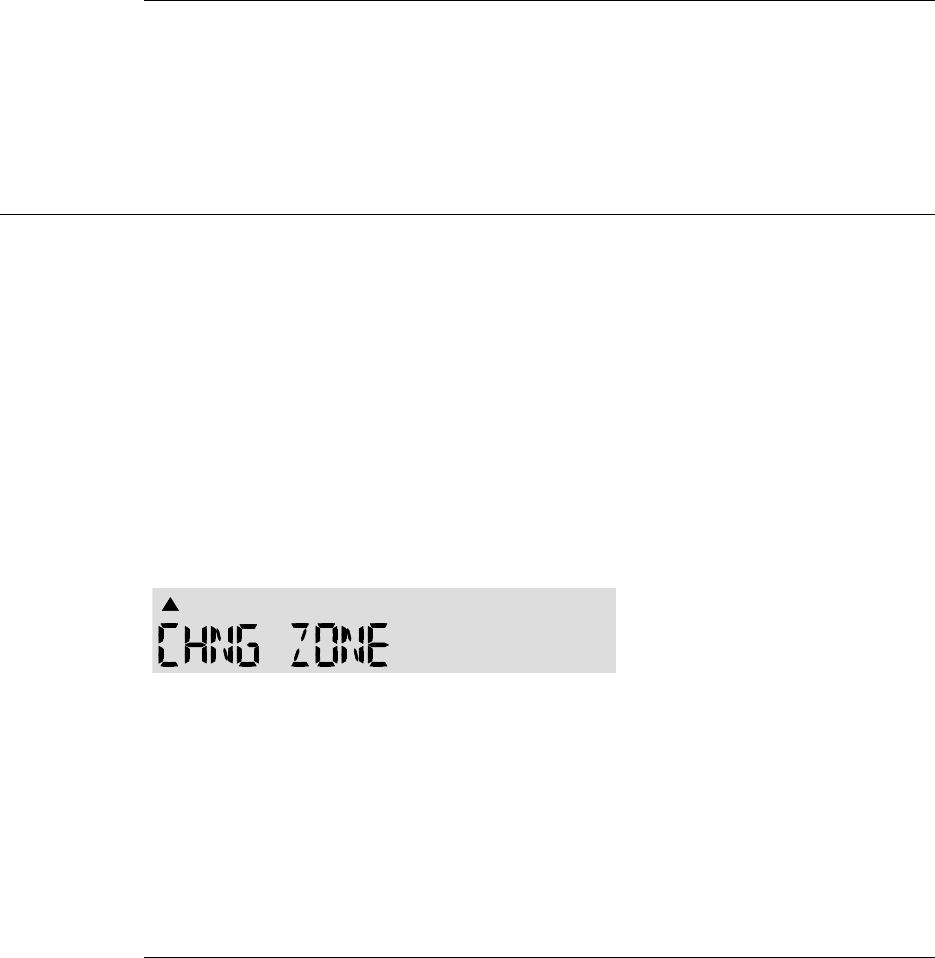
Viking VM600 Mobile Radio Operating Manual 6-23
Conventional Features
6.13.13 P25 Packet Data
See Section 9 for information on data functions and services.
6.14 Keypad Programming
Since keypad programming is permitted by Federal Government users only, only Federal
models of this radio can be programmed with this feature. It is then available only if it has
been enabled by factory programming and a conventional mode option switch is
programmed for the “Keypad Programming” function.
Note The Keypad programming feature is available to Federal Government users only. Users
regulated by the Federal Communications Commission (FCC) are not allowed to have
this feature. This feature must be factory enabled to be selected.
Keypad programming is selected by pressing the PROG option switch or by selecting the
option from the menu (password entry is not required). The keypad programming mode is
indicated by “CHNG ZONE” and a triangle in the display as follows:
Keypad programming allows conventional channel parameters such as the transmit and
receive frequency, Call Guard squelch code, and encryption key to be changed. In
addition, several conventional mode timers can be changed. It cannot be used to
reprogram disabled channels or any P25 Trunked, SMARTNET, or SmartZone
information.
6.14.1 Menu Structure
A menu system is used to select parameters in the keypad programming mode. To enter
the Menu Mode, press and hold the Select button until it beeps and enters the Menu Mode.
Rotate and press the Select switch to scroll through and select the available parameters.
The available parameters and the section in which each is described are as follows:
• CHNG ZONE (6.14.3)
• CHNG CHAN (6.14.4)
• SYS PARMS (6.14.5)
• CHAN PARMS (6.14.6)
Draft 4/29/2014
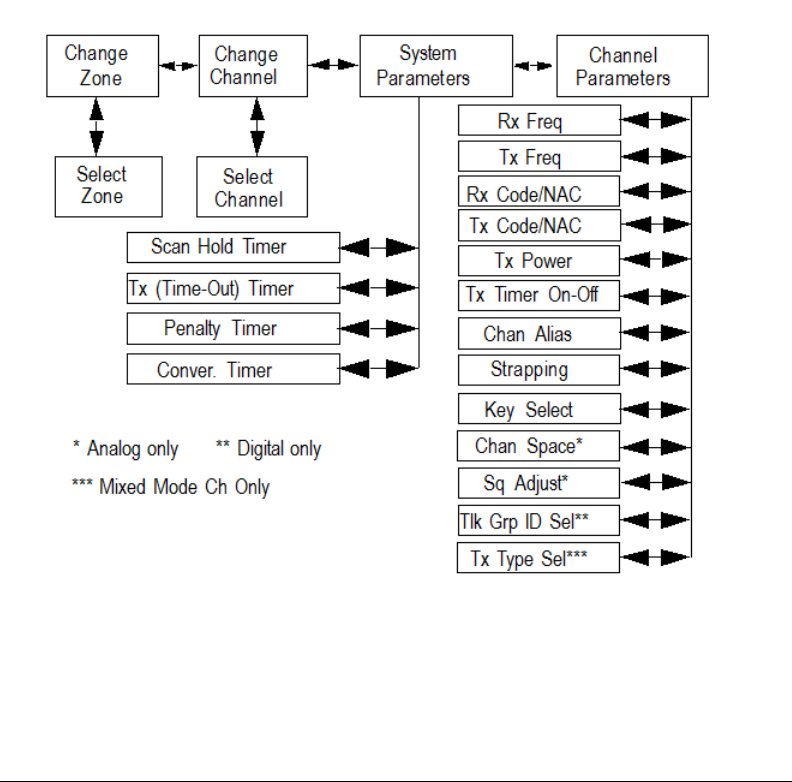
6-24 Viking VM600 Mobile Radio Operating Manual
Conventional Features
Press the Select switch to select the displayed parameter. A single beep sounds when the
switch is pressed (if that option is enabled). Press the PROG option switch from one of the
main menus to exit keypad programming or from other menus to exit back one level. A
flowchart showing the keypad programming mode menu structure is located Figure 6.1.
Refer to the descriptions which follow for more information.
Figure 6.1 Viking VM600 Keypad Programming Menu Flowchart
6.14.2 Zone Password
Each zone can be programmed with a password to prevent unauthorized reprogramming of
zone by keypad programming. When this password is programmed, it must be entered
before system or channel parameters in that zone can be changed by keypad programming.
A different password can be programmed for each zone.
Note Make sure that the zone passwords are not lost because they cannot be overridden in the
field. Armada must be used to add a new password.
Draft 4/29/2014

Viking VM600 Mobile Radio Operating Manual 6-25
Conventional Features
When an attempt is made to select a system or channel parameter in a password protected
zone, “PASSWORD” is flashed. The password is always eight digits long and is entered
using the same procedure as used for the power-up password described in Section 4.1.2.
After the password is entered, system and channel parameters for that zone can be
reprogrammed normally.
6.14.3 Zone Change Parameter
The “CHNG ZONE” menu parameter selects the zone containing the conventional
channel to be reprogrammed. It does not change the zone selected for normal operation.
Press the Select switch to select the “CHNG ZONE” parameter and then scroll through the
programmed zones by rotating that switch. When the desired zone is displayed, select it by
pressing the Select switch. A single beep sounds when the switch is pressed (if that option
is enabled).
6.14.4 Channel Change Parameter
The “CHNG CHAN” menu parameter selects the conventional channel to be
reprogrammed. Disabled or P25 Trunked/SMARTNET/SmartZone channels cannot be
selected. This does not change the channel selected for normal operation.
Press the Select switch to display “CHNG CHAN” and then scroll through the
programmed channels by rotating that switch. When the desired channel is displayed,
select it by pressing the Select switch. A single beep sounds when the switch is pressed (if
that option is enabled).
6.14.5 System Parameters
The “SYS PARMS” menu parameter selects the conventional mode timer to be
reprogrammed.
Press the Select switch to select “SYS PARMS” and then rotate that switch to display the
desired parameter. Then press the Select switch again to select it. A single beep sounds
when the switch is pressed (if that option is enabled). The following timers can be
programmed.
Note If “PASSWORD” is briefly displayed when attempting to select a parameter, see
Section 6.14.2.
SCAN TIMER - Selects the Scan Hold timer. Rotate the Select switch to decrement/
increment the timer in 0.5-second steps from 0-7.5 or set it to 0 seconds to disabled it.
Draft 4/29/2014

6-26 Viking VM600 Mobile Radio Operating Manual
Conventional Features
When the desired value is displayed, store it by pressing the Select switch. A single
beep sounds when the switch is pressed (if that option is enabled).
TX TIMER - Selects the transmit time-out timer. Rotate the Select switch to
decrement/increment the timer in 15-second steps from 0-225 or disable it by selecting
0 seconds. When the desired value is displayed, store it by pressing the Select switch. A
single beep sounds when the switch is pressed (if that option is enabled).
PEN TIMER - Selects the penalty timer. Rotate the Select switch to decrement/
increment the timer in 15-second steps from 0-225 or disable it by selecting 0 seconds.
When the desired value is displayed, store it by pressing the Select switch. A single
beep sounds when the switch is pressed (if that option is enabled).
CONV TIMER - Selects the conversation timer. Rotate the Select switch to decrement/
increment the timer in 30-second steps from 0-450 or disable it by selecting 0 seconds.
When the desired value is displayed, store it by pressing the Select switch.A single beep
sounds when the switch is pressed (if that option is enabled).
6.14.6 Channel Parameters
The “CHAN PARMS” menu parameter selects the following conventional channel
parameters that can be reprogrammed. Press Select switch to select the “CHAN PARMS”
parameter and then rotate that switch to display the desired parameter. Then press the
Select switch again to select it. A single beep sounds when the switch is pressed (if that
option is enabled). The squelch control parameters are unique to the type of conventional
channel selected (analog or Project 25).
Note If “PASSWORD” is briefly displayed when attempting to select a parameter, see
Section 6.14.2.
Note If a mixed mode channel is selected, both the Rx Code (analog) and Rx NAC (P25) which
follow can be programmed. In addition, if the Tx Type is Analog, a Tx Code is
programmed, and if it is Digital (P25), a Tx NAC is programmed.
RX FREQ - Programs the receive channel frequency. To select the digit to change or
move the cursor to the right, press the Select switch. Then to display the desired digit,
rotate the Select switch. The frequency is stored after programming the last digit. If an
invalid frequency is entered, a beep sounds, “INVALID” is briefly displayed, and the
frequency editing mode continues to be selected.
TX FREQ - Selects the transmit frequency the same the preceding RX FREQ.
CTCSS/DCS Squelch Control (Analog Channel) - Changes the preset squelch setting
on that channel. The default setting is “0” and values of –7 to +7 can be selected.
Increasing this setting toward +7 causes the squelch to open sooner so that weaker
signals can be received, and decreasing it toward –7 causes the opposite to occur.
RX CODE - Sets the receive Call Guard (CTCSS/DCS) code. The currently selected
code is initially displayed. If required, rotate and press the Select switch to select the
Draft 4/29/2014
Viking VM600 Mobile Radio Operating Manual 6-27
Conventional Features
desired code type (CTCSS analog or DCS digital). If an invalid code is entered, a beep
sounds, “INVALID” is briefly displayed, and the editing mode continues to be selected.
TX CODE - Selects the transmit codes the same as RX CODE above.
NAC Squelch Control (Project 25 Channel).
RX NAC - Selects the receive Network Access Code (NAC) which can be any number
from 1-4095. This number is displayed in hexadecimal from 000-FFF. Rotate and press
the Select switch to enter the desired code. A single beep sounds when the switch is
pressed (if that option is selected). The displayed code is stored after the last digit is
programmed. If an invalid code is entered, a beep sounds, “INVALID” is briefly
displayed, and the NAC editing mode continues to be selected.
TX NAC - Selects the transmit NAC the same as RX NAC above.
TX POWER - Selects the desired power output level. Rotate the Select switch to scroll
through the following choices. When the desired setting is displayed, store it by
pressing the Select switch. A single beep sounds when the switch is pressed (if that
option is selected).
- POWER High - Selects high transmit power.
- POWER Low - Selects low transmit power.
- POWER SW - Switchable power selectable by the High/Low power switch. This
choice is not available if that switch is not programmed.
TX TIMER - Enables or disables the time-out timer on the current channel. Rotate the
Select switch to toggle between the ON and OFF mode, and when the desired setting is
displayed, store it by pressing the Select switch. A single beep sounds when the switch
is pressed (if that option is selected).
Channel Alias - Programs the alias for the channel. Up to ten characters from A-Z and
0-9 and spaces can be entered. Press Select switch once to display the current alias and
then press it again or rotate it to program a new alias. Rotate the Select switch to display
the desired character and then press it to move to the next position. A single beep
sounds when the switch is pressed (if that option is selected). The number is stored after
the Select switch is pressed with the last position selected.
Note The next two parameters are programmed only if the radio is programmed for encryption.
Strapping - Selects the encryption strapping mode for the channel as Clear, Secure, or
Switched.
Key Select - Selects the encryption key for the channel if applicable. The key storage
location of 0-63 (PID) or 1-64 (SLN) is selected (see Section 8.2.2). If no keys are
programmed, “NO KEYS” is displayed.
CHAN SPACE (Analog Only) - Selects either wide or narrow band channel spacing on
analog channels only. Rotate the Select switch to toggle between “WIDE” and
“NARROW”, and when the desired setting is displayed, store it by pressing the Select
switch. A single beep sounds when the switch is pressed (if that option is selected).
Draft 4/29/2014

6-28 Viking VM600 Mobile Radio Operating Manual
Conventional Features
Note The channel spacing is not set with P25 channels because it is always narrow, and the
squelch cannot be changed because the setting is critical for proper receiver operation.
SQ ADJUST (Analog Only) - Changes the preset squelch setting on that channel. The
default setting is “0” and values of –7 to +7 can be selected. Increasing this setting
toward +7 causes the squelch to open sooner so that weaker signals can be received, and
decreasing it toward –7 causes the opposite to occur.
TG ID (P25 Only) - Selects the talkgroup for the selected channel. Rotate the Select
switch to display the alias of each preprogrammed talkgroup and then press it to store
the desired talkgroup. A single beep sounds when the switch is pressed (if that option is
selected).
Transmit Type (P25 Mixed Mode Only) - If the selected channel is a mixed mode,
analog and P25 channel, this selects the transmit type. Either Analog or Digital (P25)
can be selected. This then determines if a Tx Code or Tx NAC is programmed above.
6.15 Text Messaging
If enabled, mobile radios have text message receiving capability (digital conventional
mode only).
Note Mobile radios can receive text messages, but cannot transmit them. All received messages
are limited to 200 characters.
6.15.1 Data Setup for Text Messaging
A mobile subscriber can receive a text message from another subscriber on a digital
conventional channel regardless of whether the channel uses a repeater.
The radio’s text message menu contains the item “Set R to R”. The default for this setting
is enabled, in which the following capabilities are operable:
• A text message can be received from radios on a simplex digital channel
• A text message can be received from radios on a digital channel with a repeater (if
repeater talk-around is enabled)
• The repeater in use is programmed for Repeated Data mode (not supported by EFJ 2600
repeaters)
Draft 4/29/2014

Viking VM600 Mobile Radio Operating Manual 6-29
Conventional Features
If “Set R to R” is disabled:
• A text message can be received from radios on a digital channel with a repeater if
PCTextMessage is connected to that repeater (all radios must be dynamically registered
to the repeater)
• A text message can be received from a radio and PCTextMessage on a digital
conventional channel (if PCTextMesssage is connected to that repeater)
6.15.2 Receiving a Text Message
When a text message is received, a short alternating tone is sounded and the display
flashes “Text Msg”.
To view the message, press the assigned text message function button. The sender’s Unit
ID (or alias, if programmed) will be displayed for approximately one second. Following
this, the text of the message is shown.
Note Mobile radios display only capital letters, numbers, and the following symbols: period,
question mark, apostrophe, forward slash, and backslash. Incoming message text is
parsed to meet this requirement (i.e., lower case letters are capitalized, and any character
not meeting the requirement is replaced by space).
If the message is 10 characters or less in length, the text will remain stationary on the
display.
If the message is longer than 10 characters, the text will scroll across the display.
• To pause scrolling, press the Select knob.
• If desired, adjust the message position by turning the Select knob.
• To resume scrolling, press the Select knob again
Note The message displayed is the message most recently received. To view messages received
earlier, refer to paragraph 6.15.3.
6.15.3 Viewing Previously Received Messages
To view previously received messages:
1Press and hold the text message button, or select the text message menu item, and select
“View Msg”. The display will show “Message 1”, which is the most recent message
received.
2Use the Select knob to move through the list to the desired message.
Draft 4/29/2014

6-30 Viking VM600 Mobile Radio Operating Manual
Conventional Features
3To view the message text, press the Select knob.
Note Text messages are retained only while the radio is powered up. If power is removed, all
text message data is lost.
6.16 Sending Global Positioning System (GPS) Data
If the radio is setup for operation with a GPS receiver (see paragraph 5.14), GPS data can
be sent to a properly configured repeater (digital conventional only).
Examples of GPS data sent are:
- Latitude (e.g., 40.55 N)
- Longitude (e.g., 90.41 W)
- Time (e.g., 14:23)
- Altitude in meters (e.g., 390.2)
- Course Over Ground (e.g., 183.4 DEG)
- Speed (e.g., 55 MPH)
- Date (e.g., 26NOV2008)
- Number of GPS satellites currently received
GPS data can be sent manually, automatically, or on system request, depending upon the
options enabled.
6.16.1 Manually Sending GPS Data
If so configured, the radio will send GPS data (to a properly configured repeater) when the
assigned GPS button is pressed and held.
6.16.2 Automatically Sending GPS Data
If the radio’s GPS “Auto Transmit” option is enabled, the radio will automatically send
GPS data at predetermined intervals.
Draft 4/29/2014

Viking VM600 Mobile Radio Operating Manual 7-1
SECTION
Section7SMARTNET / SmartZone / P25
Trunked Features
The features described in this section are radio features unique to these modes of
operation.
7.1 Analog and Digital Operation
Either analog or digital operation can be selected for communication on SmartZone traffic
channels. Each talkgroup can be programmed for either type of operation. Digital
operation is an optional feature.
7.2 Viewing Unit ID
When power is turned on with a SMARTNET/SmartZone channel selected, the five-digit
Unit ID from 1-65,535 is briefly displayed as IDxxxxx. When a P25 channel selected, the
eight-digit unit ID from 1-16,777,215 is displayed (see Section 6.13.1).
Draft 4/29/2014

7-2 Viking VM600 Mobile Radio Operating Manual
SMARTNET / SmartZone / P25 Trunked Features
7.2.1 Radio Info Button
Pressing the Radio Info button (if programmed) or selection of the menu parameter allows
the user to display the ID programmed for the currently selected protocol. If the radio is on
a digital conventional channel, it shows the digital conventional ID. If the radio is
currently on a SmartNet/SmartZone or P25 Trunking channel location, it shows the ID
associated with that protocol. This feature also shows the following items:
•Band
• SEM
• File Format
• ESN
• Bootload Version
•DSP
•IP Address
• Encryption Key location programmed for the currently selected channel
• Unit ID for active protocol
• Radio Equipment Identification number
•Memory Used
• Current Software version in the radio
7.3 Standard Group Calls
Standard calls are between you and another mobile, group of mobiles, or a control station
(a radio in a fixed location). Most calls are probably this type. Proceed as follows to place
and receive group calls.
7.3.1 Placing a Standard Group Call
To place a Standard Group Call:
1Turn power ON and set the volume as described in Section 4. Select the channel
programmed for the talkgroup you want to call (see Section 4.1.6.3).
2If the talkgroup is programmed for encryption and is not strapped to Clear or Coded,
select the desired mode by pressing the C/S (Clear/Secure) option switch or selecting
the menu parameter. The status of that switch is ignored if the talkgroup is strapped to
Clear or Coded. Refer to Section 8.3 for more information.
3Press the PTT switch and begin talking. An optional talk permit tone may sound to
indicate when talking can begin. Other indications that may occur are as follows:
Draft 4/29/2014
Viking VM600 Mobile Radio Operating Manual 7-3
SMARTNET / SmartZone / P25 Trunked Features
- If in the secure mode and your radio is not programmed with the proper encryption
key, “KEYFAIL” is displayed and the call must be made in the clear mode or the
proper key must be programmed.
- If the busy tone sounds and “BUSY” is displayed, the system is busy. Release the
PTT switch and wait for the call back tone to sound. Then press the PTT switch
within three seconds.
- If a continuous tone sounds and “OUT OF RANGE” is displayed, you may be out of
range of the site or blocked from it by radio-shielding structures or objects. Drive
away from shielding structures or objects and try again. If this does not work, drive
closer to the site.
- If your unit ID is invalid, the call is being made to an invalid group ID, or group calls
are not enabled, “DISABLED ID” is displayed and an alert tone sounds.
- If an attempt is made to change an analog channel from the clear to the secure mode
and there is no available secure channel, “CLEAR ONLY” is flashed, an error tone
sounds, and the call is terminated.
- If an attempt is made to change an analog channel from the secure to clear mode,
“SECR ONLY” is displayed, an error tone sounds, and the call is terminated. (Calls
on digital channels can be changed if they are not strapped to clear or secure).
- If the Secure mode is selected by the C/S (Clear/Secure) option switch or menu
parameter and an attempt is made to transmit on a channel strapped as Clear,
“CLEAR ONLY” is displayed and the transmitter is disabled. Likewise, if the Clear
mode is selected and the channel is strapped as secure, “SECR ONLY” is displayed
and the transmitter is disabled.
Draft 4/29/2014

7-4 Viking VM600 Mobile Radio Operating Manual
SMARTNET / SmartZone / P25 Trunked Features
7.3.2 Receiving a Standard Group Call
Calls are received on only the talkgroup and/or announcement group programmed for the
selected channel (with scanning disabled). When the selected channel is programmed with
both Talk and Announcement groups, only the Talk and Announcement group IDs are
detected. Other IDs in the Announcement group are detected only if no talkgroup is
programmed.
When a group call is received, the alias of the selected channel is displayed. The radio can
be programmed so that the following are also displayed for 0.5-7.0 seconds or
continuously during the call.
PTT ID - The unit ID of the mobile placing the call is displayed.
TG on Rx - The alias of the talkgroup on which the call is being received is displayed
(typically for use by technicians).
User Group ID - If the group ID of the call being received is included in a
preprogrammed User Group ID list, the alias programmed in that list for that group is
displayed.
Received Key ID - The Key ID (or the alias, if programmed) of the key used to decode
the call is displayed.
7.4 Private (Unit-To-Unit) Calls
Private calls allow calls to be placed to a specific radio unit. Either the Enhanced Private
Conversation™ or standard Private Conversation modes may be programmed depending
on the capabilities of the radio system. One difference between these call types is that the
Enhanced type provides an indication that the called mobile is not on the air and the
standard version does not. Operation in each of these modes is described in the following
information.
Note With P25 Trunked operation, these calls are called Unit Calls, and they function the same
as the Enhanced Private Conversation mode described in the following information.
The Private Call option switch is required to place these calls, and either that switch or the
Call Response switch is required to receive them. The feature is also selectable via menu
parameter. Private calls are programmed to operate in one of the following modes:
• Disabled
• Answer-only capability
• List only - Unit IDs can be selected from a preprogrammed list only (direct entry as
follows is not allowed)
Draft 4/29/2014

Viking VM600 Mobile Radio Operating Manual 7-5
SMARTNET / SmartZone / P25 Trunked Features
• Unlimited - Unit IDs can be selected from a list and also dialed directly using the front
panel controls or the keypad on the HHC.
7.4.1 Placing an Enhanced Private Conversation Call
To recall from a list:
1Momentarily press the Private Call option switch or select the menu parameter. The
alias of the last called mobile is displayed.
2To select another mobile, rotate the Select switch until the alias for the desired mobile
is displayed.
3Press the PTT switch and one of the following events then occurs:
(Proceed to the bulleted list which follows Item 3 in the next section for events that may
occur next.)
To make direct entry using front controls or the keypad on the HHC:
1Press and hold the Private Call option key until a tone sounds (approximately one
second). The last ID called is displayed.
2If using the front panel controls, enter the ID of the radio you are calling (five digits for
Private Call or eight digits for Unit Call) by rotating and pressing the Select switch. A
single beep sounds when the switch is pressed (if that option is selected). With the
Hand-Held Control Unit (HHC), enter the number using the DTMF keypad. To cancel
the call, press the Private Call Option key again.
3Press the PTT switch to initiate the call. If the entered number is valid, the display
indicates the alias of the ID if it matches an ID in the call list. Otherwise, the ID you
entered continues to be displayed.
Events that may then occur are as follows:
- If the mobile being called is on the air, “WAIT” is displayed and ringing is heard
until the called party answers or for 20 seconds, whichever occurs first. Pressing the
PTT or an option switch stops the ringing but not the call. When the call is answered,
the voice of the called party is heard.
- If the called mobile does not answer within 20 seconds, a continuous tone sounds and
“NO ANS” is displayed.
- If the called mobile is not on the air, a continuous tone sounds instead of the ringing
tone and “NO ACK” is displayed.
- If the busy tone sounds and “BUSY” is displayed, the called mobile has answered the
call but the system is busy. When the system is no longer busy, the call back tone
sounds.
Draft 4/29/2014

7-6 Viking VM600 Mobile Radio Operating Manual
SMARTNET / SmartZone / P25 Trunked Features
- If your radio or the called radio is inhibited or not programmed to make this type of
call or for the requested secure mode, “RSPNS ONLY” is displayed and an alert tone
sounds.
- If your radio does not have the proper encryption key, “KEYFAIL” is displayed and
the call must be made in the clear mode by pressing the C/S (Clear/Secure) option
switch (if encryption is selectable on the channel). Otherwise, the correct key must be
loaded.
4When the call is finished or is not answered, end it by pressing the CALL option switch
and placing the microphone back on-hook.
7.4.2 Placing a Standard Private Conversation Call
To recall from a list:
1Momentarily press the Private Call option switch (or select the menu parameter). The
alias of the last called radio is displayed.
2To select another mobile, rotate the Select switch until the alias for the desired mobile
is displayed.
3Press the PTT switch to initiate the call.
(Proceed to the bulleted list which follows Item 3 in the next section for events that may
occur next.)
To make a direct entry using front controls or keypad on the HHC:
1Press and hold the Private Call option key until a tone sounds (approximately one
second). The last ID called is displayed.
2If using the front panel controls, enter the ID of the radio you are calling (five digits for
Private Call, eight digits for Unit Call) by rotating and pressing the Select switch. A
single beep sounds when the switch is pressed (if that option is selected). With the
HHC, enter the number using the DTMF keypad. To cancel the call, press the Private
Call Option key again.
3Press the PTT switch to initiate the call. If the entered number is valid, the display
indicates the alias of the ID if it matches an ID in the call list. Otherwise, the ID you
entered continues to be displayed.
Events that may then occur are as follows:
- The called party answers the call.
- The called party does not answer. Press the CALL option switch to end the call.
- If the selected mobile ID is not valid, “INVALID ID” is displayed and an alert tone
sounds.
Draft 4/29/2014

Viking VM600 Mobile Radio Operating Manual 7-7
SMARTNET / SmartZone / P25 Trunked Features
- If the radio system is busy, four low tones sound and “BUSY” is displayed. When the
system is no longer busy, the call back tone (four beeps) is heard and the channel is
automatically acquired. Press the PTT switch to continue the call.
- If the call is in the secure mode and your radio does not have the proper encryption
key, “KEYFAIL” is displayed and the call must be made in the clear mode by
pressing the C/S (Clear/Secure) option switch (if encryption is selectable on the
channel). Otherwise, the correct key must be loaded.
4When the call is finished or if it is not answered, end it by pressing the CALL option
switch and placing the microphone on-hook.
7.4.3 Receiving a Private Call (All Types)
To receive a Private Call:
1When a private call or unit call is received, “CALL RCVD” is displayed and the call
tone sounds once. The unit ID of the calling mobile is displayed. The display toggles
between “CALL RCVD” and the calling ID.
2To answer the call, select the menu parameter or press the Private Call option key and
then the PTT switch and begin speaking. More information follows:
- If the PTT switch is pressed before the Private Call key, the call is transmitted as a
group call.
- If private calls are not permitted (the Private Call option key is not programmed),
press the Call Response option switch to respond.
- The call must be answered within 20 seconds or it is automatically terminated.
- If the system is busy when a response is made, “BUSY” is displayed and the busy
tone sounds.
7.5 Telephone Calls
The telephone call feature allows telephone calls to be placed and received over the public
telephone system using your radio. The type of call (secure/clear) is determined by the
mode selected by the Clear/Secure option switch or the menu parameter selected.
Telephone calling is programmed to operate in one of the following modes:
• Disabled (telephone calls not available).
• Answer-only capability.
Draft 4/29/2014

7-8 Viking VM600 Mobile Radio Operating Manual
SMARTNET / SmartZone / P25 Trunked Features
• List only - Telephone numbers can be selected from a preprogrammed list only (direct
entry as follows is not allowed).
• Unlimited - Telephone numbers can be selected from a list and also dialed directly
entered using the front panel controls or the keypad on the HHC.
7.5.1 Placing a Telephone Call
To recall from a list:
1With a SMARTNET/SmartZone/P25 channel selected, momentarily press the Phone
option switch (or select the menu parameter). The alias of the last called telephone
number is displayed.
2If required, rotate the Select switch to display the desired number. The alias of each
number is displayed.
3Press and then release the PTT switch and “DIALING” is displayed. Refer to the
bulleted list following Step 3 in the next section for events that may then occur.
To make a direct entry using DTMF keypad:
1Select the menu parameter or press and hold the PHONE option switch until a tone
sounds (approximately one second). The alias of the last called telephone number is
displayed if it is in the phone number list. Otherwise, the last ten digits of the last called
telephone number are displayed. The phone call mode is indicated by in the
display.
2If using the front panel controls, enter the telephone number by rotating and pressing
the Select switch. A single beep sounds when the switch is pressed (if that option is
selected). The 0-9, the *, #, and P (pause) characters can be entered (# is displayed as a
“+”). Numbers up to sixteen digits (including pauses) can be entered, and the number
scrolls to the left in the display so that the ten right-most digits are always displayed.
With the HHC, enter the number using the DTMF keypad (a pause indicated by “P” is
entered by * #).
3Press and hold the PTT switch and dial the number using the keypad on the HHC.
“DIALING” is displayed. Events that may occur are as follows:
- If the access is successful, a dial tone sounds and the dialed number is displayed and
sent. Either ringing or a busy signal is then heard as with a standard telephone call.
When the called party answers, press the PTT switch to talk and release it to listen
(since the radio operates half-duplex, it is not possible to talk and listen at the same
time).
Draft 4/29/2014

Viking VM600 Mobile Radio Operating Manual 7-9
SMARTNET / SmartZone / P25 Trunked Features
Each time the PTT switch is released, a go-ahead tone is sent to the landside party to
indicate when they can respond. To dial a number after the connection is made, press
the PTT switch and dial the number using the keypad on the HHC.
ΟIf the selected telephone number is not valid, “INVALID” is displayed and an
alert tone sounds. Select a valid number.
ΟIf the system is busy, “BUSY” is displayed and the busy tone sounds. The call
automatically proceeds when the system becomes available.
ΟIf you are out-of-range or the radio cannot be accessed for some reason, “NO
PHONE” is displayed and an alert tone sounds.
ΟIf the interconnect call you are making or the selected secure mode is not
authorized, “REJECT” is displayed and an alert tone sounds.
ΟIf your radio does not have the proper encryption key, “KEYFAIL” is displayed
and the call must be made in the clear mode by pressing the Clear/Secure option
key (if strapped to switchable). Otherwise, load the correct key.
4When the telephone call is finished or it could not be completed for some reason, end it
by pressing the Phone option switch and placing the microphone back on-hook.
7.5.2 Receiving A Telephone Call
To receive a telephone call:
1When a telephone call is received, “ringing” similar to a standard telephone is heard
and “PHONE” is displayed.
2To answer the call, select the menu parameter or press the Phone option switch. Press
the PTT switch to talk and release it to listen (since the radio operates half duplex, it is
not possible to talk and listen at the same time).
3When the call is finished, end it by pressing the Phone option switch and placing the
microphone back on-hook.
7.6 Call Alert
The Call Alert™ feature allows pages to be sent and received. With SMARTNET/
SmartZone operation, either the Enhanced Private Conversation™ or Standard Private
Conversation mode may be programmed depending on the capabilities of the radio
system. With P25 Trunked operation, operation is similar to the enhanced mode.
Draft 4/29/2014

7-10 Viking VM600 Mobile Radio Operating Manual
SMARTNET / SmartZone / P25 Trunked Features
7.6.1 Answering a Page
To answer a Page:
1When a page is received, five beeps sound and “PAGE RCVD” is displayed. The ID of
the radio paging you is stored as the last ID received.
2To clear or ignore the page, press any option switch. If the PTT switch is pressed, a
group call is placed on the selected channel.
3To answer the page as a private or unit call (see Section 7.4), press the Private Call
option switch (or select the menu parameter). If the ID of the radio paging you is in the
Call list, the display will toggle between the Calling ID and the Alias. If not, only the
Calling ID is displayed. Press the PTT switch and respond. One of the conditions that
follow may also occur:
Enhanced Private Conversation™ Mode
- If the mobile being called is on the air, ringing is heard until the called party answers
or for 20 seconds, whichever occurs first. If no answer occurs within 20 seconds, a
continuous tone sounds and “NO ANS” is displayed.
- If the mobile being called is not on the air, a continuous tone is heard instead of
ringing and “NO ACK” is displayed.
Standard Private Conversation Mode
- If the mobile being called is not on the air or does not answer, you will not hear a
response.
- When the call is finished or it could not be completed for some reason, end it by
pressing the Call option switch and placing the microphone back on-hook.
7.6.2 Initiating a Page
To initiate a page by recall from a list:
1With a SMARTNET/SmartZone or P25 trunked channel selected, momentarily press
the ALERT option switch. The tag (alias) of the last ID called is displayed.
2If required, rotate the Select switch to display the desired mobile. The tag of each
number is displayed.
3Press the PTT switch and one of the following then occur:
- If five beeps sound, the system received the page and the paged mobile is on the air
and received it. The page mode is automatically exited.
Draft 4/29/2014

Viking VM600 Mobile Radio Operating Manual 7-11
SMARTNET / SmartZone / P25 Trunked Features
- If the system received the page but the called mobile is not on the air, a single beep
sounds and “NO ACK” is displayed six seconds after the PTT switch is pressed. Auto
exit then occurs.
7.7 Messaging
The messaging feature allows preprogrammed messages to be sent to your dispatcher. Up
to 16 messages can be preprogrammed, and they are identified by an alias. Messages are
sent as follows:
Note This feature is not available with P25 trunked operation.
1Momentarily press the Message option switch (or select the menu parameter). The alias
of the last message sent is displayed.
2If required, rotate the Select switch to display the desired message. Then send the
message by momentarily pressing the PTT or Select switch. A single beep sounds when
the Select switch is pressed (if that option is selected). One of the following then
occurs:
- If five beeps sound and “ACK RCVD” is displayed, the message was received and
automatically acknowledged by the system.
- If after five tries the message is not acknowledged, a tone sounds and “NO ACK” is
displayed.
Note Only the message number assigned to the alias is sent– not the actual text of the alias. For
example, If MSG 1 is assigned to alias “In Service”, “MSG 1” is sent– not “In Service”.
7.8 Sending Status Conditions
The status feature allows you to send your current status to your dispatcher. Up to eight
status conditions can be preprogrammed, and they are identified by an alias. If the Status
option switch is programmed, status conditions are sent as follows:
1Momentarily press the Status option switch. The alias of the current status condition is
displayed.
2To change the current status, rotate the Select switch until the desired status is
displayed. Then press the Select switch to accept that status. A single beep sounds
when the switch is pressed (if that option is selected). One of the following conditions
then occurs:
Draft 4/29/2014

7-12 Viking VM600 Mobile Radio Operating Manual
SMARTNET / SmartZone / P25 Trunked Features
- If five beeps sound and “ACK RCVD” is displayed, the status was received and
acknowledged by the system.
- If after five tries the message is not acknowledged, a tone sounds and “NO ACK” is
displayed.
Note Only the status number assigned to the alias is sent– not the actual text of the status
condition alias itself
7.9 Emergency Alarm and Call
Emergency Alarms and Calls are separate functions that can be individually enabled or
disabled on each SMARTNET/SmartZone and P25 Trunked system. The Emergency
option switch (or menu selection) is used for these functions. Other emergency features are
as follows:
• Emergency Alarms are transmitted on the selected talkgroup if emergency calls are
disabled, and on the emergency talkgroup if emergency calls are enabled.
• Emergency Call talkgroup selection priority is as follows. For example, if a global
emergency channel is not programmed, the emergency talkgroup of the selected channel
is used and so on.
- Global (radio wide) emergency channel
- Emergency group of the selected channel
- Talkgroup of the selected channel (tactical)
- Announcement group of the selected channel
• The emergency programming of the system to which that emergency talkgroup is linked
controls the emergency operation.
7.9.1 Emergency Alarms
An emergency alarm is a special transmission that alerts a dispatcher of an emergency
situation. It is sent automatically by pressing the Emergency option switch or by selecting
the menu parameter. The system to which the emergency channel is linked must have
Emergency Alarms enabled. If not, Emergency Alarms are disabled. The alarm is sent on
the control channel.
Proceed as follows to send an emergency alarm:
1Press the Emergency option switch. The radio automatically transmits the emergency
alarm if programmed.
Draft 4/29/2014

Viking VM600 Mobile Radio Operating Manual 7-13
SMARTNET / SmartZone / P25 Trunked Features
2When the emergency alarm is acknowledged, “ACK RCVD” is briefly displayed and
the emergency acknowledge tone (five beeps) sounds. Silent operation may also be
programmed in which case no tone sounds and there is no indication that an
acknowledgment occurred.
3The radio continues to transmit this message until an acknowledgment is received or
the programmed number of attempts have been made. The emergency alarm mode is
exited when radio power is cycled, or by pressing and holding the Emergency option
switch.
7.9.2 Emergency Call Alert
This feature notifies a user when an emergency call is being made on their selected P25
Conventional or P25 Trunking Talkgroup. The radio should also be programmed with an
“Emergency Clear” button.
If an emergency call is received by the radio on the selected channel, the emergency alarm
ACK tone will sound (five consecutive tones), and the Emergency Received message will
display, followed by the unit ID of the emergency radio. If any other emergency calls are
made after this initial one using a different radio, the tone will not sound, but the unit ID
will be updated to reflect the most recent emergency call. To exit out of this state, press
and hold the “Emergency Clear” button. The radio should return to its normal display, and
the Emergency Received message should no longer show.
7.9.3 Emergency Calls
An emergency call urgently requests access to a voice channel (an emergency tone usually
does not sound at the console unless the call is combined with an Emergency Alarm). An
emergency call is placed by pressing the Emergency option button. If the Emergency Hot
Mic feature is enabled, the emergency call is automatically transmitted without having to
press the PTT switch (see following description). The system to which the emergency
channel is linked must have Emergency Calls enabled.
Draft 4/29/2014

7-14 Viking VM600 Mobile Radio Operating Manual
SMARTNET / SmartZone / P25 Trunked Features
7.9.3.1 Emergency Hot Mic
If Emergency Hot Mic has been enabled for emergency calls, automatic transmitting
occurs with microphone audio unmuted without having to manually press the PTT switch.
The automatic transmit period is programmed for 10-120 seconds in ten-second intervals.
If the “Increment by 1” option (P25 Trunked only) is enabled, the automatic transmit
period is programmed for 1-12 seconds in one-second intervals. If the Emergency Hot Mic
feature or emergency calls are not enabled by programming, automatic transmitting does
not occur. This feature is initiated only on the first press of the Emergency switch.
Subsequent presses do not trigger automatic transmissions. To reset this function, hold the
emergency button or cycle power.
7.9.3.2 Placing an Emergency Call
To place an Emergency Call:
1If required, select a channel of a system on which Emergency Calls are enabled and
press the Emergency option switch (or select the menu option). The Emergency Call is
then sent as described in Section 6.9.1 if applicable.
2Emergency tones sound as follows: Emergency Call entry is played upon the pressing
of the Emergency button. Console Acknowledgement is played when an
acknowledgement is received back from the console for an emergency Call. Emergency
Exit is played when you press and hold the emergency button. Below are the tones for
Emergency.
3If the preceding Emergency Hot Mic feature is enabled, the call is automatically
transmitted without pressing the PTT switch. If it is disabled, press the PTT switch and
begin speaking as with a standard call.
4All group calls which follow are then emergency calls (private, telephone, and call alert
calls are not allowed). If the channel is changed, the call is made on the emergency
talkgroup programmed for the new channel. If the Surveillance Mode is enabled (see
Section 5.10), all indicators, lights, and tones are disabled. If “No Receive Activity
During Emergency” is programmed, receive audio, the front panel LED, and receive
icons are disabled in the receive mode.
Note Communications between the radio with the emergency and the dispatcher are closed.
That is, other stations in the talkgroup can see “Emergency” toggle on their displays, and
can listen to talk between the dispatcher and the radio with the emergency, but cannot talk
to that radio.
Console
Acknowledgement Emergency Alarm
Ack Emergency Alarm
Acknowledged
Successful
Two 1000 Hz 175 ms tones with
50 ms spacing followed by Three
1000 Hz 175 ms tones with 150
ms spacing
Emergency Call
Entry Emergency Button
Press Emergency button has
been Pressed 1000 Hz continuous tone for 175
ms.
Emergency Exit Emergency Canceled Emergency is
Canceled 1000 Hz continuous tone for 1
sec.
Draft 4/29/2014

Viking VM600 Mobile Radio Operating Manual 7-15
SMARTNET / SmartZone / P25 Trunked Features
5To exit this mode, cycle radio power or press and hold the Emergency switch.
7.10 Failsoft Operation
If a failure occurs in the SMARTNET/SmartZone or P25 Trunked system so that it cannot
be used, the system directs the radio to automatically enter the failsoft mode. When in this
mode, “FAILSOFT” is displayed. A failsoft tone may also be heard, depending on how
the repeater is programmed.
When in the failsoft mode, operation is in the conventional mode on the preprogrammed
failsoft channel (a different failsoft channel can be programmed on each talkgroup). If a
transmission is attempted before a failsoft channel is located, a continuous tones sounds
until the PTT switch is released. When the radio system returns to normal operation, this is
automatically detected and normal operation resumes.
7.10.1 Programmable Failsoft Connect Tone
On a SMARTNET or SmartZone trunking system(s), a different radio failsoft connect
tone can be programmed. This allows the radio to emit a distinct and different tone for
failsoft than tones used during other operating modes.
The failsoft connect tone setting will normally be selected to "Default." This means that
the connect tone used during failsoft will be the connect tone setting the system sends over
the air, or the programmed connect tone if no over the air value is received. If it is known
what the connect tone will be during failsoft operation, this can be programmed using the
PCConfigure application. If a value other than "Default" is programmed, the radio will
always use this connect tone setting during failsoft operation.
7.11 SMARTNET / SmartZone / P25 Trunked Scanning Features
Scanning on a SMARTNET/Smartzone or P25 Trunked system is called Priority Monitor
Scan. The following are unique features of this type of scanning. For general scanning
information applicable to all operating modes, refer to Sections 5.12 and 5.13.
• Scanning is turned ON and OFF by the Scan option switch (or selecting the menu
parameter). Talkgroups (channels) can be programmed so that scanning automatically
starts whenever the talkgroup is selected (Autoscan).
Draft 4/29/2014
7-16 Viking VM600 Mobile Radio Operating Manual
SMARTNET / SmartZone / P25 Trunked Features
• When responding to calls in the scan mode, the programming of the Talkback Scan
parameter determines if a response always occurs on the talkgroup of the call (Active
Group) or the Selected Group if they are different. Transmissions at other times always
occur on the selected talkgroup.
• Up to 255 scan lists or the number that fit in available memory can be programmed.
Each list can include the number channels/talkgroups (enabled for your radio) from the
same system, one of which can be a priority group as described in the next section.
• If the Scan List Edit option key is programmed (or if the menu parameter is selected),
scan lists are user programmable (see Section 7.11.2). In addition, nuisance channels
can be temporarily deleted as described in Section 5.12.5.
• Each talkgroup is programmed to select one of the programmed scan lists or “No List”
(scanning is disabled). If scanning is enabled and the selected channel does not permit
scanning, it is automatically enabled again when a channel is selected that permits
scanning.
• The selected scan list can be temporarily changed if the Scan (List) Select option switch
is programmed. The procedure is described in Section 7.11.2.
• In addition to calls on channels in the scan list, pages, private/unit calls, and telephone
calls are received while scanning. Private and telephone calls are not interrupted by
priority messages.
• P25 Trunking allows two Priority talkgroups per list.
Every radio on the system has to register with the Zone or Site Controller so that the
system knows where everyone is and if traffic from one site needs to be sent to another
site. This is determined by the list of Talkgroups registered with the radio.
When a call needs to be passed to a radio at another site, the traffic from one site to another
is then sent out over the control channel to the radios. When a radio is scanning, it is
monitoring the call information being sent out over control channel. The radio compares
the call information (Talkgroup and voice channel handling the Talkgroup) to the scan list
to see if any of the Talkgroups it is scanning are receiving a call. If it finds a match, the
radio moves to the voice channel for this call. If no one is registered on that Talkgroup on
the Site being scanned, the call information for the call is not sent out by the control
channel because the Zone or Site Controller did not see a requirement to pass this
information for this call and the call will not be received.
For example: Radio 1 is on in a call on talkgroup 1 on Site 1. Radio 2 is on talkgroup 2 on
Site 2 and scanning. The call on talkgroup 1 from radio 1 is not heard by radio 2. Then, if
radio 3 registers on talkgroup 1 on site 2, the call from radio 1 on Site 1 will go to Site 2.
Radio 2, radio 3, and any other radios on site 2 and scanning, will hear the call.
Draft 4/29/2014

Viking VM600 Mobile Radio Operating Manual 7-17
SMARTNET / SmartZone / P25 Trunked Features
7.11.1 Priority Talkgroup Sampling
One talkgroup in the scan list can be designated a priority talkgroup by programming or it
can be the selected talkgroup. When scanning, messages on a non-priority talkgroup are
interrupted by messages on the priority talkgroup. Priority scanning must also be
supported at the system level for it to occur as programmed in the radio. P25 Trunking
supports dual priority scan, therefore two priority talkgroups can be selected.
The Control Channel handles all traffic for the radios and communicates which talkgroups
are using which channels. If the radio “receives” the ID for one of its talkgroups, it can go
to that voice channel and hear the talkgroup. When the radio is ON the voice channel, it
cannot receive information about which talkgroups are on which channel. The radio will
not know about any new talkgroup activity till it finishes the voice channel and returns to
the Control Channel.
If a Talkgroup is set as a Priority Monitor talkgroup on the system, the system sends the
Talkgroup’s call information over the voice channel so it can be detected and move to this
priority call. So even if the radio cannot hear the Control Channel, it will receive the call
information and switch to the channel with the priority call.
Note The Priority Monitor must not be confused with Transmit Priority, which is used when a
call is placed in Queue when all the Voice Channels are busy.
7.11.2 Scan List Editing and Selection
SMARTNET/SmartZone and P25 Trunked scan lists are user programmable if the SCN
ED option switch is programmed (or if the menu parameter is selected). The procedure is
described in Section 5.13.1.
With SMARTNET/SmartZone and P25 trunked operation, each channel (talkgroup) can
be programmed to select one of the programmed scan lists or so scanning is disabled (No
List). In addition, each channel can be programmed so that scanning is automatically
enabled (Auto Scan) when it is selected. P25 Trunking supports dual priority scan,
therefore two priority talkgroups can be selected.
If the SN LIST option switch is programmed (or if the menu parameter is selected), the list
that is selected by all talkgroups in the current system can be temporarily changed by the
user as follows. Also selectable if desired is “Programmed” (default list). The temporary
programmed scan list is retained through radio power downs.
Proceed as follows to temporarily change the currently selected scan list:
1With scanning disabled (the rotating icon is not indicated in the right status display),
press the SN LIST option switch.
2The currently selected list is displayed as “LIST x”, with “x” the currently selected list.
To exit without changing the selected list, press the SN LIST option switch again.
Draft 4/29/2014

7-18 Viking VM600 Mobile Radio Operating Manual
SMARTNET / SmartZone / P25 Trunked Features
3To select another list, “PROGRAMMED”, or “NO LIST”, rotate the Select switch.
When the desired list is displayed, select it and exit this mode by pressing the Scan List
option switch again.
7.12 Dynamic Regrouping
The dynamic regrouping feature allows a dispatcher to change the current talkgroup or
switch radios to a predefined regrouping channel to receive a new talkgroup. When the
console issues a regroup order, the radio switches to the preprogrammed regroup
talkgroup.
Note For certain SMARTNET/ SmartZone dynamic regrouping operations (such as pre-
recorded messages) to function properly, the regroup talkgroup must be defined in the
system talkgroup table. Otherwise the radio cannot determine whether the regroup
talkgroup is analog or digital.
If the Cancel Dynamic Regrouping option switch is programmed, it can be pressed to exit
the dynamic regrouping mode. The mode can also be exited through the menu.
Otherwise, if the lock mode was not specified, the selected talkgroup can be manually
changed and the previous talkgroup is reselected if power is cycled. If a locked regroup
command is received, the displayed talkgroup cannot be changed manually or by cycling
power. It can be changed only after a clear order is received from the console.
Dynamic regrouping operates as follows:
1When this command is received, alternating tones sound and the radio automatically
changes to the regrouping channel. The display shows the alias entered for the dynamic
regroup enabled channel.
2If a pre-defined channel was changed above, go to Step 3. Manually select the channel
corresponding to that alias. If this is not done, transmission still occurs on the new
channel, but the alternating tones sound each time the PTT switch is pressed. If you did
not have a pre-defined channel, the talkgroup of the channel you are on is temporarily
changed. If this happens and you change channels, you lose the temporary talkgroup.
3Talk and listen as usual. When dynamic regrouping is canceled by the dispatcher, a
short tone sounds. If a standard channel is not selected after this occurs, transmission is
not allowed if the talkgroup is assigned as a dynamic regrouping talkgroup only. If it is
assigned as a normal talkgroup, normal transmissions are allowed. When a Cancel
order is received, the mobile moves back to your last channel unless the Lock order was
received.
Draft 4/29/2014

Viking VM600 Mobile Radio Operating Manual 7-19
SMARTNET / SmartZone / P25 Trunked Features
7.13 SmartZone and P25 Trunking Unique Features
SmartZone® and P25 Trunked modes can provide access to single or multi-site systems.
The P25 Trunked mode can provide access to a single trunked site or roaming between
several trunked sites.
7.13.1 Busy Override
The busy override feature is enabled at the system level by the system manager and is not
a programmable radio feature. It allows a call to be placed even if not all of the sites you
are calling have a free traffic channel. The only sites guaranteed to be included are the
Critical Sites and the sites where a Critical User is located. This feature operates as
follows:
1Assume that you have attempted to place a call and the system was busy (“BUSY”
displayed and busy tone sounded).
2Release the PTT switch and then press it for five seconds or more. If a chirp-like tone
sounds with the PTT switch pressed, busy override is occurring.
Note Remember that not all members of the talkgroup are receiving your message. Missing
members will start receiving your message as channels become available.
7.13.2 Site Trunking
Site trunking occurs when a site can no longer participate in wide area trunking. It is
disconnected from other sites and only supports calls with other radios on that site and
cannot route audio to other sites. When site trunking is occurring, the radio searches for
other sites that may provide wide area coverage.
Site trunking ends when a wide area coverage site is located, the current site is operating
again as a wide area coverage site, an out-of-range condition occurs, or the failsoft mode is
entered. The radio can be programmed so that “SITE TRUNKING” is displayed and/or an
alert tone sounds when site trunking occurs.
SmartZone and P25 trunked systems can be programmed for “Disable Site Trunking
Operation”. The radio is then not allowed to start or operate on a site trunking site. If a site
goes into site trunking, the radio leaves that site’s control channel and attempts to find
another valid wide area site. If no wide area site is available, the radio displays “OUT-OF-
RANGE”. If a site adjacent to the current Home Site was in site trunking but then enters
wide area trunking, it is evaluated to determine if it should move to that site as a better
site.
Draft 4/29/2014

7-20 Viking VM600 Mobile Radio Operating Manual
SMARTNET / SmartZone / P25 Trunked Features
7.13.3 Determining Current Site and Searching for a New Site
To display the RSSI level of the current site, press the SEARCH option switch. The
display then indicates the current site number as “SITE xx” and the RSSI (Receive Signal
Strength Indicator) signal level as “RSSI xx”. This mode is then automatically exited.
To scroll through the other programmed sites, press and hold the SEARCH option switch
while “SITE xx” or “RSSI xx” is displayed. If site lock is ON when site search is entered
(see following), the radio will be locked on the new site when this function is exited.
Note If a site failure occurs, the radio will automatically leave the failed site and register on
another site (after a predetermined delay). When the failed site recovers, the radio will
(after a predetermined delay) return to the site.
7.13.4 Locking / Unlocking a Site
It is sometimes desirable to stay connected to a specific site. To prevent the radio from
searching for a new site, lock it on the current site by pressing the LOCK option switch. To
unlock the site, press the LOCK option switch again and “UNLOCK” is momentarily
displayed.
When the user site locks the radio, the icon will begin to flash. The site lock indicator
will be hidden while the radio is in menu mode, unit call, or interconnect call. Site lock is
a global setting but the icon will only be displayed in P25 and SmartZone.
7.13.5 Auto Site Search
Auto site search automatically searches sites and ranks them in a “Best Sites” list. Press
the Auto Site Search option switch to display the current site number or alias and RSSI
level of the current site. A "Press and Hold" of the Auto Site Search option switch will
cause the radio to automatically move from the current site and select the first/next site
from the "Best Sites" list.
7.13.6 ZoneFail Site Lock
This is an optional feature that can be enabled only by factory programmed. It does not
require any special inputs from the infrastructure to operate. This feature is intended to
prevent some of the confusion resulting from a zone controller failure. When this occurs,
all sites go into the Site Trunking mode and radios will be unable to roam normally. The
result is that the various radios selected by a particular talkgroup may be operating on
different sites and are unable to talk to each other (see Section 7.13.2 for more Site
Trunking information).
Draft 4/29/2014

Viking VM600 Mobile Radio Operating Manual 7-21
SMARTNET / SmartZone / P25 Trunked Features
With the Zone Fail Site Lock feature enabled, the radio continues to roam normally when
the system zone controller is active. However, if the zone controller fails, this is detected
and the Zone Fail Site Lock mode is entered. The only site the radio is then allowed to
operate on is its home site. If its home site is not available, “OUT-OF-RANGE” is
displayed. A zone controller failure is detected by determining that every site in the
dynamic site list is in Site Trunking. Currently, this condition must be detected for at least
1 minute for the Zone Fail Site Lock mode to be selected.
The result of this operation is that all radios with the same programmed home site are
forced to the home site to communicate which ensures that they can continue to
communicate. If the home site is not available, the Out-of-Range condition tells the user to
attempt communication on another system or by some other means.
7.13.7 P25 Wide Area Scan
This feature is intended to enhance roaming performance, especially when system level
steering through radio or talkgroup permissions is used.
7.13.8 Normal P25 and SmartZone Control Channel Hunt
The following control channel search methods are normally used to find a control channel:
Short Hunt - The dynamic array of 7 adjacent sites (SmartZone) or 15 adjacent sites
(P25 Trunking) is searched. This list is saved on power down and loaded again at
power up. It is erased whenever parameters are downloaded to the radio.
Long Hunt - If no valid control channel is located by the preceding short hunt method,
the radio searches the list of control channels programmed into the radio.
Full Spectrum CC Scan - If the two preceding methods do not locate a control
channel, every channel available to the radio is searched.
7.13.9 Talkgroup Steering through System Access Permissions
To use system channel resources more efficiently, some system operators are using system
access permissions to steer certain talkgroups to particular sites. For example, a police
department may be allowed to use only Site 1, and a public works department may be
allowed to use only Site 2.
Draft 4/29/2014

7-22 Viking VM600 Mobile Radio Operating Manual
SMARTNET / SmartZone / P25 Trunked Features
The problem with this operation is that every time a different talkgroup is selected, the
access permission may be different and a different site may need to be accessed. This
could result, in a worst case, in a delay of up to 30 seconds in finding a new site. This
could occur if there are no valid sites for the new talkgroup in the dynamic site list.
7.13.10 P25 Wide Area Scan
This feature is intended to enhance roaming performance, especially when system level
steering through radio or talkgroup permissions is used.
To use system channel resources more efficiently, some system operators are using system
access permissions to steer certain talkgroups to particular sites. For example, a police
department may be allowed to use only Site 1, and a public works department may be
allowed to use only Site 2.
A Wide Area Scan can be programmed to minimize the problem just outlined. This feature
is programmed on the Talkgroup list screen selected on the P25 System screen. When
Wide Area Scan is selected, talkgroup site preferences are no longer available. However,
System Site Preference lists can still be used. The Wide Area Scan feature functions as
follows:
1Assume TG1 is selected. If it is the first time this talkgroup is selected, normal
searching for a control channel occurs according to the hunt methods previously
described.
2When another talkgroup is selected, the active valid site for TG1 is stored in EEPROM
memory.
3The next time TG1 is selected, the following procedure is performed before performing
the normal hunt methods previously described.
aThe last valid site ID and its receive and transmit channel numbers are loaded from
EEPROM memory.
bThe dynamic site list is checked to see if any newer receive/transmit channel
information is available for the last site ID.
cThe best receive/transmit information is used and the radio checks to see if this
control channel is available.
The result of the preceding operation is that the radio has a reasonable chance of finding a
valid site, usually on the first try. This greatly reduces access time, even on systems which
have highly restricted talkgroup based access.
With this option enabled on a talkgroup, as the talkgroup affiliates with a site that site is
saved if the mobile is changed to a new talkgroup. When the radio moves back to the Wide
Area Scan talkgroup, it will attempt to affiliate on the saved site before looking for a new
site.
Draft 4/29/2014

Viking VM600 Mobile Radio Operating Manual 7-23
SMARTNET / SmartZone / P25 Trunked Features
7.13.11 Radio Information
Various radio information can be viewed on the radio display. The "Radio Info" radio
button or menu item is selected to view this information. When selected, the information
will scroll across the radio display. You can pause, and move the text back and forth using
the same controls as you would for text messaging.
This information includes:
•Band - Current operating frequency band
•SEM version - will display the version of software running on the SEM module.
•File Format version - will display the file format of the currently loaded RCF.
•ESN - will display the electronic serial number of the radio.
•Bootloader version - will display the version of the radio bootloader.
•DSP version - will display the version of the DSP software.
•IP Address - will display the IP address provided by the system. If no IP address has
been provided, it will display "N/A". (This is a P25 feature only.)
•Key - Current assigned encryption key ID number
•Unit ID - Current assigned unit ID number
•Radio ID - Factory assigned radio ID number
•Memory Type - will display 1.0 if the radio has the standard memory capacity and 2.0
if it has expanded memory capacity.
Draft 4/29/2014

Viking VM600 Mobile Radio Operating Manual 8-1
SECTION
Section8Secure Communication (Encryption)
This radio may be equipped to provide secure communication on some or all channels.
This feature encrypts the voice so that it can be understood only by someone using a radio
equipped with a similar encryption device and encryption codes.
If equipped with the Clear/Secure option switch and the current channel is programmed to
allow switch selection, secure communication can be manually enabled and disabled by
that switch. Otherwise, channels are strapped to Clear or Secure operation (see Section
8.3). Secure communication can be programmed on a per channel or per talkgroup basis to
operate in various ways. When a secure call is received, the LED indicates Red and is
indicated in the display.
8.1 Encryption Algorithms
8.1.1 SecureNet™
SecureNet encryption digitizes the voice and then encrypts it using the DES algorithm. It
uses a 64-bit encryption key. The SecureNet protocols include the following algorithms:
• DES (Data Encryption Standard) provides a level of security, and also uses cipher
feedback. It was originally designed to be used only by the Federal government.
• DES-OFB - A form of DES encryption for digital channels that uses output feedback.
This protocol does not result in the degraded range that occurs with analog channels.
Note Using SecureNet may result in reduced range.
Draft 4/29/2014

8-2 Viking VM600 Mobile Radio Operating Manual
Secure Communication (Encryption)
8.1.2 AES (Advanced Encryption Standard)
An encryption standard called AES is replacing DES-OFB encryption on digital (P25)
channels. It uses a 128-, 192-, or 256-bit encryption key instead of the 64-bit key used with
DES. EFJohnson Technologies radios currently support only 256-bit AES keys. The type
of encryption (DES or AES) is determined by the type of encryption key that is loaded (see
Section 8.2), and not by the Armada programming software. AES encryption, like DES
encryption, is an optional radio feature that must be purchased and then enabled at the
factory (or by a factory-created option file).
8.1.3 Encryption Available With Various Channel Types
Analog Channels - On analog conventional and SMARTNET/SmartZone channels, DES
encryption provides secure communication.
Digital Channels - On digital Project 25 and SMARTNET/Smart Zone channels, the
DES-OFB or AES-OFB protocol is used.
8.1.4 FIPS and Non-FIPS Modes
FIPS 140-2 is a Federal Information Processing Standard for encrypted radios used by the
Federal Government. This standard specifies Federal security requirements for
cryptographic modules for a wide range of applications and environments. All Viking
VM600 models are FIPS certified.
8.2 Encryption Keys
An encryption key is a cryptographic variable that is required by the encryption algorithm
to encrypt and decrypt voice or data. To maintain system security, these keys must be
protected from disclosure and also periodically replaced or updated.
With the AES and DES encryption used by EFJohnson Technologies radios (see Section
8.1), the same encryption key is used by both the encrypting (sending) and decrypting
(receiving) radio. AES encryption keys are generated from a string of 64 hexadecimal
characters, and DES keys are generated from a string of 16 hexadecimal characters.
Another four hexadecimal characters are used to specify the key ID. Multiple keys can be
loaded into a radio using OTAR or manual loading.
Draft 4/29/2014
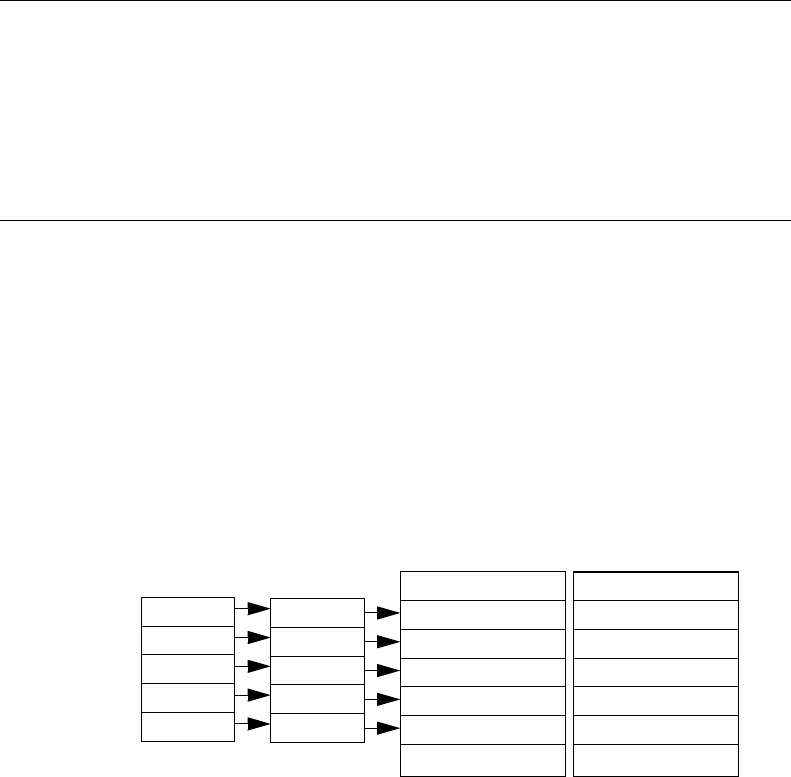
Viking VM600 Mobile Radio Operating Manual 8-3
Secure Communication (Encryption)
If an attempt is made to transmit a secure message without loading the corresponding key,
“KEY FAIL” is displayed. The message must then be transmitted in the clear mode (this is
possible only if the channel is strapped to “switchable”) or the key must be loaded.
8.2.1 Key and Algorithm IDs
Each encryption key is programmed with a Key ID (also called Logical ID). This ID plus
the algorithm ID (ALGID) is transmitted in the message on digital channels. The radio
receiving the message must have a key with the same IDs in order to decrypt it.
8.2.2 PID / SLN Key Management Modes
The channels, talkgroups, and other calls that use encryption are linked to a specific
Physical ID (PID) when the radio is programmed. For example, Zone 1, channel 1 could
be programmed to select the key in PID 1 and Zone 1, channel 2 could select the key in
PID 3. The PID ranges are 0-63 when the PID mode is selected, and 1-64 when the SLN
mode is selected (see Figure 8.1).
Note The term “SLN” from the Project 25 specification is equivalent to “CKR” (Common Key
Reference) also used to define this parameter.
Figure 8.1 Key Selection Example
More information on these modes follows.
PID Mode - PID mode is analog encryption only. Since the EFJohnson Technologies
System Management Assistant (SMA) does not work with analog keys, PID mode can
be used only when keys are loaded using the Motorola KVL-3000 or KVL-3000 Plus
keyloader. When this mode is selected, keys are loaded directly into a PID of 0-63 that
corresponds to the PID programmed for each channel (if applicable). The Keys Table in
Armada is not programmed with this mode.
SLN Mode - The SLN mode must be selected if either OTAR (Over-The-Air-
Rekeying) or the EFJohnson Technologies System Management Assistant (PDA
keyloader) is used. It can also be used if OTAR is not used. SLN mode is either analog
Algorithm ID
Keyset Name (Opt)
SLN 23
SLN 25
Algorithm ID
Keyset Name (Opt)
Key #21: Key ID 54
SLN 24
SLN 22
SLN 21
Keys Table
3
5
4
2
1
PID
Key #22: Key ID 65
Key #23: Key ID 67
Key #24: Key ID 69
Key #25: Key ID 73 Key #25: Key ID 90
Key #24: Key ID 91
Key #23: Key ID 99
Key #22: Key ID 98
Key #21: Key ID 94
Keyset 1
Keyset 2
Zone 1, Chan 2
Zone 2, Chan 4
Zone 2, Chan 5
Zone 3, Chan 1
Zone 3, Chan 2
Draft 4/29/2014

8-4 Viking VM600 Mobile Radio Operating Manual
Secure Communication (Encryption)
or digital encryption, and can also be used with the with the Motorola KVL-3000 Plus.
With this mode, keys are loaded into a SLN (Storage Location Number), typically from
0-4095. The Keys Table must then be programmed to link channel PIDs to a specific
SLN.
The use of this type of indirect linking allows keysets and key IDs to be changed
through OTAR while keeping the mapping from the channel or talkgroup the same. For
example, as shown in Figure 8.1, PID 4 selects SLN 24 which selects key slot 24 in both
keysets. This slot contains Key ID 69 in Keyset 1 and Key ID 91 in Keyset 2. Only one
keyset is active at a time. The actual key chosen between these two to transmit with will
depend on which keyset is active, Keyset 1 or Keyset2.
8.2.3 Maintaining Keys in Memory
The radio may need to be connected to a constant power source to preserve the encryption
keys in memory. The programming of the Infinite Key Retention parameter determines if
keys are permanently stored in memory or erased soon after power is removed.
When Infinite Key Retention is enabled, keys are stored in memory and are not lost when
power is removed. If it is disabled, they are removed almost immediately after power is
turned off.
With Viking VM600 mobile models, the keys are maintained for approximately eight
hours with this feature disabled. However, a tamper switch causes immediate key erasure
when the radio cover over the logic board is removed.
8.2.4 Encryption Key Select
When multiple encryption keys are programmed (see preceding information), the KY SEL
option switch can be programmed to allow selection of another key for the current
channel. This feature changes the PID (hardware location) of the key of the channel for
analog or Talkgroup for Conventional Digital and P25 Trunking, and the change is
permanent (cycling power or selecting a different channel does not reselect the original
key). Therefore, to switch back to the original key, it must be manually reselected. Proceed
as follows to select a key:
Note This feature is available on conventional channels only.
1Press the KY SEL option switch and HWKEY x is displayed. The “x” indicates the
current key PID selection.
2Rotate the Select switch to display the desired key and then press the Select switch to
select it. Press the KY SEL option switch again to return the display to normal
operation.
Draft 4/29/2014

Viking VM600 Mobile Radio Operating Manual 8-5
Secure Communication (Encryption)
8.2.5 Encryption Key Erase
A KY CLR option switch can be programmed that allows the user to permanently erase all
stored keys. If OTAR TEK and KEK keys are stored, all keys of both types are erased.
This function can be used to ensure that unauthorized encrypted calls can no longer be
placed or received by a radio.
On a mobile radio, you must press the erase keys button twice within a small period of
time for the keys to be erased.
8.2.6 Encryption Icon Operation
The encryption icon is displayed whenever a secure call is received or transmitted.
Other operation is as follows:
• The icon is always displayed when the radio is in secure mode and receives a clear call
on a digital and P25 trunking channel.
• It is not displayed when receiving a clear call in the secure mode on an analog channel.
• An option can be programmed to sound a beep whenever a secure call is received on a
clear channel.
8.3 Clear / Secure Strapping
8.3.1 Transmit Mode Options
The following transmit options are available when encryption is selected:
“Clear” - All calls are in the clear mode.
“Secure” - All calls are made in the selected secure mode.
“Switched” - The mode is selected by the Clear/Secure switch. When the clear mode is
selected by this switch and a secure call is received, or vice versa, you will hear a beep.
Press the programmed option button to change to the appropriate mode. When the clear
mode is selected by this switch, “CLEAR” is flashed, and when the secure mode is
selected, “SECURE” is flashed.
Draft 4/29/2014

8-6 Viking VM600 Mobile Radio Operating Manual
Secure Communication (Encryption)
If the channel has been strapped “Clear” and the option switch selects the “Secure” mode
on power up and a transmission is attempted, “CLEAR ONLY” is displayed and
transmitting is disabled. Likewise, if the channel is strapped “Secure” and the option
switch selects the “Clear” mode on power up and a transmission is attempted, “SECURE
ONLY” is displayed and the transmitter is disabled.
The radio can be programmed to ignore the “Clear” or “Secure” switch setting. These
preceding indications then do not occur and transmissions always occur in the strapped
mode.
Note If all channels/talkgroups are strapped clear or secure and no C/S (Clear/Secure) option
switch is programmed, this parameter must always be selected (see following).
If the C/S (Clear/Secure) switch is not programmed, the radio is always in the last known
state (usually Clear) and there is no way to change it. For example, if the last known state
is Clear and this parameter is not selected, it is never possible to transmit a Secure message
on a channel strapped Secure because all that happens is transmitting is disabled, an error
tone sounds, and “SEC ONLY” is displayed.
8.3.2 Analog Receive Mode Options
The following receive options can be programmed with conventional operation. With
SMARTNET/SmartZone and P25 Trunked operation, encrypted calls are received if the
proper key is programmed.
Note The assignment of an encryption key assigns that key to the transmit side of a call only.
No Autodetect - Only signals coded like the transmit signals are received.
Secure Autodetect - Both clear and secure signals are automatically detected. This
mode is automatically selected if the transmit mode is switch selectable.
Proper Key Autodetect - (Analog Channels) When this feature is disabled and a
message is received with the wrong key, the audio unmutes and garbled (encrypted)
audio is heard. However, if this occurs with this feature enabled, the audio remains
muted.
Draft 4/29/2014

Viking VM600 Mobile Radio Operating Manual 8-7
Secure Communication (Encryption)
8.4 Security Settings Override
The default security settings that determine how encryption keys are used for talkgroups
and channels can be changed for different operating modes.
8.4.1 Conventional (P25) Talkgroup Security Override
On conventional digital (P25) channels, the encryption strapping mode and PID are
programmed on a per talkgroup basis similar to the trunked modes (SMARTNET/
SmartZone/P25 Trunked). It can be programmed to override the talkgroup encryption
programming and program it on a per-channel basis. Therefore, if desired on conventional
digital channels, encryption can be programmed differently for each channel.
Conventional analog channel encryption is always programmed on a per-channel basis.
8.4.2 Secure Call Behavior
8.4.2.1 Failsoft, Group Regroup or Dynamic Regroup Call
If the radio is in failsoft or is dynamically regrouped, the radio will use any key to decrypt
a received call and will transmit using switched strapping and the key PID specified as
originally programmed.
If the radio is group regrouped, most functionality is retained. The radio will continue to
use the key PID specified (as programmed) will use any key to decrypt a received call.
However, the strapping of the current channel will be used. This means that if the channel
has the override feature enabled, the strapping specified in this section will be used for the
channel. If the override feature is not enabled, then the strapping of the currently selected
talkgroup will be used.
8.4.2.2 Channel with only a Talkgroup Specified
If the override security settings feature is enabled, then the override parameters will be
used. If the override feature is not enabled, then the talkgroup parameters will be used. If
the Any Key option is disabled and a secure talkgroup call is received that uses a different
key than the one specified, the radio will not unmute but will display the received call
information.
Draft 4/29/2014

8-8 Viking VM600 Mobile Radio Operating Manual
Secure Communication (Encryption)
8.4.2.3 Channel with both a Talkgroup and Announcement Group Specified
For a Talkgroup Call if the override security settings feature is enabled, then the override
parameters will be used. If the override feature is not enabled, then the talkgroup
parameters will be used. If the any key option is disabled and a secure talkgroup call is
received that uses a different key than the one specified, the radio will not unmute but will
display the received call information.
Announcement group calls ignore the talkgroup override settings. Therefore, the settings
specified on the announcement group list will be used. If the any key option is disabled
and a secure announcement group call is received that uses a different key than the one
specified, the radio will not unmute but will display the received call information.
8.4.2.4 Channel with only an Announcement Group Specified
If a secure component talkgroup call is received, the first check will be for the any key
option as specified on the announcement group list. If the any key option is enabled, all
secure traffic (both component talkgroups and the announcement group) will unmute
provided the proper key is stored in the radio. If the any key option is disabled, then the
radio will determine the key that the talkgroup is supposed to use by reading the
programmed key PID from the talkgroup list. If the received key matches the expected
key, then the component talkgroup call will unmute. If the keys do not match, then the
radio will not unmute but will display the component talkgroup call information.
8.4.2.5 Announcement Group Call
The settings specified on the announcement group list will be used. If the any key option is
disabled and a secure announcement group call is received that uses a different key than
the one specified, the radio will not unmute but will display the received call information.
8.4.2.6 Emergency Calls on Emergency Groups
Emergency talkgroup calls will not utilize the override settings, but will be subject to the
any key rules specified above.
8.4.3 Scan Mode Behavior
The settings used while the radio is scanning are consistent with the modes described in
the preceding sections. Scanning mute versus unmute behavior is best illustrated with an
example.
Assume that a simple scan list is comprised of three channels:
Draft 4/29/2014

Viking VM600 Mobile Radio Operating Manual 8-9
Secure Communication (Encryption)
1. The talkgroup is 1, the any key option is disabled, and the channel is secure and uses
key 1.
2. The talkgroup is 2, the any key option is disabled, and the channel is secure and uses
key 2.
3. The talkgroup is 1, the any key option is disabled, and the channel is secure and uses
key 3.
Figure 8.2 shows which calls will unmute versus which ones will remain muted while
scanning on a certain channel.
Figure 8.2 Scan Mode
If there are multiple channels in the scan list that utilize the same talkgroup, the security
parameters used will be first determined from the selected channel parameters (if
applicable) or from the first channel in the scan list that utilizes the talkgroup.
Draft 4/29/2014

8-10 Viking VM600 Mobile Radio Operating Manual
Secure Communication (Encryption)
8.5 Over-The-Air Rekeying (OTAR)
OTAR stands for “Over-The Air-Rekeying”. This is the process of sending encryption
keys and related key management messages over-the-air to specific radios. The advantage
of OTAR is that it allows these keys to be quickly and conveniently updated when
necessary. It is no longer necessary to periodically travel to the radio location or bring the
radio into a maintenance facility to load new keys.
The actual OTAR rekeying functions are performed by a Key Management Facility
(KMF) that sends Key Management Messages (KMM) to the RSI (Radio Set Identifier)
assigned to a specific radio or radios. These messages are themselves encrypted using a
unique key called the UKUK (Unique Key Encryption Key). Radios must be OTAR-
compatible, programmed for OTAR, and the UKEK loaded for OTAR for this type of
rekeying to occur.
Note The RSI is enabled in the KMF and must be assigned to the radio under OTAR in Armada.
OTAR is available only on P25 conventional and trunked channels, and only to program
DES-OFB and AES keys. It is not used on SMARTNET/SmartZone channels or to load
DES keys.
8.5.1 Encryption Key Types
There are two types of keys used with OTAR:
Traffic Encryption Key (TEK) - The key used to encrypt voice and data traffic. All
radios using encryption must have at least one of these keys.
Key Encryption Key (KEK) - The key used to encrypt keys contained in OTAR Key
Management Messages (KMMs). All radios which use OTAR must contain at least one
of these keys. The KEK used to decrypt/encrypt keys in an OTAR message is defined
by the algorithm and key IDs transmitted in the decryption instructions field. A KEK
may be unique to a particular radio (UKEK) or common to a group of radios (CKEK).
The SMA or KVL-3000 create only UKEKs, therefore you create and load UKEKs
before using OTAR.
8.5.2 Keysets
To simplify key management, OTAR divides the TEK keyspace into multiple sets. Exactly
one of these sets is said to be active at any given time, and only keys in the currently active
set will be selected for use when encrypting voice traffic. The Viking VM600 radio
supports two such keysets, Keyset 1 and Keyset 2. The valid SLN range for Keyset 1 and
Keyset 2 is 1 through 4095. Viking VM600 radios can be assigned up to 64 SLNs in this
range. See Figure 8.1.
Draft 4/29/2014

Viking VM600 Mobile Radio Operating Manual 8-11
Secure Communication (Encryption)
Notice that if all radios in a cryptonet are using traffic keys from the same active keyset,
the keys contained in the inactive keyset of each radio can be replaced without disrupting
encrypted communications. Once the keys in the inactive keyset are replaced for every
radio in a given cryptonet, the radios can switch active keysets and start using the new
keys. After all radios are using the new keys, the keys in the previously used keyset can
then be replaced, and so on. It is the task of the Key Management Facility to coordinate
this key cycling activity.
While the active keyset is usually selected by the Key Management Facility, it can also be
selected by the radio user if the KY CHG option switch is programmed. In this fashion,
two keysets can be used even if OTAR is not being used. Note that the radio must be in
SLN mode (see Section 8.2.2) to make use of keysets.
KEKs are always placed in Keyset 255, and are always considered to be active. The valid
SLN range for Keyset 255 is 61440 through 65535. While KEKs can reside in any SLN
within this range, traditionally UKEKs will reside in SLN 61440 and/or 61442, and
CKEKs, if present, will reside in 61441 and/or 61443. The EFJohnson Technologies KMF
uses SLN 61440 for DES UKEKs and 61442 for AES UKEKs.”
If Erase Previous Keyset on OTAR Changeover is selected in Armada, the keys in the
original keyset are erased when the OTAR Changeover command or the Keyset option
switch are used to select the other keyset. If this not selected, the keys in the original
keyset are not erased when this occurs. Please note that this only erases keys on an OTAR
changeover: It does not erase keys on a manual keyset changeover from either the menu or
function button.
8.5.3 Key Management Facility
The Key Management Facility (KMF) provides key management and OTAR functions to
applicable radios within the radio system. One of the main tasks of the KMF is to maintain
a data base of encryption information contained in each radio. This information may
include the following:
• TEKs (main Traffic Encryption Keys)
• KEKs (Key Encryption Keys) used to encrypt keys within OTAR messages
• Keysets (groups of TEKs or KEKs)
• Individual and group Radio Set Identifiers (RSIs)
The KMF performs OTAR functions by exchanging Key Management Messages (KMMs)
with the radios. Both the KMF and radio can originate messages. Some functions
performed by the KMF are as follows:
• Loading new keys
• Modifying keys
• Initiating active keyset switch overs
Draft 4/29/2014

8-12 Viking VM600 Mobile Radio Operating Manual
Secure Communication (Encryption)
• Modifying keyset names
• Deleting keys
• Deleting all keys (zeroize) when a radio may be lost or compromised
• Determining if a radio is on the air and reading key information
• Changing individual and group RSIs
• Manage Subscriber Groups (groups of radios using the same keys).
8.5.4 Message Number Period (MNP)
One of the parameters that is programmed in a radio using OTAR is Message Number
Period (MNP). This parameter is used to minimize the possibility of someone sending
messages to “spoof” the system or radio. The MNP is used as follows.
Every message sent out has a message number. The message number increments by one
with each message sent. The MNP is the maximum difference allowed between messages.
For example, if the MNP is set to 1000 and the last message number received by the radio
is older by more than 1000 from the current message number, the current message is
ignored, and a message number resynchronization process will be automatically
attempted. If the MNP is set to 65535, message numbers are ignored.
When determining this number, consider the likelihood of someone trying to spoof the
system by retransmitting recorded messages and then adjust the MNP accordingly. The
higher the risk, the smaller the MNP should be. A disadvantage of setting a low MNP is
that the chance of rejecting valid messages becomes higher. In addition, traffic level and
terrain contribute to lost messages and should also be considered when selecting this
number. If the message numbers become out-of-sync between the radio and the KMF, an
automatic resynchronization process will take place, which requires additional bandwidth.
Note that this process is not possible if the radio does not share a TEK with the KMF.
A setting of 1000 will block out very old messages but is unlikely to affect anything
intentionally sent out by the system (1000 messages sent to a single radio is not likely to
occur in a system in less than a year with normal usage).
8.5.5 Definitions
Algorithm - Refers to the specific encryption standard (DES or AES) that is used to
encrypt a message. Each standard uses different calculations to perform the encryption
(see Section 8.1).
Algorithm ID (ALGID) - Identifies the algorithm (DES or AES) used to encrypt a
message. This ID and the Key ID are transmitted with each non-analog message to
uniquely identify the key being used.
Draft 4/29/2014
Viking VM600 Mobile Radio Operating Manual 8-13
Secure Communication (Encryption)
Black - Refers to information that is encrypted. The opposite is “Red” which refers to
unencrypted information.
Common Key Encryption Key (CKEK) - This is a KEK common to a group of
subscriber units which share the same encryption. These keys can be the DES or AES
type. The use of a common key allows the subscriber units to be rekeyed by the KMF
using one Key Management Message in some circumstances by addressing the KMM to a
group RSI. Refer to “KEK” for more information.
Common Key Reference (CKR) Group - Same as Storage Location Number (SLN).
Crypto Group - A group of up to 16 keysets containing the same type of keys (either
TEK or KEK). Although a crypto group can contain up to 16 keysets, only two are
normally used. Only one keyset in a crypto group is active at a time. EFJohnson
Technologies radios currently support only one crypto group: for TEKs, crypto group 0.
Cryptographic Variable - The variable used by a cryptographic algorithm to encrypt a
message. Also called a “key”.
Key - A variable used by a cryptographic algorithm to encrypt voice or data. Also called
“Cryptographic Variable”. Keys are identified by their Algorithm ID and Key ID values.
Key Encryption Key (KEK) - A key used to encrypt keys contained in Key Management
Messages (KMMs) during OTAR. These messages may themselves be encrypted by a
TEK. These keys can be the AES or DES type. There are KEKs unique to a subscriber unit
(UKEK) and common to a group (CKEK). The other type of key is the Traffic Encryption
Key (TEK) used to encrypt voice and data messages.
Key ID - This is a 16-bit (four hex digit) number identifier from 1-65535 for an encryption
key which allows the key to be identified without revealing the actual key variable. This
ID and the Algorithm ID uniquely identify a key within the KMF or subscriber unit.
Therefore, two keys can have the same ID if they have different algorithm IDs and vice
versa. The Key ID and Algorithm ID are usually transmitted with a message to identify the
key that must be used to decrypt it. Key ID 0 is not used with OTAR.
Key Management Facility (KMF) - The equipment and software which provide OTAR
and related key management services to the subscriber units.
Key Management Message (KMM) - These are the messages composed by the KMF to
send encryption information to subscriber units through the keyloader or OTAR. KMMs
are themselves encrypted using two layers of encryption: inner and outer. The inner layer
of encryption uses a KEK and the outer layer uses a TEK. Additional security measures
contained within KMMs include a Message Number (MN) and a Message Authentication
Code (MAC).
Keyset - A structure containing keys of the same type (TEK or KEK). There are two TEK
keysets, Keyset 1 and Keyset 2, and one KEK keyset, Keyset 255. Only one of the two
TEK keysets is active at a given time. This provides a way to divide the two keys
contained within each SLN into two groups, active keys and inactive keys, based on the
currently active keyset setting.
Draft 4/29/2014
8-14 Viking VM600 Mobile Radio Operating Manual
Secure Communication (Encryption)
Keyset Changeover - The process used to switch the active keyset setting on a subscriber
unit to the currently inactive keyset so that the keys in the newly inactive keyset can be
replaced without interrupting encrypted communication.
Key Loader - Any type of device used to load encryption keys into a radio. With OTAR,
this device must be used to provide the initial key loading of a subscriber unit so that it
contains the basic keys needed for OTAR by the KMF. If OTAR is not used, it is always
used to load encryption keys. All keys stored in the key loader are themselves encrypted.
EFJohnson Technologies offers a PDA-based keyloader.
Logical Link ID (LLID) - An ID transmitted with a CAI data message to identify the
destination of the message.
Message Number Period (MNP) - The maximum difference between message numbers
that can occur before a message is declared invalid (see Section 8.5.4).
Over-The-Air-Rekeying (OTAR) - The process of sending new encryption keys over the
air using an RF interface.
Red - Refers to information that is not encrypted. The opposite is “Black”.
Rekey - The process of preparing, sending, and loading encryption keys into a subscriber
unit for current or future use. This may be done over-the-air (OTAR) or by directly
connecting a keyloader to the subscriber unit.
Radio Set Identifier (RSI) - Subscriber units are programmed with one or two Radio Set
Identifier (RSI) numbers that identify the unit for OTAR purposes. The RSI can be unique
to an individual subscriber unit or unique to a group of subscriber units. An individual
(unit) RSI is always assigned and a RSI may be assigned. The individual RSI is typically
programmed when the subscriber unit is initially brought into service. The KMF is also
identified by an RSI (KMFRSI) to use as the destination of any KMMs a subscriber unit
originates. The KMMs (Key Management Messages) generated by the KMF (Key
Management Facility) are addressed to a specific RSI.
Storage Location Number (SLN) - A link to a TEK in a given keyset. A given SLN can
contain two keys, one for the active keyset and one for the inactive keyset. SLNs and
CKRs are equivalent terms (see Section 8.2).
Traffic Encryption Key (TEK) - A key used to encrypt voice or data. The other type of
key is the Key Encryption Key (KEK) which is used to encrypt keys contained in Key
Management Messages. TEKs can be either the AES or DES type.
Unique Key Encryption Key (UKEK) - A KEK unique to a particular subscriber unit.
Refer to “KEK” for more information. These keys can be either the AES or DES type.
Zeroize - The process of deleting all keys from a compromised subscriber unit to disable
it. To make the unit encryptionally functional again, the keys must be reloaded by a
keyloader.
Draft 4/29/2014

Viking VM600 Mobile Radio Operating Manual 8-15
Secure Communication (Encryption)
8.6 Radio Setup For Encryption
The following radio setup is required for encryption regardless of whether OTAR is used:
Options Enabled - The desired encryption type must have been enabled at the factory
(DES, DES-OFB, AES). To determine what options are enabled, use Armada.
The following are set through Armada. Please refer to the Armada Programming Manual
or Help for more information.
PID/SLN Mode - If the SLN mode is used, the Keys Table must be programmed also.
Infinite Key Retention - This parameter enables the option to store keys permanently
in memory (see Section 8.2.3).
Erase Keys On Keyset Change - This parameter to erase keys when changing keysets
if the SLN mode is selected and more than one keyset is used (see Section 8.2.5).
Program Channel/Group PIDs and Encryption Type - With conventional analog
calls, this information is programmed on the channel screen. With other types, it is
programmed in the talkgroup list selected on the system screen. In addition, with
conventional digital calls, the group programming can be overridden on the channel
screen (see Section 8.4.1). Additional PIDs for special calls can also be specified on the
system screen for digital and trunked calls.
Note The encryption type is not selectable on digital channels because the AES/DES mode is
determined by the key type loaded, not by Armada.
Note Key Loss Key (KLK), offered by Motorola, does not erase the UKEK which allows the
radio to be rekeyed by the KMF remotely. By not erasing the UKEK, the KLK does not
meet TIA standards and is no longer FIPS 140-2 certified.
The current EFJohnson Technologies Viking VM600 mobile radios support OTAR.
However, an RSI, UKEK and other information must be programmed as described in the
next section.
8.6.0.1 Motorola Third Party RNC Registration
The Viking VM600 supports dynamic data registration. However, if desired, the radio can
be programmed to perform Third Party data registration instead of dynamic registration on
the OTAR and Data parameters page. If Third Party registration is selected, the radio may
must be manually registered on the Motorola RNC Console by entering the following
command:
LCRD 03 06 00 1234 7F xx xx xx 0A 0A 00 07 00 yy
Where, “xx xx xx” is the hex value of the Digital Unit ID entered by Armada. Refer to the
console documentation for the value of “yy” or use “00”. This registration needs to be
done only once.
Draft 4/29/2014

8-16 Viking VM600 Mobile Radio Operating Manual
Secure Communication (Encryption)
8.6.0.2 Programming By Keyloader
The following are the minimum parameters that need to be programmed in the radio to
perform OTAR. It is not necessary to program a TEK but it is necessary that a UKEK be
manually programmed to perform OTAR. If the radio does not contain a TEK, the KMF
initiates a warm start-up sequence in which a temporary TEK is transferred to the radio to
perform the key transfer.
UKEK - This key normally has SLN (CKR) 61440 and Key ID 62880 (F5A0 hex).
Unit RSI - This is normally initially the same as the P25 Unit ID and is programmed by
Armada as described in Section 8.6. Therefore, the RSI should not need to be loaded if
it is the first time the radio is being set up for OTAR or if the radio dumps keys due to
long-term battery disconnect. However, it may need to be loaded if the radio is
manually deleted from the KMF and then recreated since the message number must be
reset to 0 (the Load Target RSI command resets the message number to 0).
KMF RSI - This RSI is normally 9,999,999 and should not need to be loaded since it
defaults to this number.
Verify that the above information was properly stored in the radio by viewing it using the
keyloader.
8.7 Radio OTAR Capabilities
The OTAR capabilities of the SEM-equipped Viking VM600 mobile radio are as follows.
Keysets
• Up to three keysets are used and it is assumed all three are always present. Keyset IDs 1
and 2 are for TEKs and only one is active at a time. Keyset ID 255 is for KEKs and is
considered active all the time
• Each keyset can have up to 128 keys. However, 16 or less are normally used.
Radio Set Identifier (RSI)
• One individual RSI and it is usually initially the same as the P25 Unit ID.
• One group RSI (usually initially “0”).
• One KMF RSI (usually always 9,999,999).
Draft 4/29/2014

Viking VM600 Mobile Radio Operating Manual 8-17
Secure Communication (Encryption)
OTAR Messages That Are Supported
The following KMM Message IDs are recognized by or sent:
CHANGE RSI 0x03
CHANGE RSI RESPONSE 0x04
KEYSET CHANGEOVER 0x05
KEYSET CHANGEOVER RESPONSE 0x06
DELAYED ACK 0x07
HELLO 0x0C
INVENTORY 0x0D
INVENTORY RESPONSE 0x0E
MODIFY KEY 0x13
MODIFY KEYSET ATTRIBUTES 0x14
MODIFY KEYSET ATTRIBUTES RESPONSE 0x15
NEGATIVE ACK 0x16
NO SERVICE 0x17
REKEY ACK 0x1D
REKEY 0x1E
WARM START 0x20
ZEROIZE 0x21
ZEROIZE RESPONSE 0x22
OTAR REGISTRATION 0x25
OTAR REGISTARTION RESPONSE 0x26
UNABLE TO DECRYPT 0x27
8.7.1 OTAR Option Switches
The following additional option switches can be programmed with the Viking VM600
mobile radio to control OTAR functions.
Change Keyset - Toggles the active keyset between Keyset 1 and Keyset 2. The new
active keyset is briefly displayed and then normal operation resumes. To change to the
other keyset, highlight it and press the <F2> key.
Draft 4/29/2014

8-18 Viking VM600 Mobile Radio Operating Manual
Secure Communication (Encryption)
Clear/Secure Select - This enables and disables encryption regardless of whether
OTAR is used. Refer to Section 8.3 for more information.
Erase Keys - Erases all TEK and KEK keys contained in the radio.
Key Select - This allows a different key to be selected for the current channel or group
(conventional channels only). Refer to Section 8.2.4 for more information.
OTAR Rekey Request - Sends a message which tells the KMF that the radio is on the
air and requests rekeying. The following status messages are displayed which indicate
the progress of this function.
Rekeying - A radio-initiated rekeying session is in process.
No Ack - No response was received from the KMF in response to an Identify request
before time out occurred (approximately 30 seconds).
Ack Rcvd - An acknowledgement was received in response to an Identify request.
No Service - A “No Service” reply was received from the KMF. No rekeying will take
place.
Rekey Fail - Either the rekey command failed or timed out (after approximately 30
seconds). This message could indicate that the rekey request message was not received
by the KMF. However, depending on the KMF configuration and channel traffic, it is
possible that the message was received and a response is still pending.
Rekeyed! - The rekey session initiated by the radio was successful.
8.7.2 P25 Trunking Icons
There are two different P25-data related icons which indicate if the radio is on a trunking
system. One indicates whether or not you are on a data channel, and one indicates whether
or not you have successfully data registered (i.e., whether or not you were granted an
SNDCP data context by the system). The icons appear to identical, except for their
position on the display.
Over Button 2, this icon indicates P25 Data Context Activated – Radio is ready
for data operations.
Over Button 3, this icon indicates Radio is operating on a data channel
Every time the radio goes to a data channel, the data channel icon will come on, and stay
on, until the radio leaves the data channel. The radio goes to the data channel to do P25-
data related tasks, such as data register, OTAR register, and send and receive OTAR data.
You must have successfully data registered before you can successfully initiate an OTAR
session. The usual sequence when the radio is attempting to data register will be:
- The data channel icon comes on.
- The data context icon comes ON (once we successfully data register).
Draft 4/29/2014
Viking VM600 Mobile Radio Operating Manual 8-19
Secure Communication (Encryption)
- The data channel icon goes out (once the radio returns to a control channel), but the
data context icon stays on.
If the data context icon is not on, you do not have an SNDCP context (i.e., you are not data
registered).
Once the radio has a data context, if it is configured for OTAR and has a UKEK, it will
attempt to OTAR register. Depending on timing, the radio may stay on the data channel
for a longer period of time (the second step above) while it OTAR registers, an action
which can kick off an OTAR update procedure. Eventually the radio will leave the data
channel. The radio will be told by the system when it should the data channel.
A sign that has not successfully OTAR registered is that the radio’s data context icon will
be on, but the radio will periodically keep going back to the data channel (the data channel
icon will periodically come ON and then OFF). The number of times the radio will
attempt to OTAR register and the amount of time it will wait between events is configured
in Armada.
Draft 4/29/2014

Viking VM600 Mobile Radio Operating Manual 9-1
SECTION
Section9Data Features
Advances in digital communications allows for new data features and services using the
radio link. This section describes the data features and services available for the Viking
VM600 radio.
9.1 P25 Packet Data
P25 packet data transmission capability is available with Viking VM600 mobile radios. A
Data option switch can be programmed to toggle the data mode ON and OFF (or the menu
option can be used).
The P25 Packet Data mode allows a subscriber unit to act as a packet data modem for a
remote application connected to the subscriber unit through an RS-232 or Serial Line
Internet Protocol (SLIP) connection. The SLIP connection requires an Ethernet port.
Three P25-compliant conventional data operating modes are supported:
•Direct Radio to Radio mode - In this mode the radio will transmit data directly to
another subscriber without any involvement of fixed network equipment.
•Repeater mode - In this mode, the radio will transmit data on the inbound channel of a
repeater. The repeater will retransmit the data on the outbound to another subscriber
radio listening on the outbound channel.
•FNE data mode – In this mode, the mobile subscriber transmits data to a fixed network
computer connected to the FNE.
Draft 4/29/2014

9-2 Viking VM600 Mobile Radio Operating Manual
Data Features
9.2 P25 Trunking Data Services
P25 Trunking supports data service on a P25 Trunking system using an EF Johnson
Technologies radio and a portable computer. The radio communicates with the computer
over the P25 Mobile Data Peripheral (MDP) Interface, which uses an RS232 hardware
interface at 9600 bits/s. The following protocols are supported across the interface:
• Point To Point Protocol (PPP)
• Internet Protocol (IP)
• Universal Datagram Protocol (UDP)
• Transmission Control Protocol (TCP)
9.2.1 Radio Configuration
The radio must be programmed for data operations on the Trunked IV & D system. The
following parameters apply:
Data Registration On/Off - Enables/disables data registration.
ICMP Echo - Enables the radio to send back an ICMP response once an ICMP request
has been received.
CAI Data Max Tx Attempts - Selects the maximum number of times the radio
attempts to send a CAI data packet. Attempts to send the data packet continue until the
radio receives an acknowledgment confirming the successful receipt of the packet, or
until the radio exceeds the selected amount of transmit attempts.
Response Timer - Selects the period of time the radio waits for an acknowledgment
that a CAI transmission is successful before it tries the transmission again.
SNDCP Activation Wait Timer - Controls the time that a radio waits for the KMF to
respond to a SNDCP context activation request.
Rx Voice Interrupts Data - Enables/disables whether a voice call can interrupt data.
Subscriber IP Address - The IP Address assigned to the subscriber for a PPP
connection.
Mobile Computer IP Address - IP address assigned to the mobile computer for a PPP
connection.
Tx Limited Patience - Selects the amount of time radio attempts to transmit a common
air interface packet. Once time expires, radio ceases transmission. Times are 1 to 255
seconds, infinite in increments of 1. The default is infinite.
Min Response Timer - Selects the minimum amount of time that the radio waits for an
acknowledgement of a successful CAI to be sent across the channel. Times are 50 to
2000 msec., in increments of 50 msec. The default is 700 msec.
Draft 4/29/2014

Viking VM600 Mobile Radio Operating Manual 9-3
Data Features
Frame Sync Seek Period - Selects the amount of time the radio listens for a frame sync
sequence before a packet is transmitted. Times are 0 to 5000 msec., in increments of 50
msec. The default is 750 msec.
Tx Short Random Range - Selects the maximum amount of time the radio waits to
transmit once the first qualified FS is received indicating the channel is clear. Times are
50 to 500 msec., in increments of 50 The default is 50 msec.
Tx Long Random Range - Selects the upper range of the random range. When the
radio detects a busy, the radio uses a random time within this range (Back off delay) to
determine when to retransmit the packet. Times are 50 to 5000 msec., in increments of
50 msec. The default is 2000 msec.
Tx Response Random Range - Selects amount of time radio waits before rechecking a
channel's status once a busy channel status symbol has been received. Only applies to
ACKs. Times are 50 to 1000 msec., in increments of 50. The default is 1000 msec.
9.2.2 Interface Connection
The radio connects from its MDP Interface to the RS232 COM port of the computer using
the P25 Mobile Data Peripheral (MDP) Interface cable.
9.2.3 Context Activation
In order for the radio to access data service on a trunking system, it must be a valid user on
the system and it must be affiliated to an RF site. Once this is accomplished, the radio
must request data services from the trunked system through the process of context
activation; a data registration of the radio with the system. Context activation is initiated
from the radio.
In an EFJohnson Technologies mobile radio, context activation is automatically initiated
when the user selects a P25 trunking system with either data registration enabled or OTAR
enabled. During a context activation, the mobile radio attempts to access a packet data
channel (PDCH) at the site and send it its request for data services. If the context
activation is successful, the mobile subscriber will receive a response containing a IP
address. This IP address will be used by the mobile radio as a source IP address for all
inbound data messages sent, and is used by the host application as the destination IP
address for all outbound data messages.
If for some reason the context activation fails, the mobile radio will not be allowed to use
data services on the trunked system. If a PPP link is established between the portable
computer and mobile radio without the radio context activated, any data transmitted by the
computer to the radio is ignored.
Draft 4/29/2014
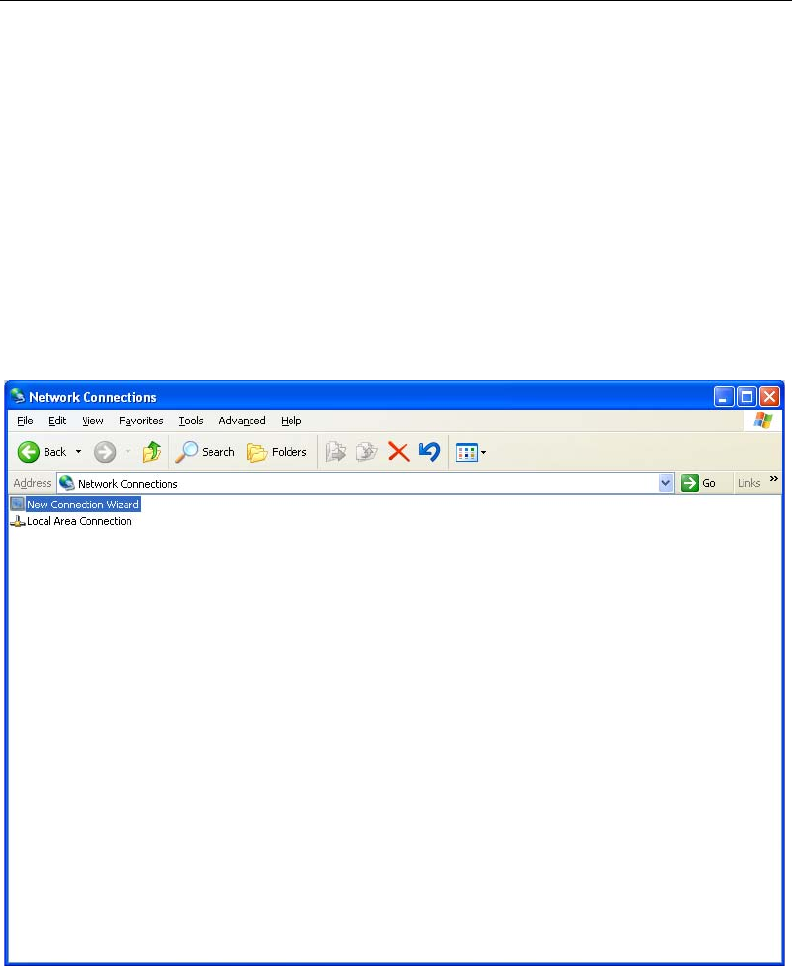
9-4 Viking VM600 Mobile Radio Operating Manual
Data Features
9.2.4 PPP Link Establishment
To begin data transmissions from an application running on a portable computer, a data
connection must first be established between the mobile computer and the radio (with data
capability enabled). This is accomplished by creating a new connection using the
Microsoft Windows Operating System.
Note The following screen shots are derived from Windows XP.
The network connection screen can be accessed through the control panel. Click the create
a new connection link.
1Using the Control Panel, access the Network Connection screen (Figure 9.1).
Figure 9.1 Network Connection Screen
Draft 4/29/2014
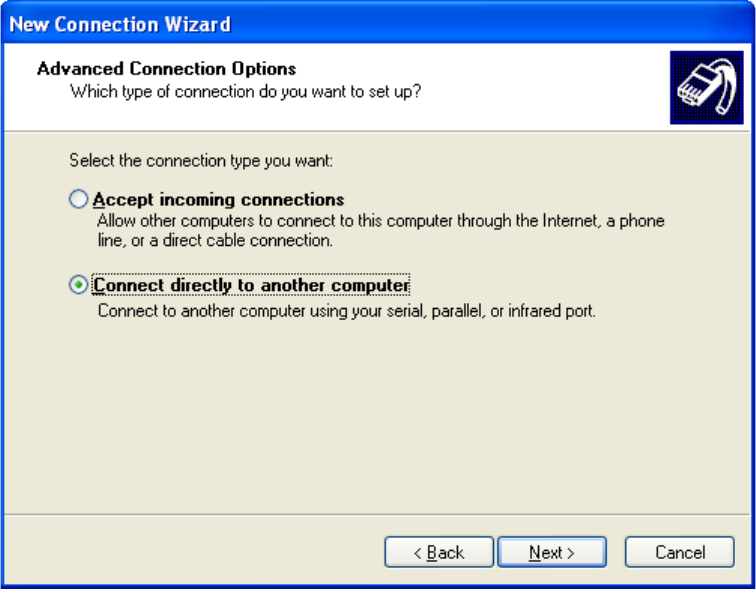
Viking VM600 Mobile Radio Operating Manual 9-7
Data Features
4Select Set up an advanced connection, then click Next. The Advanced Connection
Options screen appears (Figure 9.4)
Figure 9.4 Advanced Connection Options Screen
5Select Connect directly to another computer, then click Next. The Host or Guest screen
appears (Figure 9.5).
6Select Guest, then click Next. The Connection Name screen appears (Figure 9.6).
Draft 4/29/2014
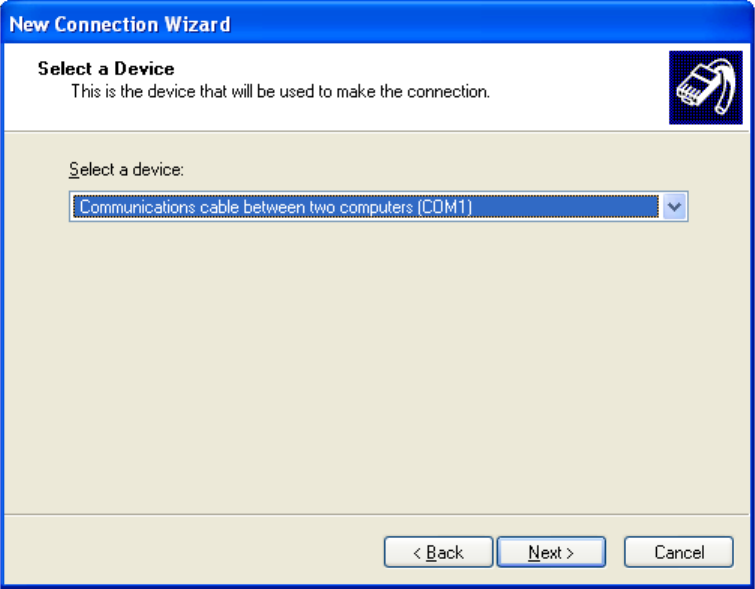
9-10 Viking VM600 Mobile Radio Operating Manual
Data Features
7In the Computer Name frame, type the name for the connection. Then click Next. The
Select a Device screen appears (Figure 9.7).
Figure 9.7 Select a Device Screen
8From the Select a device pull-down list, select the communications port to use to
connect the cable from the radio to the computer. Then click Next. The Connection
Availability screen appears (Figure 9.8).
9Under the Create this connection for options, select Anyone’s use.Then click Next. The
Completing New Connection Wizard screen appears (Figure 9.9).
Draft 4/29/2014
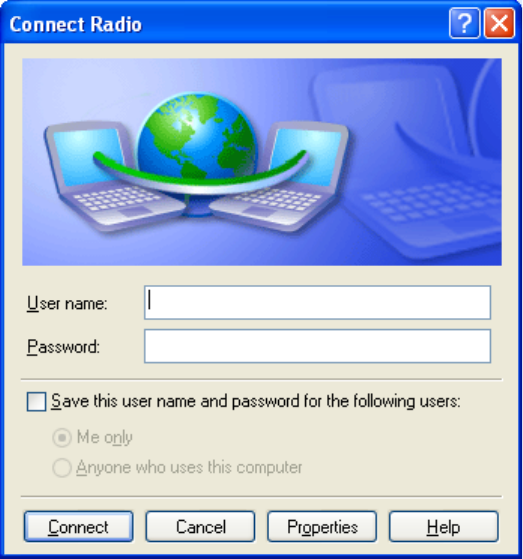
9-12 Viking VM600 Mobile Radio Operating Manual
Data Features
10 Click Finish. The new connection is established (and should be in the network
connection folder). The Connect Radio screen appears (Figure 9.10).
Figure 9.10 Connect Radio Screen
11 Click Properties. The Radio Properties screen appears (Figure 9.11).
12 Under the General tab, click Configure. Verify that the communications port selected
in Step 8 is selected in the Select a device pull-down list.
Draft 4/29/2014
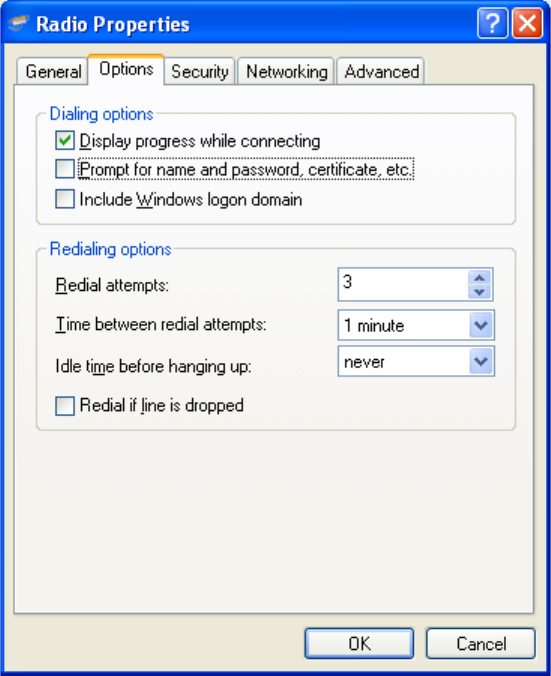
Viking VM600 Mobile Radio Operating Manual 9-15
Data Features
Figure 9.13 Radio Properties Screen: Options Tab
15 Under the Options tab, ensure that the box for Prompt for name and password
certificate, etc. is unchecked. Then select the Networking tab (Figure 9.14).
16 Under the Networking tab, ensure that the following boxes are unchecked:
- File and printer sharing for Microsoft Networks
- Intel Wireless Connection Agent
- Deterministic Network Enhancer
- Client for Microsoft Networks
Draft 4/29/2014
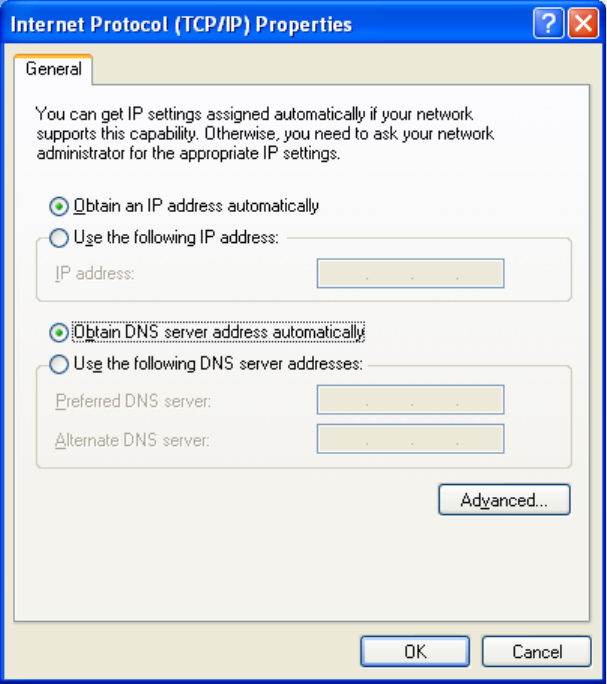
Viking VM600 Mobile Radio Operating Manual 9-19
Data Features
Figure 9.17 Internet Protocol (TCP/IP) Properties Screen
20 Click OK. The Radio Properties screen returns (Figure 9.18).
21 Click Cancel. The configuration of the connection between the radio and the portable
computer is complete.
Draft 4/29/2014
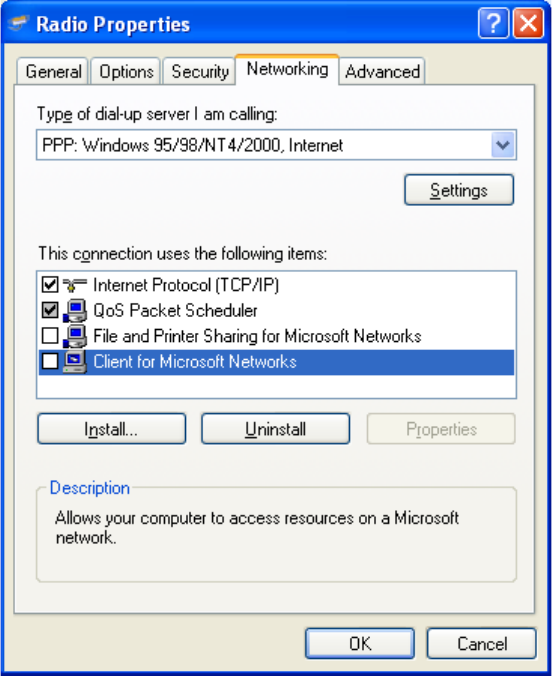
9-20 Viking VM600 Mobile Radio Operating Manual
Data Features
Figure 9.18 Radio Properties Screen: Networking Tab
9.2.4.1 Connection and Testing
To connect the computer and radio and test the connection perform the instructions in the
following paragraphs.
9.2.4.1.1 Connection
To connect the computer and radio, right click on the network icon. The Connecting Radio
window (Figure 9.19) appears, and remains until the connection is made.
Draft 4/29/2014
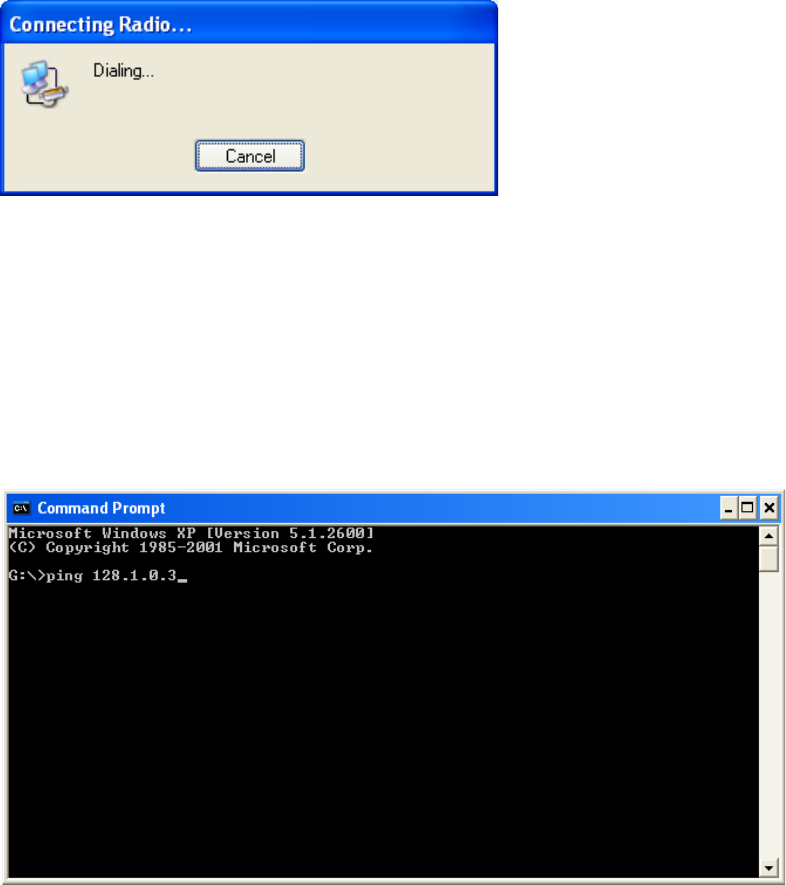
Viking VM600 Mobile Radio Operating Manual 9-21
Data Features
Figure 9.19 Radio Connection Window
9.2.4.1.2 PPP Link Test
Further verification that the link is working correctly an be made by “pinging” the
subscriber radio from the mobile computer:
1Activate the Command Prompt screen from the Accessories pull-down list of the Start
menu (see Figure 9.20).
Figure 9.20 Command Prompt Screen: Sending “Ping”
2At the prompt, type ping followed by the IP address of the radio. In the above example
the IP address 128.1.0.3 s used, and the complete entry is ping 128.1.0.3.
3Check for one or more replies to the “ping” as in the example of Figure 9.21. This
indicates that the connection is working correctly.
Draft 4/29/2014

Viking VM600 Mobile Radio Operating Manual 10-1
SECTION
Section10Tones & Error Messages
10.1 Supervisory Tones
Supervisory Tones are described as follows:
Single Beep (Alert Tone)
• Power was turned ON and a successful power-up sequence occurred (see Section 4.1.1).
• The time-out timer is about to expire or the penalty timer has expired (Section 5.3).
• The conversation timer is about to expire (Section 6.6).
• The system received your page but the paged radio is not on the air (Section 7.6).
• Telephone interconnect is not operational (Section 7.5).
Continuous Tone (Invalid Condition)
• A transmission is being attempted on a conventional channel programmed as receive-
only.
• The transmitter is disabled by the transmit disable on busy feature (Section 6.3).
• The transmitter has been disabled by the time-out timer feature (Section 5.3).
• The transmitter has been disabled by the conversation timer (Section 6.6).
• An out-of-range condition exists (SMARTNET/SmartZone only).
• A transmission is being attempted before the penalty timer has expired (Section 5.3).
Draft 4/29/2014
10-2 Viking VM600 Mobile Radio Operating Manual
Tones & Error Messages
• Dynamic regrouping has been exited but the dynamic regrouping channel is still
selected (Section 7.12).
Single Short Medium-Pitch Tone
• A valid key has been pressed.
Single Short Low-Pitch Tone
• An invalid key has been pressed.
Medium Tone (No Acknowledge)
• The paged radio did not acknowledge the page (Section 7.6).
• The message that was sent has not been acknowledged (Section 7.7).
• The status condition that was sent has not been acknowledged (Section 7.8).
Five Beeps (Recurring)
• The page was received (Section 7.6).
Two Short Tones
• A unit-to-unit call was received (Section 7.6).
Five Beeps
• The paged radio received the page and acknowledged it (Section 7.6).
• The message that was sent has been received and acknowledged (Section 7.7).
• The status condition that was sent has been received and acknowledged (Section 7.8).
Four Beeps
• The emergency alarm condition was acknowledged (Section 7.9).
• Four low beeps indicate the call back mode (the system is no longer busy).
Draft 4/29/2014

Viking VM600 Mobile Radio Operating Manual 10-3
Tones & Error Messages
Alternating Tone
• Dynamic regrouping has occurred (Section 7.12).
• Dynamic regrouping has occurred but the regrouping channel is not selected (Section
7.12).
Busy Signal
• The radio system is busy or a busy condition exists when making a telephone call.
Three Medium Pitch Tones
• A channel is available after a busy condition occurred (SMARTNET/SmartZone only).
10.2 Error Messages
The following are definitions of the various error messages that may be displayed.
Aff Failed - A group affiliation attempt has received a FAILED response from the system.
The precise reason for a FAILED response is manufacturer dependent.
Aff Deny - A group affiliation attempt has received a DENIED response from the system.
The precise reason for a DENIED response is manufacturer dependent. One common
cause is that the group is disallowed on the site/RFSS that the radio is attempting to
affiliate on.
Aff Refusd - A group affiliation attempt has received a REFUSED response from the
system. The precise reason for a REFUSED response is manufacturer dependent.
Answr Only - The user has attempted to initiate a private call or interconnect call and the
feature is programmed for answer only.
Attach GPS - This error indicates that the user has tried to enter GPS mode without
attaching the GPS receiver to the radio.
Bad Band - A profile/or user parameters have been downloaded with Armada that are for
a band different from the hardware of the radio.
Bad ESN -The ESN of the radio is not valid. This error is usually only seen in the factory
when first programming brand new logic boards.
Draft 4/29/2014
10-4 Viking VM600 Mobile Radio Operating Manual
Tones & Error Messages
Bad Fl Fmt - A profile/or user parameters have been downloaded to the radio that do not
match the file format supported by the firmware/software in the radio.This message may
appear on initial power up following a firmware upgrade. In such cases the message can be
cleared by doing a read/write of parameters using PCC version 2.6.x or later.
Bad Hrdwar - The software was loaded on the wrong platform. The boot loader version
does not match the expected boot loader version. I.e., the frequency band from the ESN
may not match the RF deck frequency band.
Batt Low - The battery voltage has been detected as being low.
Busy - A call has been attempted and the system has responded that no channels are
available for assignment.
Busy Tmout - The radio previously received a busy response from the system and it has
not received a channel grant before the busy time-out timer has expired.
Disabled - The selected channel is disabled.
Clear Only - The selected channel or group is strapped clear only and that a secure call
can not be made.
Corupt Prm - The parameters checksum is correct, but an error exists in the parameters
file.
Cycle Power - This error replaces the previous RX Back End Fail error. It occurs when
the radio has a communication failure with the RF Deck. This error only occurs with the X
and ES radio platforms.
Denied - A group call attempt has received a DENIED response from the system.
Deny - A unit or interconnect call attempt has received a DENIED response from the
system.
Disabled - The feature that the user is attempting to use has been disabled on the radio
either by programming or by factory options.
DSP Failed - The main processor and the DSP have failed to complete their startup
procedure at powerup.
EEPRM Fail - The main processor has timed out while trying to validate or invalidate the
profile/user parameters in the EEPROM.
Encryp Bad - The main processor and the Encryption Module have failed to complete
their startup procedure at power up.
Fixed High - The selected channel or group is strapped to high power and thus low power
can not be selected.
Draft 4/29/2014
Viking VM600 Mobile Radio Operating Manual 10-5
Tones & Error Messages
Fixed Low - The selected channel or group is strapped to low power and thus high power
can not be selected.
HC08 Fail - The HC08 was not initialized correctly and cannot be accessed for flash reads
and writes, tone generations, etc. Applicable to ES series radios only.
Hot - The radio has passed the "Hot" temperature threshold and will only transmit in low
power.
Invalid - The received input from the user does not fit the criteria necessary for the
feature.
Invalid ID - The received ID from the user was not a valid ID.
Invald Key - The key pressed by the user was not valid for the current situation.
Invalid TG - This error indicates that the talkgroup entered into the radio by the user is
invalid.
Invld User - This error indicates that the user’s radio ID was rejected by the system. This
message is primarily related to data registrations.
Invld Ch - The channel entered by the user in keypad programming is not valid.
Key Fail - The encryption key required by the current selected group/channel is not valid.
Kypd Lockd - The keypad lock function is active and key presses are not accepted in this
mode.
Kset Fail - The encryption key set chosen by the user is not valid.
List Only - Direct entry of a unit ID or phone number is disabled.
Locked - A selector lock command has been received and zone and channel changes are
not accepted.
Lost Signl - Signal from the infrastructure has been lost during an interconnect call.
Low Power - This error indicates that the current channel is strapped to low power and
that the user can not select high power at this time.
Msg Failed - No acknowledgement was received while sending a status report.
Narrow - The current conventional channel is programmed as a narrow channel.
No Ack - The radio did not receive an ACK for the current signaling attempt.
No Edit - The current list is not able to be edited.
No Encrypt - Encryption is not available for the selected channel.
Draft 4/29/2014
10-6 Viking VM600 Mobile Radio Operating Manual
Tones & Error Messages
No Items - The menu the user tried to access does not have any items.
No List - No list is available for the selected channel.
No Message - No message is programmed for transmission.
No Reply - Radio cloning failed due to no response.
No Sat Rec - The user has a tried to enter GPS mode but the receiver does not have a
satellite lock.
No Service - OTAR service is not available.
No Site - No site with a verified ID is yet on the dynamic site list.
No Keys - No keys are available for the key select function.
Out Of Rng - This error indicates no control channel has been found for trunking
operation.
Parms Fail - The checksum of the profile / user parameters does not match the calculated
checksum. This indicates that there is an error in the parameters file. This message only
occurs if the redundant copy of the parameters is also corrupt or is unable to be used.
Rekey Fail - This error indicates a failure in a rekeying process.
Rx Only - The selected channel is Rx only.
Sts Failed - No acknowledgement was received while sending a status report.
Timeout - A time out has occurred in attempting the current function.
Too Hot - The radio has passed the TOO HOT temperature threshold. Under these
conditions the radio will not allow Tx.
Tx Timeout - The Tx time-out timer has expired and Tx has been terminated.
VOLTAGE HI - The input voltage to the radio is too high.
VOLTAGE LO - The input voltage to the radio is too low.
Write Fail - The radio is unable to write to the EEPROM.
Zone Fail - The radio has been programmed with more zones than its options allow.
Reg Failed - This error indicates that the radio was unable to complete data registration on
the system.
Draft 4/29/2014

Viking VM600 Mobile Radio Operating Manual 11-1
SECTION
Section11Service Information
This section describes how to obtain authorized service for the Viking VM600 Series
mobile radio.
11.1 Product Warranty
The warranty statement for this equipment is available from your product supplier or
from:
Warranty Department
EFJohnson Technologies
8050 Jetstar # 175
Irving, TX 75063
This information may also be requested from the Warranty Department by phone at the
numbers listed in Section 11.2. The Warranty Department may also be contacted for
warranty service reports, claim forms, or any other questions concerning warranties or
warranty service.
11.1.1 Online Registration
EFJohnson Technologies offers greater convenience through online product warranty
registration. Registering EFJohnson Technologies products online allows customers to
receive warranty service and field service notices more quickly.
To register EFJohnson Technologies products online, visit
www.EFJohnsonTechnologies.com. Click the link for Service & Support, then follow the
instructions for Warranty Registration.
Draft 4/29/2014

11-2 Viking VM600 Mobile Radio Operating Manual
Service Information
11.2 Telephone Technical Support
Technical support personnel can help resolve many issues over the telephone, such as
display, volume, software, programming. The Customer Service Department can be
reached using the following telephone numbers:
Toll-Free: (800) 328-3911 (all except Multi-Net)
(800) 295-1773 (Multi-Net only)
Fax: (972) 819-0639
E-Mail: customerservice@efji.com
11.2.1 BEFORE Contacting Technical Support
It will be more efficient if you have critical information on hand before contacting
customer support. Be sure to have the following:
- Any necessary equipment model numbers and configuration options.
- Description of the problem/symptoms
- Description of any troubleshooting actions performed.
11.3 Factory Customer Service
The EFJohnson Technologies Customer Service Department provides customer assistance
on technical problems and the availability of local and factory repair facilities. Regular
customer service hours are 8:00 a.m. - 5:00 p.m. Central Time, Monday- Friday. A
technical support subscription service is available or support can be purchased on an as-
needed basis. The Customer Service Department can be reached using the following
telephone numbers:
Toll-Free: (800) 328-3911 (all except Multi-Net)
(800) 295-1773 (Multi-Net only)
Fax: (972) 819-0639
E-Mail: customerservice@efji.com
You can also e-mail a person directly if you know their first initial/last name. For example,
if John Smith is an EFJohnson Technologies employee, then his e-mail address is probably
jsmith@efji.com.
Note Emergency 24-hour technical support is also available at the preceding numbers during
off hours, holidays, and weekends.
Draft 4/29/2014

Viking VM600 Mobile Radio Operating Manual 11-3
Service Information
When your call is answered at EFJohnson Technologies, you will hear a brief message
informing you of numbers that can be entered to reach various departments. This number
may be entered during or after the message using a tone-type telephone. If you have a
pulse-type telephone, wait until the message is finished and an operator will come on the
line to assist you. When you enter some numbers, another number is requested to further
categorize the type of information you need.
You may also contact the Customer Service Department by mail. Please include all
information that may be helpful in solving your problem. The mailing address is as
follows:
Customer Service Department
EFJohnson Technologies
8050 Jetstar # 175
Irving, TX 75063
11.4 Returns for Repairs
Before returning equipment for repair, contact the EFJohnson Technologies Customer
Service Department as described in the preceding section. They may be able to suggest a
solution to the problem, making return of the equipment unnecessary.
Repair service is normally available through local authorized EFJohnson Technologies
land mobile radio service centers. If local service is not available, the equipment can be
returned to the EFJohnson Technologies repair depot for repair. However, before
returning equipment, contact the Customer Service Department Repair Depot for the
correct Ship To” address.
Be sure to fill out a Factory Repair Request Form #271 for each unit to be repaired,
whether it is in or out of warranty. You can obtain it in any of three ways:
• Download it from the EFJohnson Technologies Web site’s Service & Support” section.
• Call the EFJohnson Technologies Customer Service Department and request it.
• Request it when you send a unit in for repair.
Clearly describe the difficulty experienced in the space provided and also note any prior
physical damage to the equipment. Include this form in the shipping container with each
unit. Your telephone number and contact name are important as there are times when the
technicians may have specific questions that need to be answered to completely identify
and repair a problem.
When returning equipment for repair, it is also recommended that you use a PO number or
some other reference number on your paperwork in case you need to call the repair lab
about your unit. These numbers are referenced on the repair order and make it easier and
faster to locate your unit in the lab.
Draft 4/29/2014

11-4 Viking VM600 Mobile Radio Operating Manual
Service Information
Return Authorization (RA) numbers are not necessary unless you have been given one by
the Field Service Department. RA numbers are required for exchange units or if the Field
Service Department wants to be aware of a specific problem. If you have been given an
RA number, reference this number on the Factory Repair Request Form sent with the unit.
The repair lab will then contact the Field Service Department when the unit arrives. For
additional information on factory service, the Depot Service Department can be contacted
at the following e-mail address:
depotrepair@efji.com
11.5 Replacement Parts
Replacement parts can be ordered directly from the Service Parts Department. To order
parts by phone, dial the toll-free number as described in Section 11.3. When ordering,
please supply the part number and quantity of each part ordered. EFJohnson Technologies
dealers also need to give their account number. If there is uncertainty about the part
number, include the designator (C512, for example) and the model number of the
equipment the part is from.
You may also send your order by mail or fax. The mailing address is as follows and the fax
number is shown in Section 11.2.
Service Parts Department
EFJohnson Technologies
8050 Jetstar # 175
Irving, TX 75063
11.6 Internet Home Page
EFJohnson Technologies has a site on the World Wide Web that can be accessed for
information on the company about such things as products, systems, and regulations. The
address is
http://www.EFJohnsonTechnologies.com
Draft 4/29/2014
Viking VM600 Mobile Radio Operating Manual Index-1
Index
- A -
AES Encryption . . . . . . . . . . . . . . . . . . . . . . . . . . . . . . . . 8-2
Algorithm . . . . . . . . . . . . . . . . . . . . . . . . . . . . . . . . . . . . 8-12
Algorithm ID . . . . . . . . . . . . . . . . . . . . . . . . . . . . . . . . . . 8-12
Alphanumeric Display . . . . . . . . . . . . . . . . . . . . . . . . . . . 2-3
Analog and Digital Operation . . . . . . . . . . . . . . . . . . . . . . 7-1
ANI Signaling . . . . . . . . . . . . . . . . . . . . . . . . . . . . . . . . . 6-14
Autodetect . . . . . . . . . . . . . . . . . . . . . . . . . . . . . . . . . . . . 8-6
- B -
Backlight . . . . . . . . . . . . . . . . . . . . . . . . . . . . . . . . . . . . . 4-5
Battery Discharge . . . . . . . . . . . . . . . . . . . . . . . . . . . . . 4-11
Black . . . . . . . . . . . . . . . . . . . . . . . . . . . . . . . . . . . . . . . 8-13
Busy Channel Lockout . . . . . . . . . . . . . . . . . . . . . . 6-3, 6-14
Busy Indicator . . . . . . . . . . . . . . . . . . . . . . . . . . . . . . . . . 6-2
Busy Override . . . . . . . . . . . . . . . . . . . . . . . . . . . . . . . . 7-19
- C -
Call Alert (P25 Conv) . . . . . . . . . . . . . . . . . . . . . . . . . . . 6-20
Call Alert (Paging) . . . . . . . . . . . . . . . . . . . . . . . . . . . . . . 7-9
Call Guard Squelch . . . . . . . . . . . . . . . . . . . . . . . . . . . . . 6-3
CHAN PARMS . . . . . . . . . . . . . . . . . . . . . . . . . . . . . . . . 6-23
Channel . . . . . . . . . . . . . . . . . . . . . . . . . . . . . . .2-3, 4-6, 4-7
Channels . . . . . . . . . . . . . . . . . . . . . . . . . . . . . . . . . . . . 4-15
CHNG CHAN . . . . . . . . . . . . . . . . . . . . . . . . . . . . . . . . . 6-23
CHNG ZONE . . . . . . . . . . . . . . . . . . . . . . . . . . . . . . . . . 6-23
CKEK . . . . . . . . . . . . . . . . . . . . . . . . . . . . . . . . . . . . . . . 8-13
CKR . . . . . . . . . . . . . . . . . . . . . . . . . . . . . . . . . . . . . . . . 8-13
Clear/Secure Strapping . . . . . . . . . . . . . . . . . . . . . . . . . . 8-5
Connector
Accessory . . . . . . . . . . . . . . . . . . . . . . . . . . . . . . . .2-10
Antenna . . . . . . . . . . . . . . . . . . . . . . . . . . . . . . . . .2-10
DC Power . . . . . . . . . . . . . . . . . . . . . . . . . . . . . . . .2-10
Conventional Mode . . . . . . . . . . . . . . . . . . . . . . . . . . . . 4-13
Conversation Timer . . . . . . . . . . . . . . . . . . . . . . . . . . . . . 6-6
Crypto Group . . . . . . . . . . . . . . . . . . . . . . . . . . . . . . . . . 8-13
Crytpto Graphic Variable . . . . . . . . . . . . . . . . . . . . . . . . 8-13
- D -
DES-OFB . . . . . . . . . . . . . . . . . . . . . . . . . . . . . . . . . . . . . 8-1
Digital Call Guard Squelch . . . . . . . . . . . . . . . . . . . . . . . 6-4
Digital Unit ID, Project 25
Unit ID, Project 25 . . . . . . . . . . . . . . . . . . . . . . . . .6-16
Direct Channel Selection . . . . . . . . . . . . . . . . . . . . . . . . . 4-8
Display . . . . . . . . . . . . . . . . . . . . . . . . . . . . . . . . . . . . . . . 2-3
Zone/Channel . . . . . . . . . . . . . . . . . . . . . . . . . . . . . .4-6
Display View Angle Adjust . . . . . . . . . . . . . . . . . . . . . . . . 4-5
Displaying Frequency . . . . . . . . . . . . . . . . . . . . . . . . . . . 6-7
Dynamic Regrouping . . . . . . . . . . . . . . . . . . . . . . . . . . . 7-18
- E -
Emergency Alarms (Conv) . . . . . . . . . . . . . . . . . . . . . . . 6-8
Emergency Alarms (SN/SZ) . . . . . . . . . . . . . . . . . . . . . 7-12
Emergency Calls . . . . . . . . . . . . . . . . . . . . . . . . . . . . . . 7-13
Emergency Calls (Conv) . . . . . . . . . . . . . . . . . . . . . . . . . 6-9
Emergency Hot Mic . . . . . . . . . . . . . . . . . . . . . . . . 6-9, 7-14
Encryption . . . . . . . . . . . . . . . . . . . . . . . . . . . . . . . . . . . . 8-1
Encryption Key . . . . . . . . . . . . . . . . . . . . . . . . . . . . . . . . 8-2
Encryption Key Select . . . . . . . . . . . . . . . . . . . . . . . . . . . 8-4
Encryption Keys . . . . . . . . . . . . . . . . . . . . . . . . . . . . . . . . 8-2
Encryption KY CLR (Key Erase) . . . . . . . . . . . . . . . . . . . 8-5
Enh. Priv. Conversation Calls
Placing . . . . . . . . . . . . . . . . . . . . . . . . . . . . . . . . . . .7-5
Receiving . . . . . . . . . . . . . . . . . . . . . . . . . . . . . . . . .7-7
Extended Range Operation . . . . . . . . . . . . . . . . . . . . . . 4-10
- F -
Facility . . . . . . . . . . . . . . . . . . . . . . . . . . . . . . . . . . . . . . 8-11
Failsoft Operation . . . . . . . . . . . . . . . . . . . . . . . . . . . . . 7-15
Features
Project 25 . . . . . . . . . . . . . . . . . . . . . . . . . . . . . . . .6-16
SMARTNET/SmartZone . . . . . . . . . . . . . . . . . . . . . .7-1
SmartZone . . . . . . . . . . . . . . . . . . . . . . . . . . .7-19, 9-2
FIPS 140-2 . . . . . . . . . . . . . . . . . . . . . . . . . . . . . . . . . . . 8-2
Five Tone Encoder . . . . . . . . . . . . . . . . . . . . . . . . . . . . 6-15
- H -
Home Zone Select . . . . . . . . . . . . . . . . . . . . . . . . . . . . . . 5-4
Horn Alert . . . . . . . . . . . . . . . . . . . . . . . . . . . . . . . . . . . . 5-6
Hot Mic . . . . . . . . . . . . . . . . . . . . . . . . . . . . . . . . . 6-9, 7-14
- I -
Indicator
Priority Channel . . . . . . . . . . . . . . . . . . . . . . . . . . .6-12
Infinite Key Retention . . . . . . . . . . . . . . . . . . . . . . . . . . . 8-4
- K -
KEK . . . . . . . . . . . . . . . . . . . . . . . . . . . . . . . . . . . . . . . . 8-13
Key . . . . . . . . . . . . . . . . . . . . . . . . . . . . . . . . . . . . . . . . 8-13
Key Encryption Key . . . . . . . . . . . . . . . . . . . . . . . . . . . . 8-10
Key ID . . . . . . . . . . . . . . . . . . . . . . . . . . . . . . . . . . 8-3, 8-13
Key Loader . . . . . . . . . . . . . . . . . . . . . . . . . . . . . . . . . . 8-14
Key Management Facility . . . . . . . . . . . . . . . . . . . . . . . 8-11
Keypad Programming . . . . . . . . . . . . . . . . . . . . . . . . . . 6-23
Keyset Changeover . . . . . . . . . . . . . . . . . . . . . . . . . . . . 8-14
KMF . . . . . . . . . . . . . . . . . . . . . . . . . . . . . . . . . . . . . . . . 8-13
KMF RSI . . . . . . . . . . . . . . . . . . . . . . . . . . . . . . . . . . . . 8-16
KMM . . . . . . . . . . . . . . . . . . . . . . . . . . . . . . . . . . . . . . . 8-13
Draft 4/29/2014
Index-2 Viking VM600 Mobile Radio Operating Manual
Index (continued)
- L -
Licensing . . . . . . . . . . . . . . . . . . . . . . . . . . . . . . . . . . . . . 1-4
Lookback Time . . . . . . . . . . . . . . . . . . . . . . . . . . . . . . . 6-12
Lost Passwords . . . . . . . . . . . . . . . . . . . . . . . . . . . . . . . . 4-3
- M -
Message Number Period . . . . . . . . . . . . . . . . . . . . . . . . 8-14
Message Number Period (MNP) . . . . . . . . . . . . . . . . . . 8-12
Messaging . . . . . . . . . . . . . . . . . . . . . . . . . . . . . . . . . . . 7-11
Messaging (Conv P25) . . . . . . . . . . . . . . . . . . . . . . . . . 6-22
Microphone Off-Hook . . . . . . . . . . . . . . . . . . . . . . . . . . . 5-6
Mode
Conventional . . . . . . . . . . . . . . . . . . . . . . . . . . . . . .4-13
Project 25 Conv . . . . . . . . . . . . . . . . . . . . . . . . . . .4-13
Project 25 Trunked . . . . . . . . . . . . . . . . . . . . . . . . .4-14
SMARTNET/SmartZone . . . . . . . . . . . . . . . . . . . . .4-13
Monitor Mode . . . . . . . . . . . . . . . . . . . . . . . . . . . . . . . . . . 6-2
Monitoring Before Transmitting . . . . . . . . . . . . . . . . . . . . 6-1
Multi-function Indicator . . . . . . . . . . . . . . . . . . . . . . . . . . 2-2
- N -
NAC . . . . . . . . . . . . . . . . . . . . . . . . . . . . . . . . . . . . . . . . 6-16
Network Access Code . . . . . . . . . . . . . . . . . . . . . . . . . . 6-16
Nuisance Channel Delete . . . . . . . . . . . . . . . . . . . . . . . 5-10
- O -
On-Off/Volume Control . . . . . . . . . . . . . . . . . . . . . . . . . . 2-2
Operating Modes . . . . . . . . . . . . . . . . . . . . . . . . . . . . . . 4-13
Option Button
KY SEL (Key Select) . . . . . . . . . . . . . . . . . . . . . . . .8-4
Option Switch
ALERT (Call Alert) . . . . . . . . . . . . . . . . . . . . 6-21, 7-10
BKLHT (Backlight) . . . . . . . . . . . . . . . . . . . . . . . . . .4-5
C/S (Clear/Secure) . . . . . . . . . . . . . 7-2, 7-6, 7-7, 8-18
CALL (Private Call) . . . . . . . . 6-20, 7-5, 7-6, 7-7, 7-10
CALL (Unit Call) . . . . . . . . . . . . . . . . . . . . . . . . . . .6-18
Cancel Dynamic Regrouping . . . . . . . . . . . . . . . . .7-18
Channel Select . . . . . . . . . . . . . . . . . . . . . . . . . . . . .4-8
DATA (P25 Packet Data) . . . . . . . . . . . . . . . . . . . . .9-1
DISP (Displayed Information) . . . . . . . . . . . . . . . . . .6-7
EMER (Emergency) . . . . . . . . . . . . . . . 6-8, 6-10, 7-14
Emergency . . . . . . . . . . . . . . . . . . . . . . . . . . . . . . .7-12
HOME (Zone) . . . . . . . . . . . . . . . . . . . . . . . . . . . . . .5-4
Home2 . . . . . . . . . . . . . . . . . . . . . . . . . . . . . . . . . . .5-4
HORN . . . . . . . . . . . . . . . . . . . . . . . . . . . . . . . . . . . .5-6
KY CHG (Keyset Change) . . . . . . . . . . . . . . . . . . .8-17
KY CLR (Erase Keys) . . . . . . . . . . . . . . . . . . . . . . .8-18
KY SEL (Key Select) . . . . . . . . . . . . . . . . . . . . . . .8-18
LOCK (Site Lock) . . . . . . . . . . . . . . . . . . . . . . . . . .7-20
MON (Monitor) . . . . . . . . . . . . . . . . . . . . . . . . . . . . .6-2
MSG (Message) . . . . . . . . . . . . . . . . . . . . . . . . . . .6-22
OTAR (Rekey Request) . . . . . . . . . . . . . . . . . . . . .8-18
PHONE . . . . . . . . . . . . . . . . . . . . . . . . . . 6-19, 7-8, 7-9
Priority (Priority Edit) . . . . . . . . . . . . . . . . . . . . . . . 6-13
Private Call . . . . . . . . . . . . . . . . . . . . . . . . . . . . . . . . 7-6
Private Call (SmartNet) . . . . . . . . . . . . . . . . . . . . . . 7-5
PUB AD (Public Address) . . . . . . . . . . . . . . . . . . . . 5-7
PW CHG (Set User Password) . . . . . . . . . . . . . . . . 4-3
RESP (Call Response) . . . . . . . . . . . . . . . . . . . . . . 7-7
RTA (Repeater Talk-Around) . . . . . . . . . . . . . . . . . . 6-7
RWS (Radio Wide Scan) . . . . . . . . . . . . . . . . . . . . . 5-9
RWS ED (RW Scan List Edit) . . . . . . . . . . . . . . . . 5-13
SCAN . . . . . . . . . . . . . . . . . . . . . . . . . . . . . . . 5-8, 5-10
SCN ED (Scan Edit) . . . . . . . . . . . . . . . . . . . . . . . . 5-12
SEARCH (Site Search) . . . . . . . . . . . . . . . . . . . . . 7-20
SEL SQ (Normal/Selective) . . . . . . . . . . . . . . . . . . . 6-4
Site Search . . . . . . . . . . . . . . . . . . . . . . . . . . . . . . 7-20
SN LIST (Scan List Select) . . . . . . . . . . . . . . . . . . 7-17
SQ LIST (Squelch Select List) . . . . . . . . . . . . . . . . . 6-5
STATUS . . . . . . . . . . . . . . . . . . . . . . . . . . . . 6-22, 7-11
SURVLC (Surveillance) . . . . . . . . . . . . . . . . . . . . . . 5-7
TG SEL (Talk Group Select) . . . . . . . . . . . . . . . . . 6-17
TN VOL (Tone Volume) . . . . . . . . . . . . . . . . . . . . . . 5-5
TONE (Alert) . . . . . . . . . . . . . . . . . . . . . . . . . . . . . . 5-5
TX PWR (Transmit Power) . . . . . . . . . . . . . . . . . . . 5-4
Option Switch/Menu Parameter Table . . . . . . . . . . . . . . 5-2
Option Switches . . . . . . . . . . . . . . . . . . . . . . . . . . . .2-2, 5-1
Option Upgrading . . . . . . . . . . . . . . . . . . . . . . . . . . . . . . 1-4
Optional Features . . . . . . . . . . . . . . . . . . . . . . . . . . . . . . 1-3
OTAR . . . . . . . . . . . . . . . . . . . . . . . . . . . . . . . . . . . . . . 8-14
OTAR capabilities . . . . . . . . . . . . . . . . . . . . . . . . . . . . . 8-16
OTAR Definitions . . . . . . . . . . . . . . . . . . . . . . . . . . . . . 8-10
OTAR Messages Supported . . . . . . . . . . . . . . . . . . . . . 8-17
- P -
P25 Group calls . . . . . . . . . . . . . . . . . . . . . . . . . . . . . . 6-17
P25 Packet Data . . . . . . . . . . . . . . . . . . . . . . . . . . . . . . . 9-1
P25 PTT ID . . . . . . . . . . . . . . . . . . . . . . . . . . . . . . . . . . 6-17
P25 Talk Group . . . . . . . . . . . . . . . . . . . . . . . . . . . . . . . 6-17
Paging . . . . . . . . . . . . . . . . . . . . . . . . . . . . . . . . . . .6-20, 7-9
Answering . . . . . . . . . . . . . . . . . . . . . . . . . . . . . . . 7-10
Answering (Conv P25) . . . . . . . . . . . . . . . . . . . . . . 6-20
Initiating . . . . . . . . . . . . . . . . . . . . . . . . . . . . 6-21, 7-10
Password
Changing . . . . . . . . . . . . . . . . . . . . . . . . . . . . . . . . . 4-3
Download/Upload . . . . . . . . . . . . . . . . . . . . . . . . . . . 4-4
Master . . . . . . . . . . . . . . . . . . . . . . . . . . . . . . . . . . . 4-4
Power On . . . . . . . . . . . . . . . . . . . . . . . . . . . . . . . . . 4-4
Power-Up . . . . . . . . . . . . . . . . . . . . . . . . . . . . . . . . . 4-3
Zone . . . . . . . . . . . . . . . . . . . . . . . . . . . . . . . . . . . . . 4-4
Penalty Timer . . . . . . . . . . . . . . . . . . . . . . . . . . . . . . . . . 6-6
PID Mode . . . . . . . . . . . . . . . . . . . . . . . . . . . . . . . . . . . . 8-3
Power On/Off . . . . . . . . . . . . . . . . . . . . . . . . . . . . . . . . . 4-1
Power On-Off . . . . . . . . . . . . . . . . . . . . . . . . . . . . . . . . . 4-1
Power Output Select . . . . . . . . . . . . . . . . . . . . . . . . . . . . 5-4
Power Turn-Off Delay . . . . . . . . . . . . . . . . . . . . . . . . . . . 5-5
Draft 4/29/2014
Viking VM600 Mobile Radio Operating Manual Index-3
Index (continued)
Power-Up Password . . . . . . . . . . . . . . . . . . . . . . . . . . . . 4-3
Priority Calls
Conv . . . . . . . . . . . . . . . . . . . . . . . . . . . . . . . . . . . .6-11
Priority Channel
Changing . . . . . . . . . . . . . . . . . . . . . . . . . . . . . . . .6-12
Priority Sampling
P25 Trunked . . . . . . . . . . . . . . . . . . . . . . . . . . . . . .7-17
SMARTNET/SmartZone . . . . . . . . . . . . . . . . . . . . .7-17
Priv. Conversation II Calls
Placing . . . . . . . . . . . . . . . . . . . . . . . . . . . . . . . . . . .7-6
Receiving . . . . . . . . . . . . . . . . . . . . . . . . . . . . . . . . .7-7
Private (Unit-To-Unit) Calls . . . . . . . . . . . . . . . . . . . . . . . 7-4
Project 25 Mode . . . . . . . . . . . . . . . . . . . . . . . . . . . . . . 4-14
PTT ID . . . . . . . . . . . . . . . . . . . . . . . . . . . . . . . . . . . . . . . 7-4
Public Address . . . . . . . . . . . . . . . . . . . . . . . . . . . . . . . . . 5-7
- R -
Radio Info . . . . . . . . . . . . . . . . . . . . . . . . . . . . . . . . . . . . 7-2
Radio Set Identifier . . . . . . . . . . . . . . . . . . . . . . . . . . . . 8-14
Radio Set Up (OTAP) . . . . . . . . . . . . . . . . . . . . . . . . . . 5-15
Radio Wide Scanning . . . . . . . . . . . . . . . . . . . . . . . . . . . 5-9
Receive Only . . . . . . . . . . . . . . . . . . . . . . . . . . . . . . . . . 4-10
Red . . . . . . . . . . . . . . . . . . . . . . . . . . . . . . . . . . . . . . . . 8-14
Rekey . . . . . . . . . . . . . . . . . . . . . . . . . . . . . . . . . . . . . . 8-14
Repeater Talk-Around . . . . . . . . . . . . . . . . . . . . . . . . . . . 6-7
RS-232 Port . . . . . . . . . . . . . . . . . . . . . . . . . . . . . . . . . . . 9-1
RSI . . . . . . . . . . . . . . . . . . . . . . . . . . . . . . . . . . . 8-14, 8-16
RW Scan List
Determining Channels in . . . . . . . . . . . . . . . . . . . .5-13
Editing . . . . . . . . . . . . . . . . . . . . . . . . . . . . . . . . . . .5-13
- S -
Scan List . . . . . . . . . . . . . . . . . . . . . . . . . . . . . . . . . . . . . 5-9
Conventional Mode . . . . . . . . . . . . . . . . . . . . . . . . .6-10
Editing . . . . . . . . . . . . . . . . . . . . . . . . . . . . . . . . . . .5-12
Radio Wide Scan Mode . . . . . . . . . . . . . . . . . . . . .5-13
Selecting . . . . . . . . . . . . . . . . . . . . . . . . . . . . . . . . . 5-11
Standard Scan Mode . . . . . . . . . . . . . . . . . . . . . . . 5-11
Scanning
Conventional . . . . . . . . . . . . . . . . . . . . . . . . . . . . . .6-10
Radio Wide . . . . . . . . . . . . . . . . . . . . . . . . . . . . . . . .5-9
SMARTNET . . . . . . . . . . . . . . . . . . . . . . . . . . . . . .7-15
Standard . . . . . . . . . . . . . . . . . . . . . . . . . . . . . . . . . .5-8
SecureNet . . . . . . . . . . . . . . . . . . . . . . . . . . . . . . . . . . . . 8-1
Select Switch . . . . . . . . . . . . . . . . . . . . . . . . . . . . . . . . . . 2-2
Servicing . . . . . . . . . . . . . . . . . . . . . . . . . . . . . . . . . . . . 4-12
Silent Mode . . . . . . . . . . . . . . . . . . . . . . . . . . . . . . . . . . . 6-8
Site Locking/Unlocking . . . . . . . . . . . . . . . . . . . . . . . . .7-20
Searching for . . . . . . . . . . . . . . . . . . . . . . . . . . . . .7-20
Site ID (SmartZone) . . . . . . . . . . . . . . . . . . . . . . . . . . . . 7-20
Site Trunking . . . . . . . . . . . . . . . . . . . . . . . . . . . . . . . . . 7-19
SLN Mode . . . . . . . . . . . . . . . . . . . . . . . . . . . . . . . . . . . . 8-3
SMARTNET/SmartZone Mode . . . . . . . . . . . . . . . . . . . 4-13
Soft Power Down . . . . . . . . . . . . . . . . . . . . . . . . . . . . . . 4-2
Speaker . . . . . . . . . . . . . . . . . . . . . . . . . . . . . . . . . . . . . 2-2
Speaking Into Microphone . . . . . . . . . . . . . . . . . . . . . . . 4-5
Squelch Adjust . . . . . . . . . . . . . . . . . . . . . . . . . . . . . . . 4-10
Squelch Code Select . . . . . . . . . . . . . . . . . . . . . . . . . . . 6-5
Squelch Control . . . . . . . . . . . . . . . . . . . . . . . . . .4-10, 6-28
Standard Calls
Placing (Conv) . . . . . . . . . . . . . . . . . . . . . . . . . . . . 6-14
Receiving (Conv) . . . . . . . . . . . . . . . . . . . . . . . . . . 6-14
Receiving (SMARTNET) . . . . . . . . . . . . . . . . . . . . . 7-4
Standard Private Conversation Mode . . . . . . . . . . . . . . . 7-4
Status Display . . . . . . . . . . . . . . . . . . . . . . . . . . . . . . . . . 2-3
Status Messages . . . . . . . . . . . . . . . . . . . . . . . . .6-22, 7-11
Supervisory Tones . . . . . . . . . . . . . . . . . . . . . . . . . . . . 10-1
Supported OTAR Messages . . . . . . . . . . . . . . . . . . . . . 8-17
Surveillance Mode . . . . . . . . . . . . . . . . . . . . . . . . . . . . . 5-7
SYS PARMS . . . . . . . . . . . . . . . . . . . . . . . . . . . . . . . . . 6-23
Systems . . . . . . . . . . . . . . . . . . . . . . . . . . . . . . . . . . . . 4-15
- T -
Talk Group IDs, Project 25 . . . . . . . . . . . . . . . . . . . . . . 6-16
TEK . . . . . . . . . . . . . . . . . . . . . . . . . . . . . . . . . . . . . . . . 8-14
Telephone Calls
Receiving (SMARTNET) . . . . . . . . . . . . . . . . . . . . . 7-9
Telephone Calls) . . . . . . . . . . . . . . . . . . . . . . . . . . . . . . 6-19
TG on Rx . . . . . . . . . . . . . . . . . . . . . . . . . . . . . . . . . . . . 7-4
Time, Scan Hold . . . . . . . . . . . . . . . . . . . . . . . . . . . . . . . 5-9
Time-Out Timer . . . . . . . . . . . . . . . . . . . . . . . . . . . . . . . . 5-4
Tone Call Guard Squelch . . . . . . . . . . . . . . . . . . . . . . . . 6-4
Tone Select . . . . . . . . . . . . . . . . . . . . . . . . . . . . . . . . . . . 5-5
Tones . . . . . . . . . . . . . . . . . . . . . . . . . . . . . . . . . . . . . . 10-1
Traffic Encryption Key . . . . . . . . . . . . . . . . . . . . . .8-10, 8-14
Transmit Disable . . . . . . . . . . . . . . . . . . . . . . . . . . . . . . 4-10
Transmit Type . . . . . . . . . . . . . . . . . . . . . . . . . . . . . . . . 6-28
Transmitting, Scan Mode . . . . . . . . . . . . . . . . . . . .5-9, 6-11
Troubleshooting . . . . . . . . . . . . . . . . . . . . . . . . . . . . . . 4-12
- U -
UKEK . . . . . . . . . . . . . . . . . . . . . . . . . . . . . . . . . . . . . . 8-16
Unit Calls, Project 25 . . . . . . . . . . . . . . . . . . . . . . . . . . 6-18
Unit ID, SMARTNET/SmartZone . . . . . . . . . . . . . . . . . . 7-1
User Group ID . . . . . . . . . . . . . . . . . . . . . . . . . . . . .6-17, 7-4
- V -
Volume Level . . . . . . . . . . . . . . . . . . . . . . . . . . . . . . . . . 4-2
- Z -
Zeroize . . . . . . . . . . . . . . . . . . . . . . . . . . . . . . . . . . . . . 8-14
Zone . . . . . . . . . . . . . . . . . . . . . . . . . . . . . . . . . 2-3, 4-6, 4-7
Zone Password . . . . . . . . . . . . . . . . . . . . . . . . . . . .4-4, 6-24
Zone/Channel Select . . . . . . . . . . . . . . . . . . . . . . . . . . . 4-7
Draft 4/29/2014


